May 31 - June 6, 2015: Issue 216
Captain Francis Hixson
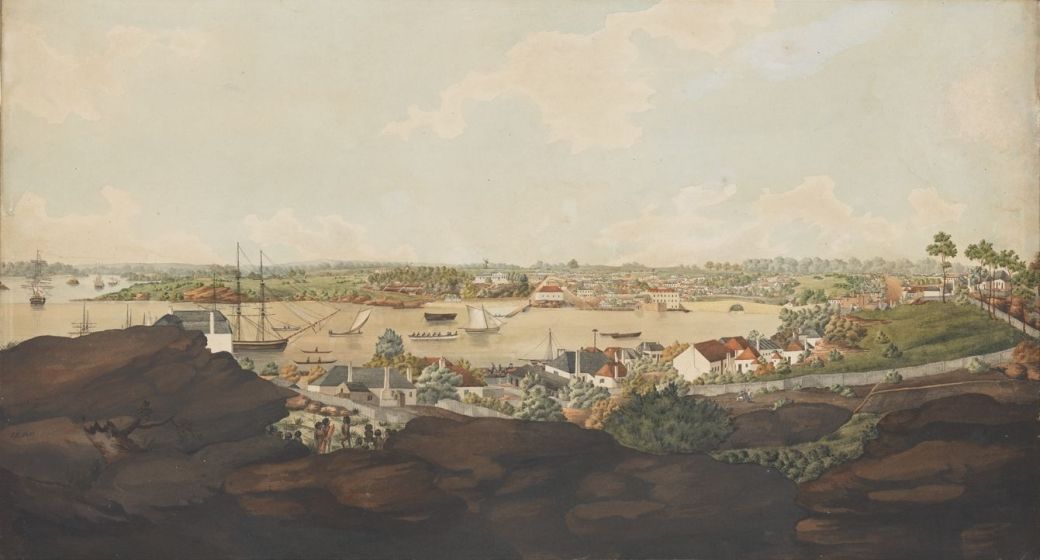
View of Sydney from the west side of the Cove, ca. 1806 / John Eyre - courtesy State Library of NSW, Image No.: a1528389
Captain Francis Hixson
8 January 1833–2 March 1909
Pioneer watermen of Broken Bay and Pittwater series - May to June 2015
If Creswell is the gentleman considered by many to have given birth to the thought of an Australian Navy, a Sydney gentleman, who conducted his first training exercises here in Pittwater and Broken Bay for the Naval Brigade, is the gentleman who gave birth to the physical reality. He is also the gentleman who was responsible for the saving of countess lives in ensuring a program for the building of lighthouses up and down our coastline became the lightships that in many case, still stand today allowing us to stand where he and their keepers stood and breathe the same air from the same outlook, even if several seasons later.
Francis Hixson was born at Swanage, Dorsetshire son of William Hixson, master mariner, and his wife Annie, née Manwell. He first visited Australia in 1848, a mere 15 year old aboard H.M.S. Havannah as a junior officer, or Master's Assistant, as the term was then - :
It must be noted that there have been great changes in the titles of the navigating officers of the navy. In the early days the titles ran master, second master, and master's assistant. Forty years ago these titles went, and we have staff commanders, and navigating lieutenants, sub-lieutenants, and midshipmen. A Naval Funeral: The Late Captain Hixson. (1909, March 10).The Sydney Mail and New South Wales Advertiser (NSW : 1871 - 1912), p. 30. Retrieved from http://nla.gov.au/nla.news-article163289271
This was followed by:
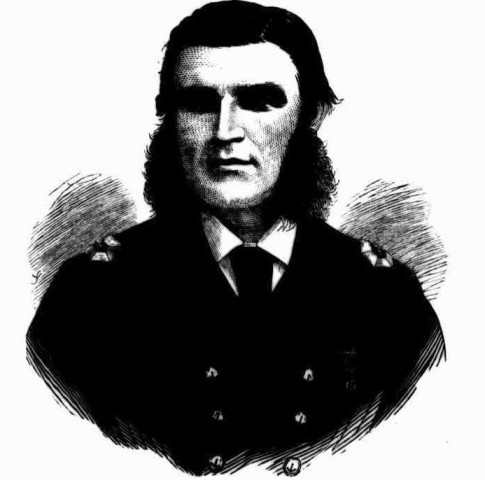 Captain Hixson.
Captain Hixson.
THE name of Captain Hixson, and the position he occupies to the advantage of this community, in connexion with the organisations for the defence of the harbour, and for the safety of the shipping navigating these coasts, and visiting ports of the colony, are familiar to the people of New South Wales. And we are sure the following particulars concerning his career will be read with interest :
Mr. Francis Hixson first came to this port as Master’s Assistant in H.M.S. Havannah, Captain John E. Erskine, R.N. After remaining four years on this station and visiting most of the principal ports in Australia and New Zealand, and many of the South Sea Islands, the Havannah was ordered to England and paid off, and Mr. Hixson was appointed, in consequence of the experience he had gained in this part of the world, to the expedition that was then being organised to survey and take possession of New Caledonia. This expedition consisted of H.M.S. Herald and Torch, under the command of Captain Sir Henry M. Denham, F.R S.
On the arrival of the ships at the field of their intended operations, however, it was discovered that the French were already in possession; and thus the object of their voyage was frustrated. The Torch was sold out of the navy but the Herald remained here many years, and performed much useful maritime work highly beneficial to the colonies. In these under-takings Mr. Hixson took a prominent part.
In the year 1857 the Humane Society awarded him their silver medal for jumping overboard to the rescue of Thomas Ross, who had accidentally fallen into the sea.
After nine years' service the Herald returned to England, and Mr. Hixson was appointed, under a joint arrangement between the Imperial and Colonial Governments, as chief assistant to Commander Sidney, R.N., in the survey of the coast of New South Wales. He continued in this service about eighteen months, and then, in January, 1863, resigned his commission as master in the Royal Navy, to take the appointment of Superintendent of Pilots, Lighthouses and Harbours, under the Government of New South Wales.
A few months afterwards he was entrusted with the duty of organising the Naval Brigade ; and he has continued to command this popular and efficient corps ever since When the Marine Board was incorporated, Captain Hixson was appointed President ; and the duties appertaining to the post of Superintendent of Pilots, Lights, and Harbours, merged into this new office. Captain Hixson is a member of the Defence Commission, and holds several other kindred posts. He is possessed of considerable scientific attainments, and on that account was chosen to establish the observatory at Goulburn for making observations on the Transit of Venus. In several other instances the Government have found Captain Hixson a discreet and energetic officer in the performance of services which have not come strictly within his particular sphere of duty. In the year 1861 Captain Hixson married Sarah, second daughter of the Hon. Francis Lord, by whom he has a numerous family. Captain Hixson. With Sktech (1877, February 24). Australian Town and Country Journal (Sydney, NSW : 1870 - 1907), p. 13. Retrieved from http://nla.gov.au/nla.news-article70599204
Yesterday's Herald says : The survey of the Australian coast, a portion of which was carried out by Captain Denham, R.N., and the cost of which is borne equally by the Imperial and Colonial Governments, is about shortly to be resumed. The survey of this portion of the coast has been entrusted to Captain Sydney, R.N. One of his officers, Mr. F. Hixson, has arrived, and yesterday had an interview with the Colonial Secretary. NEWS AND NOTES. (1861, October 1). The Courier (Brisbane, Qld. : 1861 - 1864), p. 4. Retrieved from http://nla.gov.au/nla.news-article4601338
Records state that it was on December 30th 1862 Captain Hixson accepted his appointment, a little over a year after his marriage to Sarah Lord on November 2nd, 1861:
On the 2nd instant, at St. Thomas' Church, St. Leonards, by theRev. W. B. Clarke. M.A., Mr. Francis Hixson, R.N., to Sarah, second daughter of Mr. Francis Lord, St. Leonards. Family Notices. (1861, November 7). The Sydney Morning Herald (NSW : 1842 - 1954), p. 1. Retrieved from http://nla.gov.au/nla.news-article13057009
Their first child was born just over nine months later:
Births. On the 29th instant, at her residence, William street, the wife of Francis Hixson, Esq., R.N., of a son. Family Notices. (1862, July 31).The Sydney Morning Herald(NSW : 1842 - 1954), p. 1. Retrieved from http://nla.gov.au/nla.news-article13232077 - Francis William
Even more reason to commence a career and a decade which would see him be part of opening the Sailors Home, forming the Naval Brigade and train those in it both in Sydney and at Newcastle, preceded by a few difficulties in the then Pilot board he may have, with often reported congeniality, been able to make workable and stick to his lifelong credo of saving lives:
The American schooner Bertha has been purchased by the Government for the use of the coast surveying party under Captain Sidney, R.N., and Mr. Hixson, she is now being fitted up for the service, and will leave in a few weeks for the Manning River.
The members of the Pilot Board (Captain Fox, Captain Darley, and Captain Smith) have been replaced by Captains Towns, John Vine Hall, and W. F. Norrie. The alteration was effected in a rather summary manner, and arose from a difference of opinion respecting the adaptability and value of the Sea Witch, schooner, purchased by the Government for a pilot vessel-the former board declaring unfavourably of the schooner. NOTES OF THE WEEK. (1862, April 12). The Sydney Morning Herald (NSW : 1842 - 1954), p. 5. Retrieved from http://nla.gov.au/nla.news-article13227007
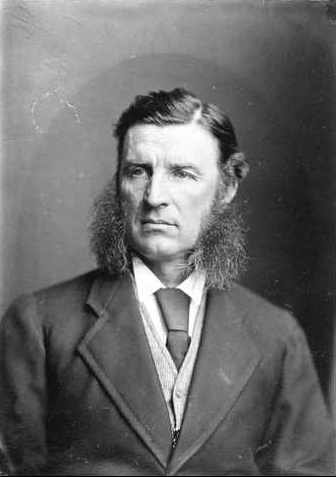 TOWN AND COUNTRY NEWS.
TOWN AND COUNTRY NEWS.
The Pilot Board. — At the meeting of the Executive Council on Tuesday, Mr. Francis Hixson, R.N., was appointed Superintendent of Pilots, Lighthouses, and Harbours. The salary attached to the office will be £660 per annum. Mr. Hixson, who has been for some months past associated with Captain Sidney in the survey of the coast of this colony, the cost of which is shared equally by the Imperial and the colonial Governments, is a Master in the Royal Navy, and a first-class Admiralty Surveyor. Mr. Hixson has been for fourteen years employed upon this coast, in H.M. ships Havannah, Torch, and Herald, and was on several occasions detached upon special colonial duties in surveying the harbours and bar harbours of this colony, before he was engaged in the present service, and is therefore well acquainted with every portion of the coast. All the duties hitherto discharged by the Pilot Board will be entrusted to Mr. Hixson, excepting that of examining and granting certificates to pilots. The Act of Parliament requires that these duties shall be discharged by the Pilot Board, and it is, we believe, in contemplation to appoint two of more of the harbour pilots for that purpose exclusively.
Picture at right courtesy State Library of South Australia, Image No.: PRG280
Sudden Death or Mr. Joseph Moffitt.— We regret to have to record the sudden decease of Mr. Moffitt, who for upwards of twenty years had been engaged as pilot at Sydney Heads, and for the last eight years as signal master at the Fort Phillip station. 'It appears that on the 25th ultimo, Mr., Moffitt complained of pains in his chest, and the following day, under the advice of his medical attendant, kept to his room, though no apprehension of anything serious was entertained until Tuesday afternoon, when he grew worse, and gradually sank beneath his sufferings, breathing his last' at six o'clock. M r. Moffitt has left a wife and a large family, and was known to an extensive circle of friend's, among whom his death will be severely felt. TOWN AND COUNTRY NEWS. (1863, January 3 - Saturday). Sydney Mail(NSW : 1860 - 1871), p. 4. Retrieved from http://nla.gov.au/nla.news-article166654243
NEW SOUTH WALES. Sydney, 14th January. Messrs Hixson, Crook, and Harold have been appointed members of the new Pilot Board.NEW SOUTH WALES. (1863, January 15). The Age(Melbourne, Vic. : 1854 - 1954), p. 5. Retrieved from http://nla.gov.au/nla.news-article154968114
VOLUNTEER NAVAL BRIGADE. (From Saturday's Supplement to the Government Gazette )
VOLUNTEER NAVAL BRIGADE.-A proclamation has been issued by command of his Excellency the Governor authorising the formation of a Volunteer Naval Brigade, and "prescribing the following terms and conditions upon which the offers of services in the said Naval Brigade will be accepted on behalf of her Majesty :-
1. Volunteers will be enlisted under the powers conferred by the Act 18 Victoria, No. 8;
2.Commissioned officers will be appointed by the Governor ;
3. Clothing, arms, accoutrements, and ammunition will be issued by the Government under regulations which will be hereafter notified ;
4. The Naval Brigade is to consist of three companies of forty men each, in Sydney," [An advertisement in another column calls upon persons desirous of joining this force to call upon Captain. Hixson, at his office, Circular Quay.]
VOLUNTEER NAVAL BRIGADE,-Francis Hixson, Esq., R N., has been appointed Captain Commanding the Volunteer Naval Brigade.
VOLUNTEER NAVAL BRIGADE. (1863, May 4). The Sydney Morning Herald (NSW : 1842 - 1954), p. 4. Retrieved from http://nla.gov.au/nla.news-article13078049
He was also one of the gentleman who worked to ensure The Sailors Home, an accommodation or boarding house for onshore sailors, many of whom began their nautical careers long before they could grow a beard, was open as more and more ships came to Sydney. Although this had been proposed as early as 1859, but was not built until 1864, and not finished being built when opened:
Sydney Sailors Home
A public meeting was held yesterday afternoon, in the resting-room of the Sailors Home to hear the counsel report of the Directors of this institution. His Excellency, Sir John Young, took the chair.
Among those present were E W. Cameron, Esq. Captain Towns, Sir William Manning,. J. B. Darvell, Esq , M. E. Murnin Esq. J. Montefiore, Esq., T. C. Breillat, Esq., Captain Hixson. Rev. John Reid (minister of the Mariners' Church) Rev. Canon Walsh, Rev. E. Bogen, Captain Williams, and Mr. Muoball, There were many ladies present among the audience. ....
Sailors, is a class, presented themselves more prominently than others, inasmuch as having entered their employments generally in very early life, and being prevented from getting experience as others did, and being also mostly strangers at the distant ports they visited, they were exposed to peculiar disadvantages. The trials and temptations of seamen had been often made ...of comment both ...and Iudicrous. They were exposed to snares laid for them by designing people, and frequently found their hard earned wages had all been swallowed up by riot and extortion. Now these matters had been a favourite subject from the days of De Fe, who in his history of Robinson Crusoe describes them as prone to "spend like asses what they had earned like horses," down to the days of Captain Mirryitt, who so vividly described the crimps and cheats that beset the unwary sailors, and turned round and betrayed and sold them to ‘an unwelcome master'. Benevolent persons who had remarked these things sought a remedy for their evils, and determined on establishing homes for sea-men. A Sailor’s Home was established In 1837, In Wells-street, near the London Dock. It had produced immense benefit. It gives all that a well regulated boarding house could give. ...
It had been determined to follow this good example in Sydney. Sydney ought not to lag behind. Already it had acquired a large share of the commerce of the world. He read some returns of vessels entered inwards into this port. In 1823 there were seventy-one vessels of 80 831 tons. But last year, 1863, the vessels were 1003; the tonnage 511, 373 tons. So that in forty years the vessels multiplied twenty-three fold, and the tonnage twenty five fold. ....
then moved-" That the following gentleman be appointed to act as directors and office- bearers of the institution for the ensuing year, and anti! replaced by subsequent elections, namely :-President, Sir W. Manning; Directors, Honorable Robert Towns, Benjamin Buchanan, Big , Jacob L. Montefiore, Esq , .Richard Sadleir, Esq., R.N., .... honorary secretary, Captain Hixson; honorary treasurer, E. W. Cameron, Esq. SYDNEY SAILORS HOME. (1864, November 16). Empire(Sydney, NSW : 1850 - 1875), p. 5. Retrieved from http://nla.gov.au/nla.news-article60558495
SYDNEY SAILORS' HOME.-A considerable sum being yet required to open this institution, shipowners, merchants, and all persons interested in the welfare of the port and of the sailors trading thereto, are earnestly requested to subscribe at once towards this object.
Subscriptions and donations will be thankfully received "by any members of the committee; or by
FRANCIS HIXSON, hon, sec.
THE SYDNEY SAILORS' HOME, Circular Quay, being now ready for occupants, and the comfort of the sailor having been studiously cared for, the directors especially invite the sailors to the homo provided for them. Captains of vessels are earnestly urged to use their influence in aiding and promoting tho institution. Full particulars can be obtained from Captain ROBINSON, the Superintendent, of the Home. - FRANCIS HIXSON, hon, sec. Advertising. (1865, February 1). The Sydney Morning Herald(NSW : 1842 - 1954), p. 1. Retrieved from http://nla.gov.au/nla.news-article13105676
And inspired the same to be built elsewhere....
MARINE BOARD. Monday. January 24. Mr. Hawkes moved—'That the Secretary be directed to address a letter to the Government, requesting the giant of a site for the erection of a Sailors' Home at Port Adelaide. 'The members of the Board were, he said, aware of the necessity that existed for the establishment of such an institution, so that it was unnecessary for him to say much on the subject. At present the sailors were entirely in the hands of lodging housekeepers, and were in many cases imposed upon. Captain Smith seconded. The President supported the motion, and said, from what he knew of seamen, he was sure they would be much more comfortable at a Home. When in Sydney he visited the Sailors' Home there in company with Captain Hixson, the Hon. Secretary, and obtained a copy of the reports, which he would lay on the table. In Sydney the Government granted the land, and the building was erected by private subscriptions, amounting to nearly £3,750. The sailors pay £1 per week, of winch 2s. per diem was paid to the providore, and the balance defrayed the current expenses of the establishment. He would also advocate the establishment of a Savings Bank in connection with the Home, where seamen could deposit their earnings and draw as they required, he said some time since he obtained a number of signatures of persons desirous of carrying out the project, and it was forwarded to the Chamber of Commerce, where a resolution was passed affirming the desirability of establishing the institution, but nothing further had been done. The resolution was carried unanimously. MARINE BOARD. (1865, July 25). South Australian Register(Adelaide, SA : 1839 - 1900), p. 3. Retrieved fromhttp://nla.gov.au/nla.news-article41019403
In a previous page, The First Royal Visitor to Australia: the Incident at Clontarf - March 12th, 1868, a curious tale of a man probably suffering from a condition, told of an attempt on the life of another sailor:
SAILORS HOME PICNIC - The members of the Royal Sydney and Prince Alfred YACHT SQUADRONS have kindly consented to co-operate by making Tuesday a squadron day. The splendid BANDS of the Galatea and Queen's Own Regiment will be in attendance. Applications for tickets will be received by the Secretary, Treasurer, or any member of the committee. Tickets may also be obtained at the Exchange, Sands and Co.'s, Anderson V, Elvy and Co.'s, Moffitt's, Reading, and Swellbank's, and at Mitchell's, Circular Quay. FRANCIS HIXSON, Hon. Secretary. BENJAMIN BUCHANAN, Hon. Treasurer. N. B. - Early application for tickets is positively necessary. Advertising. (1868, February 14). The Sydney Morning Herald(NSW : 1842 - 1954), p. 8. Retrieved fromhttp://nla.gov.au/nla.news-article13160773
Having Surveyed in the waters off Broken Bay and Barrenjoey, and passed that way on his way to Newcastle, Captain Hixson brought his acumen to bear on ensuring a light shone at Barrenjoey:
NOTICE TO MARINERS - From Francis Hixon Superintendent of Pilots, Lights, and Harbours. Sydney, 9th July, 1868:
Stewart's Lights, Broken Bay
On and after Monday, the 20th July, two temporary fixed lights will be exhibited on Barrenjuey, the inner south headland of Broken Bay. The lights will be situated E.S.E and W.N.W from each other, at a distance of 180 feet apart, the higher one being 347, and the lower one 315, feet above high-water mark, and they will be visible at a distance to seaward of about 8 miles.
THE NEW LIGHTS ON BARRENJOEY,-On Tuesday last Captain Hixson, the Superintendent of Pilots, went down to Broken Bay in the Steamer Thetis to Inspect the new lights, and which were lit up for she first time on last Monday night. He found that both lights were exhibited in terms of the notification in the Government Gazette, and he learnt from the captains of some captains that had taken shelter in the Bay that both lights burnt brightly all night, notwithstanding the wet, stormy weather, and were visible at a considerable distance at sea. Captain Hixson satisfied himself If, by actual observation in the offing, of the suitability of the position of the lights prior to his return to Sydney. SHIPS' MAILS. (1868, July 23). The Sydney Morning Herald(NSW : 1842 - 1954), p. 4. Retrieved from http://nla.gov.au/nla.news-article13169831
LIGHTS ON BARRENJUEY, BROKEN BAY.
Two lights were exhibited on Barrenjuey, which forms the south head of the entrance into Broken Bay, for the first time, last night. It will, perhaps, be in the recollection of the readers that the sites of these new lights were fixed on the 8th of last mouth, when a party of gentlemen, consisting of the Governor, the Superintendent of Pilots, Captain Hixson, the Colonial Architect, Mr. Barrett, the Engineer-in-Chief for Harbours and Rivers, Mr. Moriaity, Mr. Coles, of the Colonial Architect's Department, Mr. Stewart, M.L.A., Mr. Trunks, M.L.A., and several other gentlemen, went down to Broken Bay in the Government schooner Thetis. The site of both the lights having been fixed, the work of erecting the temporary towers was commenced almost immediately, under the superintendence of Mr. Hudson, of the Colonial Architect's' department and they were finished about a week ago.
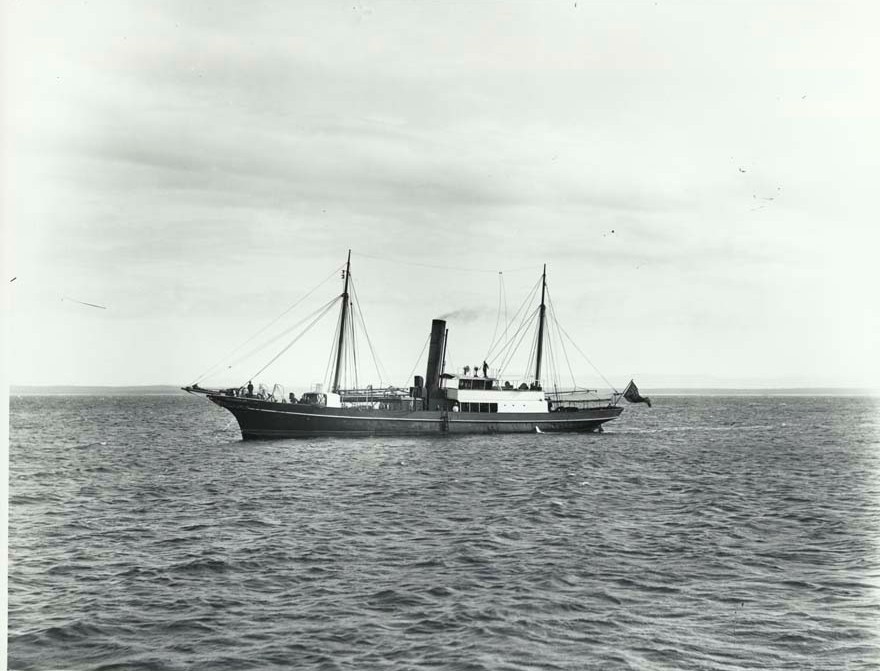
Thetis Image No.: 4481_a026_000478, courtesy NSW State Records
The towers are temporary structures, the inner one being twenty feet above the rock, and the outer one ten feet.. Each tower is constructed of four hardwood posts, firmly fixed in the rock, which has been excavated to receive them, and they are protected from the weather by sheets of corrugated iron. The lanterns are fixed up on the wooden structure, and about four feet below the lights running round each tower, is a platform from which the trimmer can light and clean the lamps. A sleeping berth for the light-keeper has been fitted up in the larger tower, which is placed at a distance of 1180 feet in a W.N.W". direction from the outer tower. The outer light is 315 feet and the inner one 347 feet above high water mark.
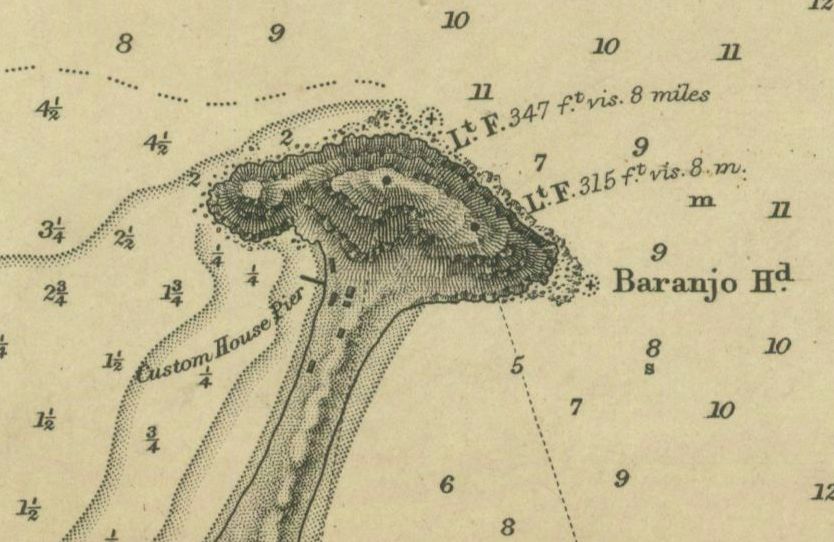
Australia East Coast - New South Wales Broken Bay [cartographic material] 1869 Edition - Surveyed by Capt. F.W. Sidney, Nav. Lieut. J.T. Gowlland & C.George Nav. Mid. R.N. 1868. Series note: British Admiralty nautical charts; 2166 , Courtesy Stat Library of Victoria
Each tower is furnished with three lanterns lighted with kerosene, to form a fixed bright light, and will be visible at a distance of about twelve miles to seaward. From a notification to mariners in the Government Gazette, we learn that both lights will be eclipsed between the bearings of South mid S.S. E ½ E., to prevent them from being seen over the land which recedes from the Outer South Head, and also to ensure a vessel to pass a safe distance off the South Head, when running with the lights in sight for the purpose of obtaining anchorage in Broken Bay.
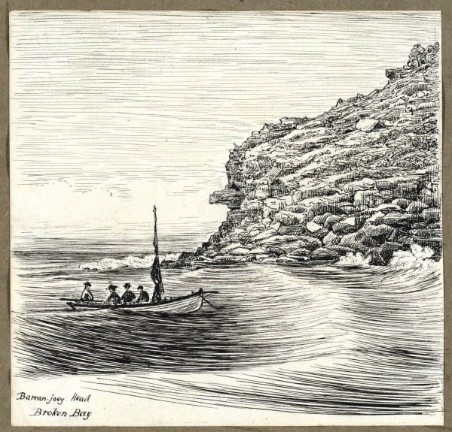
Right: Barranjoey Head, Broken Bay [picture]Creator Graham, H. J. (Harold John), 1858-1929. Description, pen and ink drawing [1884?] Image number nla.pic-an6438965, courtesy National Library of Australia.
The lower, or outer light, will be lost sight of in rounding Barreujuey, but the upper light will be a good guide for coasters bound to Pitt Water, or for large vessels anxious to obtain shelter in Flint and Steel Bay. On Tuesday last the Thetis went down to Broken Bay, taking as passengers Captain .Myhill, Harbour Master of Port Jackson, Mr. Coles, and Mr. Robinson, the manufacturer of the lanterns, when both lights were exhibited for a short time, and their position and bearings examined from various points seaward by Captain Myhill, prior to the return of the steamer to Sydney. It was intended to have a picnic to mark the occasion of the lighting up of these two lights-which, by the way, are to be called " Stewart's Lights," after Mr. Stewart, one of the members of the Assembly for East Sydney, who has been the principal mover in the matter, and had the weather continued fine the Thetis would have gone down to the bay yesterday morning with a number of gentlemen. As the weather proved so stormy, the trip by sea had to be postponed, and Mr. Robinson, and Mr. Mulhall, who has been appointed light-keeper, went overland to light up last night. A notification for the intention to exhibit these lights has been in the papers for a fortnight, but it should undoubtedly have been given much earlier-Sydney Herald, July 21st. SHIPPING INTELLIGENCE. (1868, July 29). The Mercury(Hobart, Tas. : 1860 - 1954), p. 2. Retrieved from http://nla.gov.au/nla.news-article8853675
LAYING THE FOUNDATION-STONE of a NEW LIGHTHOUSE at BARRENJOEY. (BY OUR OWN REFORTEB.)
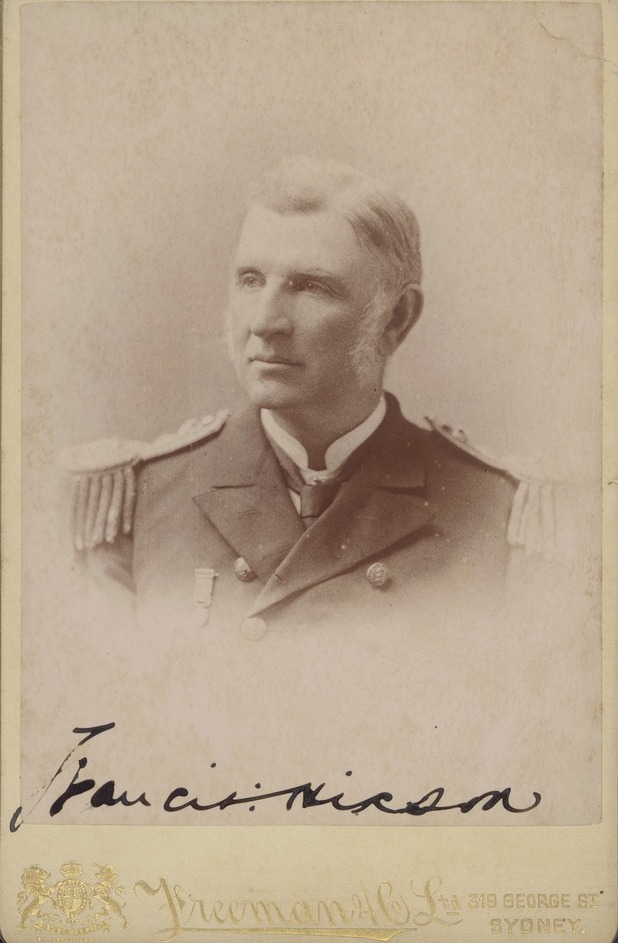 The ceremony of laying the cornerstone of the new |lighthouse at Barrenjoey was performed on Thursday, by Miss Rosa Barnet, daughter of the Colonial Architect, and everything connected therewith passed off in a highly satisfactory manner. The contractor issued invitations to several ladies and gentlemen to be present, and among those who responded thereto were Messrs. J. S. Farnell, E. Greville, and J. Hurley, M.L.A., Captain Hixson, and Messrs. Thompson, Whiting, Jeannerett, Wilson, Walker, Barnet and Spencer. Mrs. and Miss Barnet and several other ladies were also present. The party loft the Circular Quay at a quarter past 7 o'clock, in the steamer Emu, for Manly Beach, whence they were to go overland in vehicles. The morning was somewhat cloudy, and the harbour overspread with a fog. Before the steamer reached Manly, however, the fog had entirely disappeared, and the sun made an effort to beam forth through the somewhat sombre sky.
The ceremony of laying the cornerstone of the new |lighthouse at Barrenjoey was performed on Thursday, by Miss Rosa Barnet, daughter of the Colonial Architect, and everything connected therewith passed off in a highly satisfactory manner. The contractor issued invitations to several ladies and gentlemen to be present, and among those who responded thereto were Messrs. J. S. Farnell, E. Greville, and J. Hurley, M.L.A., Captain Hixson, and Messrs. Thompson, Whiting, Jeannerett, Wilson, Walker, Barnet and Spencer. Mrs. and Miss Barnet and several other ladies were also present. The party loft the Circular Quay at a quarter past 7 o'clock, in the steamer Emu, for Manly Beach, whence they were to go overland in vehicles. The morning was somewhat cloudy, and the harbour overspread with a fog. Before the steamer reached Manly, however, the fog had entirely disappeared, and the sun made an effort to beam forth through the somewhat sombre sky.
Right: Captain Hixson: circa 1895 - 1903 By Freeman & Co Ltd. Image courtesy of the State Library of Victoria [Acc No: H2011.176/36
Arrived at Manly, three coaches were found in waiting, which were quickly filled, and a start was then made for host Cohen's hotel, on reaching which it was announced that breakfast was awaiting us. The early hour at which most of the party had been compelled to shake off dull sleep, in order to be in time for the boat and the trip down the harbour, had rendered it quite unnecessary that the announcement should be repeated. Accordingly, we immediately wended our way upstairs to the dining-room, where a really excellent breakfast had been provided. Good humour reigned supreme. After breakfast we again took our seats in the vehicles-the ladies in one and the sterner portion of humanity in two others, and made a start on our journey proper, the vehicle containing the ladies going on first. The road for some distance, after leaving Sydney's favourite marine suburb, was dull and uninteresting ; but as we went on the features of the landscape changed, and the level tracts covered with stunted timber and brushwood gave place to undulating country, with trees of large dimensions, though evidently not of much commercial value. One conspicuous features was the number and great variety of ferns, which, after the shower of rain, looked beautiful. I almost forgot to say that just after leaving Manly rain began to fall, but it was not heavy and only lasted a short time, so that mackintoshes and umbrellas were speedily dispensed with. The sun then came out in full force, and the remainder of the day, with the exception of one very slight shower, was beautifully fine. Until Narrabeen Lagoon was reached, the journey was not productive of anything worthy of record beyond the fact that every one seemed to be m the best of spirits. The passage of the lagoon was, however, rather exciting to most of the party, from the fact that hints had been thrown out beforehand that the horses might jib, and leave us in the middle of the water before it was accomplished ; that the water was deep, and the swerving of the horses to either side might be the means of increasing the applications for space at Haslem's Creek. Notwithstanding our "critical position" the utmost coolness was observed; whilst we were crossing the ladies were assured by one gentleman in our vehicle of their perfect safety by the fact of so many " life-boys " bring close to them. A merry peal of laughter was the only reply. Frequent inquiries were made of the ladies as to whether "their feet were wet yet," as the bottom of the body of their vehicle seemed to be immersed; and it was evident that if such a calamity had happened several of our party were prepared to go to any extreme to avert its repetition. However they were not called upon to exercise their undoubted courage, or manifest other than in the way mentioned, their chivalric devotion. We got through the lagoon in safety.
The remainder of the road-or rather track was in fair order, and we made respectable progress. As we neared the end of our journey we gradually ascended a hill, on reaching the top of which a magnificent panoramic view burst upon us. At our feet lay the waters of Broken Bay, or rather that portion of it termed Pitt Water. For miles it stretched towards the entrance to the mouth of the Hawkesbury ; while, on either side, bold headlands, crowned to their summits with timber, and looking like great sentinels, rose from the water's edge. Expressions of wonder at the beauty of the scene were heard on all sides, and the fact that this lovely place is so little known to denizens of the metropolis was freely commented on.
But our steamer, the good ship Florrie,owned by Mr. Jeannerett, was in waiting, lying alongside a jetty at the head of the bay, so we immediately embarked for our destination, Barrenjoey, a distance of about eight miles. On the opposite side of the bay is New Port, the property of Messrs. Mills and Pile and Mr. Jeannerett, who are erecting an hotel, for the accommodation of visitors to the bay. It will have a fine situation ; and when the place becomes more widely known, as it deserves to be, the hotel will doubtless be largely availed of. The trip down the bay was greatly enjoyed ; and every point of interest critically scanned.
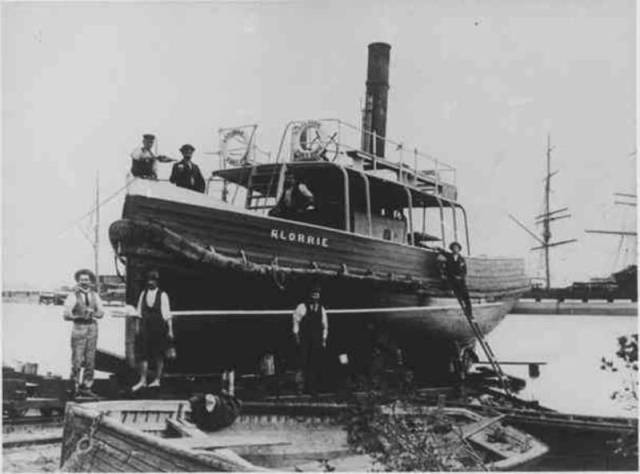
Shortly before 1 o'clock, or about on hour after leaving the wharf, we steamed opposite the jetty, at the Customs-house landing, a short distance away-the depth of water not permitting us to go alongside, and soon Mr. Black, with his whaleboat, came along-side. The whole of the party were then transferred to her, and safely taken on shore, while the provisions, ice., were conveyed in another boat. After a short stay at Mr. Black's house, we prepared to make the assent of the frowning rock upon which the lighthouse is to be erected. As it is over 300 feet high with sides almost perpendicular, the task was looked forward to with a degree of interest which all under-takings of a similar nature excite in the persons principally concerned. Fortunately for the ladies, Mr. Banks, the contractor, had a " tram-car," or rather trolly, in waiting, upon which they were to be taken to the top. It may be said here that this tramway, the rails of which are of hardwood, is a remarkable evidence of the ingenuity Mr. Banks has exhibited in overcoming the many difficulties in-separable from an undertaking of such magnitude as that of the erection of the Barrenjoey lighthouse. For sometime otter the erection of the lighthouse was decided upon it was contended that it would not be possible to have a road constructed by which the necessary materials could be conveyed from the base of the rock: to the site of the lighthouse, and that they would have to be hauled up os-or the face of the rock ; but Mr. Banks has completely upset this contention. The tramway is 1000 yards long, and is used for the conveyance of everything, except the stone, which is obtained on the top of the rock itself. It has been found invaluable for the purposes for which it was designed and constructed. It is drawn by two horses, which, it may be imagined, when it is stated that some of the gradients are 1 ni 12, have their work to do. The car or trolly is fitted with a brake, which is so powerful that the car can be stopped almost in its own length when going down the steepest incline.
However, this is a digression. The ladies were taken up safely, though not without some misgivings on their part " that the thing would go back." It is questionable if there is along the whole-coast-line a finer view than that which is presented to the eye of the beholder from the top of this Barrenjoey. Away to the north is the north head of Broken Bay ; taking this as the beginning of a semi-circle, round towards the left Brisbane-water, the mouth of the Hawkesbury, and Pitt Water are seen in succession, with Mount Elliott (in the form of a lion couchant) guarding the entrance to the second named.
Shortly after the whole of the party reached the top due preparations were made for the ceremony. The crane and other places were decorated with bunting, while the flagstaff was "staggering" almost with flags, amongst them being the figures denoting the motto " Advance Australia," so that ships in the offing-of which there were several would be enabled to read it. After all the preparations had been completed, and the bottle containing the papers, coins, &c, had been placed in the receptacle prepared for it.
Mr. Greville said : Miss Barnet,-I have the pleasure of presenting to you, on behalf of the contractor, this mallet and silver trowel, for the purpose of laying the foundation-stone of the Barrenjoey lighthouse. They are implements small and delicate enough for such fragile hands, but yet in those hands they will be instruments for initiating a noble work. With a few light touches of this pretty piece of metal, and a few taps of too mallet, you will lay the first stone of a tower which will be the guide and safeguard of many future voyagers. Above the spot on which you stand I here will arise a noble beacon-the silent sentinel of the storm-tost mariner, the shining monitor, warning those who brave the perils of the deep to shun the more obdurate dangers of these callous rocks. A writer of great colonial reputation, and one whose untimely death will be received with the deepest regret by everyone who has had the pleasure of his acquaintance, "Peter Possum," once repeated a rendering of the old word "spea." "Spes" is usually translated by the English word âhope" but what a beautiful illustration of that translation flashes upon the mind when we discover that the literal interpretation of the Latin " spes " is a light in the distance, towards which we look and long. The light upon the tower which is soon to arise upon these rocks might fitly be called " Spes." It will be a light looked for and longed for on many a darksome night. It will be the star of hope to many a weather-beaten crew, and the saviour of many a storm-pressed ship. (Hear, hear.) It is for you, Miss Barnet, to place the first stone of that tower-a task easy in itself, but noble in its associations, and fitted well for a fair hand and a benevolent heart. (Applause.)
The mallet and trowel were then, handed to Miss Barnet, who, after the orthodox preliminaries, had been gone through, declared the stone to be well and truly laid.. On the call of Mr. Barnet, three hearty cheers were given for her Majesty the Queen, and three for his Excellency the Governor; and, on the call of Mr. Hurley, three cheers were given for Miss Barnet. The silver trowel and mallet were from the atelier of Messrs. Hardy, Brothers, and are very handsome articles. On the face of the trowel is the inscription, *' Presented to Miss Rosa Barnet upon the occasion of her laying the foundation-stone of the lighthouse at Barrenjoey, New South Wales, 15th April, 1880." The trowel is of solid silver, neatly chased, and the handle of ivory, the mallet being of tulip wood. Mr. Barnet thanked the company for the honour which they had done his daughter, which was certainly quite unexpected. He had intended to come down and see the stone laid, but did not expect any ceremony. He had, therefore, all the greater reason to thank them. (Applause.) After the ceremony had terminated, the party returned to the bottom of the rock, the ladies going as they came-on the tramway, and adjourned to Mr. Blade's house where luncheon was served up, and a most enjoyable affair it proved to be.
The necessity for a lighthouse at Barrenjoey was brought under the notice of the Government as far back as 1868, when the present site was selected as the best adapted for the purpose, but the land being private Property, with the probability of considerable delay before the Government would be enabled to take possession of it in order to meet immediate requirements, Captain Hixson, H.N., superintendent of harbours, lighthouses, and pilots, recommended the erection of two temporary wooden buildings, in which lights might be exhibited. This recommendation was approved of by the then Colonial Treasurer, the Hon. Geoffrey Bagar, the work being carried out by Messrs. Hudson, Brothers, of Sydney, at a cost of about £300, including- £35 for the two lanterns, &o'., made and supplied by Messrs. F. B. Robinson and Son, of George-street, Sydney, and completed in August, 1868. In the year 1873, at a conference of the principal officers of the Marine Departments of the Australian colonies, held in Sydney, at which Captain Hixson was unanimously elected chairman, the members of the Conference being:-New South Wales. Captain Hixson, President of the Marine Board; Queensland, Captain Heath, B.N., Chairman of the Marine Board, and Port Master; South Australia: Captain Ferguson, President of the Marine Board; Tasmania, Mr. C M. Maxwell (Warden of the Hobart Town Marine Board) ; Victoria, Captain Payne, R. N.(Chief Harbour-master and Chairman of Steam Navigation and Pilot Board); Western Australia, Captain Ferguson (President of State Marine Board of South Australia),-it was resolved to recommend the erection of a lighthouse at Barrenjoey, with light of the second order fixed red light, and in the year 1874 plans for a permanent light and quarters were prepared, and the sum of £6000 was also in that year voted towards the erection of the buildings. The matter, however, was postponed from time to time, and tenders were not invited until October, 1878, but those received being considered too high, they were declined. Ultimately, in October, 1879, the tender of Mr. Isaac Banks, amounting to £18,696, was accepted, and preparations were at once made for commencing the work. This tender, however, did not provide for the lantern and dioptric lenses which were obtained from Messrs. Chance, Brothers, of England, at a cost of £2210. The light about to be placed upon this prominent headland is of the second order of fixed dioptric red lights, with capacious well-ventilated lantern, having all modern improvements, placed in a substantial iron light-room, the whole standing upon a strong tower, 38 feet high, built with the stone of the locality. The height of the light will be 371 feet over high-water mark, and it will be visible at about eighteen miles distance. The tower will be fitted with an iron spiral stair, communicating with the upper floor. Adjoining the tower will be an oil room, with passage and exterior stairway communicating with the principal quarters. The underkeeper's quarters will be placed slightly lower on the hill to the south-west. The tower and buildings will be replete with every convenience for; the efficient working of the light. The new light will supplant the present "Stewart" lights, which have been in use for the last thirteen years. This work has been designed by the Colonial Architect of Now South Wales-Mr. James Barnet-and is being carried out under the superintendence of Mr. E. S. V. Spencer, clerk of works, and Mr. John Kelly, foreman of works; the contractor, as before stated, being Mr. Isaac Banks.
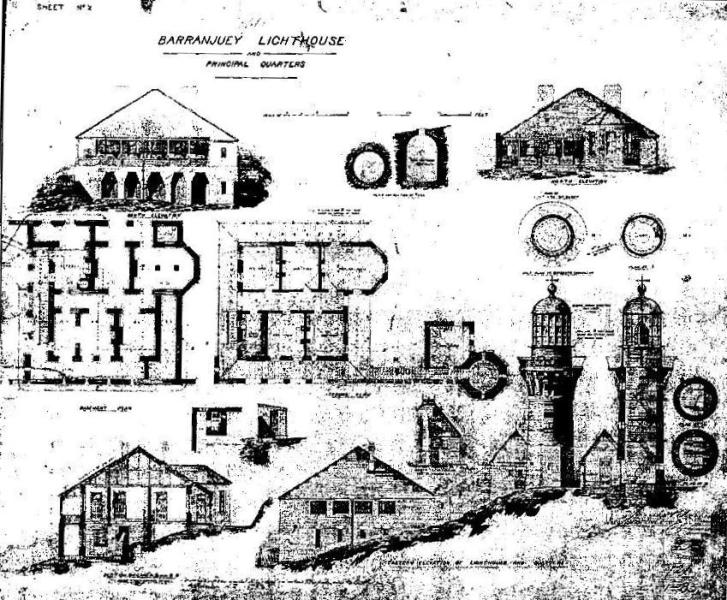
James Barnet plan for the Barrenjuey Lighthouse and attached head Lighthouse Keeper Cottage. Source: AMSA
The bottle which was placed under the stone contained a paper with the names of the Government and of the vice-regal staff; list of members of both Houses of Parliament; report of proceedings of the Marine Board Conference on lighthouses; report of the laying of the foundation-stone of Macquarie Lighthouse ; Moore's Almonas ; a copy each of the Sydney Morning Herald, Sydney Mail, Echo, Evening News, Town and Country journal, Sydney Punch, Daily Telegraph, and the Illustrated Sydney News ; report of the Shipwreck Relief Society, and a medallion of Queen Victoria, besides several current coins of the realm. It maybe added the site selected by the Marine Board has been so closely adhered to that the "broad-arrow " out in the solid rock, by which it was marked, appears directly in the centre of the foundations.
The arrangements for carrying on the works seem to meet all the requirements. Houses for the accommodation of the workmen have been erected on the seaward side of the isthmus which joins Barrenjoey to the mainland, and the men seem comfortable and contented.
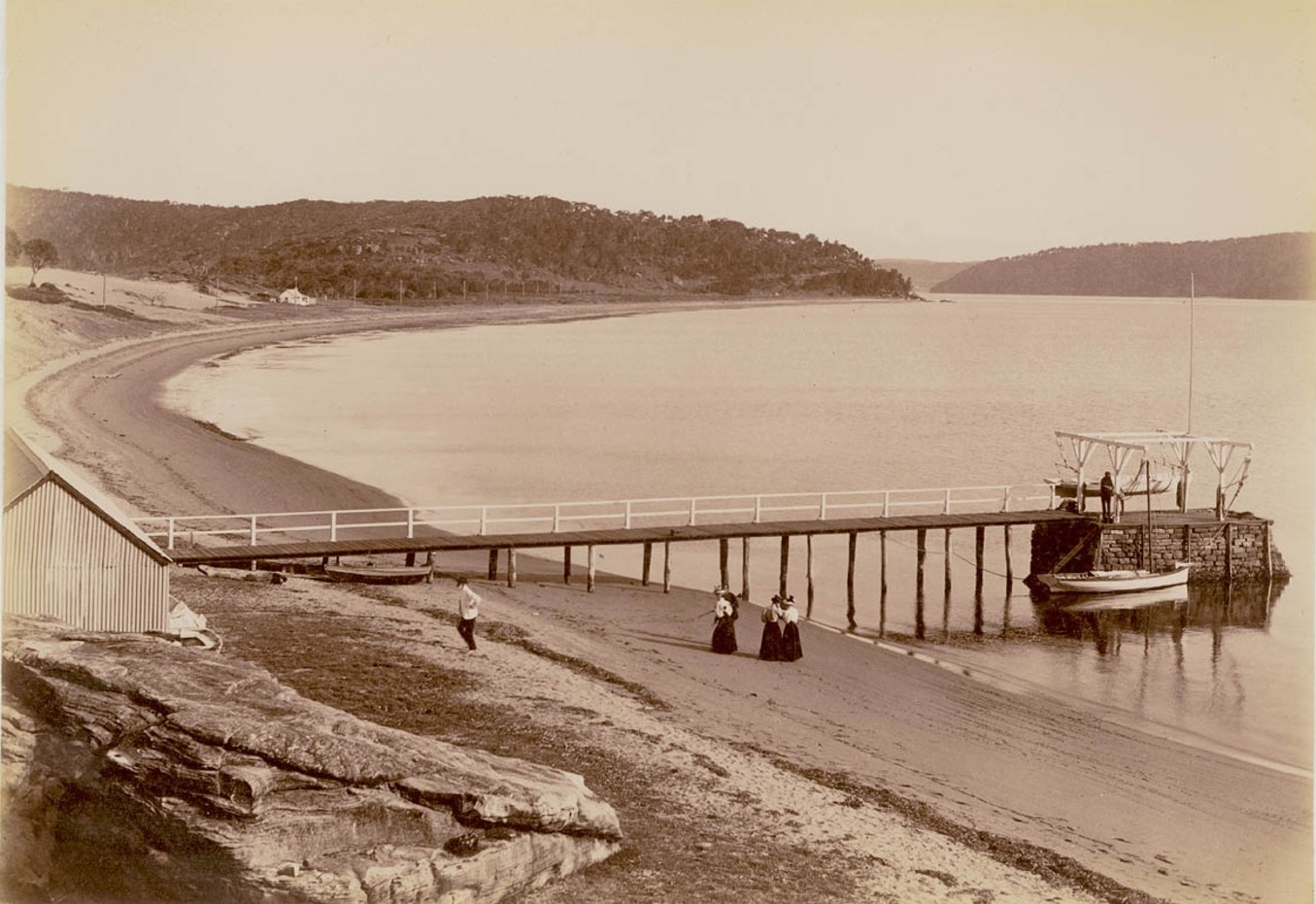
Above: Wharf, Barrenjoey, Hawkesbury River, 1900-1910. Pic No: a116421, Courtesy of The State Library of NSW
At half-past 4 the steamer arrived, and after good-byes had been exchanged, the party were soon taken on board by the whaleboat, and a start made for home. An hour's steaming brought us alongside the wharf which we had left in the morning, where the vehicles were found drawn up in readiness. After a little time they were filled, and the land journey was proceeded with. Nothing of moment occurred on the way ; the dreaded Narrabeen was crossed in safety, and the party put down in safety at Host Cohenâs Hotel, Manly, where a cup of tea was hastily partaken of and a move once more made to the wharf. Alter a pleasant trip of a little less than an hour, we were landed at the Circular Quay, having spent a day's unalloyed enjoyment. Everything connected with the trip, from first to last, had been most carefully attended to, and the result was a genuine success. LAYING the FOUNDATION-STONE of a NEW, LIGHTHOUSE at BARRENJOEY. (1880, April 17). The Sydney Morning Herald(NSW : 1842 - 1954), p. 7. Retrieved from http://nla.gov.au/nla.news-article13458288
And then the opening so soon afterwards:
THE BARRENJUEY LIGHTHOUSE.
The new lighthouse at Barrenjuey, an illustration of which appears in this issue, was lit up for the first time on Monday night, August 1, by Mr. George Mulhall, the lighthouse-keeper. On Friday an official visit was made to the lighthouse by Mr. James Barnet, and Captains Hixson. Jenkins, Broomfield, Robertson, M'Lean, and Lieut. Lindeman, R.N. The party left in the Captain Cook during the afternoon, and returned to town about 10 o'clock after a somewhat rough passage. At a conference of though principal officers of the Marine Departments of the colonies held in 1870, at which were present Captain Hixson (chairman), representing this colony, Captain Heath, R.N., for Queensland; Captain Ferguson, for South Australia and Western Australia ; Captain Payne, for "Victoria; and Mr. C. W. Maxwell for Tasmania, it was resolved to recommend the erection of one lighthouse at Barrenjuey, to take the place of the two temporary lights, with lights of the second order of fixed diopiric red lights ; and in the year 1871 plans for a permanent lighthouse and quarters were prepared, and the sum of £5000 was also voted towards the erection of the buildings. In October, 1879, the tender of Mr. Isaac Banks, amounting to £13 005, was accepted, and preparations were at once made for commencing the work. This tender, however, did not provide for the lantern light, and the light rooms, &c. The lantern was obtained from Messrs. Chance Bros., of England, at a cost of £2210. The entire work was completed by the contractor on the 20th ultimo. The lantern is capacious and well ventilated, having all modern improvements, placed on a substantial iron lightroom, the whole standing upon a strong tower, built with the excellent freestone of the locality. The height of the light is 371ft over high water mark, and is visible about 15 miles distant, latitudes 33deg 35 mins S., longitude 151deg 21min
The tower is fitted with an iron spiral stair, communicating with the upper floor. Adjoining the tower is an oil-room with passage and exterior stairway communicating with the principal quarters. The underkeepers' quarters are placed slightly lower on the hill to the south-west, and sheltered by the north-eastern cliff. The works were designed by Mr. James Barnet, the Colonial Architect, and under his direction they were carried out, the superintending officers being Mr. E. S. V. Spencer, clerk of works, and Mr. John Kelly, the mason foreman of the works. The latter loft for Montague Island lighthouse works in December, 1880, being succeeded by Mr. Archibald Murray, carpenter, from the South Solitary lighthouse works. The members of the Marine Board and Mr. S Barnet express themselves as very pleased with the manner in which Mr. Banks has carried out his contract. THE BARRENJUEY LIGHTHOUSE. (1881, August 6).Australian Town and Country Journal (Sydney, NSW : 1870 - 1907), p. 37. Retrieved from http://nla.gov.au/nla.news-article70958591
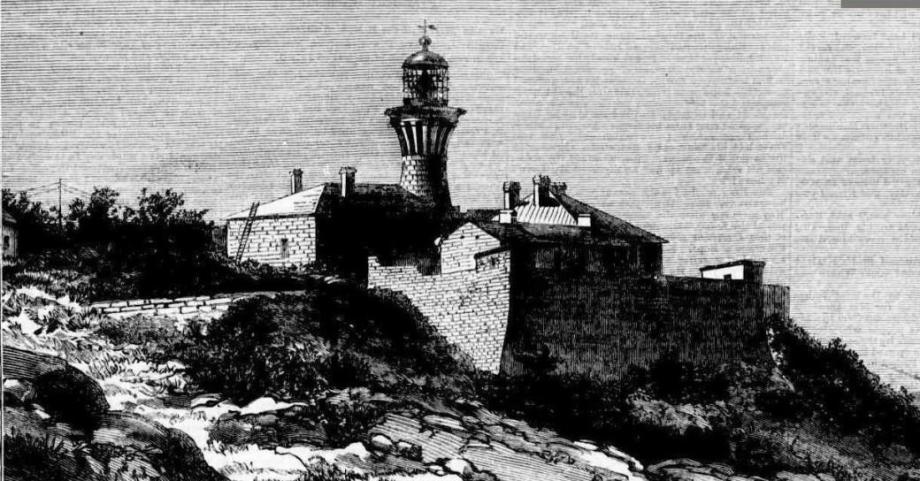
THE BARRENJUEY LIGHTHOUSE, BROKEN BAY.-OPENED ON MONDAY NIGHT. (SEE SHIPPING INTELLIGENCE.) THE BARRENJUEY LIGHTHOUSE, BROKEN BAY. OPENED ON MONDAY NIGHT. (SEE SHIPPING INTELLIGENCE.). (1881, August 6).Australian Town and Country Journal (Sydney, NSW : 1870 - 1907), p. 32. Retrieved from http://nla.gov.au/nla.news-article70958799
ON BOARD THE WOLVERENE.
For the first time in the history of the colony a colonial naval force took part in the Easter manouvres, and their doing so contributed largely to the interest of the proceedings. When the Naval Volunteer Artillery were formed people were found to sneer at the idea, as they had done in the case of the land volunteers, of their becoming efficient, but the sham fight yesterday and the drills which preceded it have effectually proved that our men are able to play their part by sea and by land as defenders of hearths and homes. The plan of naval operations was that a squadron, composed of the Wolverene, Ajax, Captain Cook, Juno, and Neptune, should rendezvous in Broken Bay at 11 a m yesterday, and at noon proceed to sea, where they would engage with an imaginary enemy in the offing, and, after a sharp fight, retreat slowly to Port Jackson, under shelter of the batteries, and that the combined efforts of the military and naval forces and of the torpedo corps would completely vanquish the attacking cruisers. The hopper barges Juno and Neptune were manned entirely by the Naval Volunteer Artillery, the others by the Naval Brigade. The full strength of the brigade is 327 petty officers and men and it is a gratifying evidence of their interest in their work that 308 of them reported themselves for duty, 208 being allotted to the Wolverene, 60 (being the Newcastle contingent) to the Ajax, and 50 to the Captain Cook. The others on the corvette were Commander Lindeman, R N , in command of brigade, Lieutenants Deloitte, Jackson, and Partridge, R N ; sub-Lieutenants Gilfillan, Oatley, Milson, and Broomfield , Midshipmen Jacobs, F.W. Hixson, H Hixson, S. Day, and W. Day, and Cadets Street, Wright, M'Farlane, Traier, Lamb, and Harley Hixson, Dr Evans, staff surgeon , Dr. Knaggs, surgeon, and the gunnery instructor, Mr Rickwood.
_at_Lady_Macquaries_Point.jpg?timestamp=1377866985861)
HMS Wolverene 1863, at Lady Macquarie's Point. Henry King Photo, courtesy Powerhouse Museum.
The Ajax was commanded by Captain Cross, under whom were Lieutenant Gardiner, Midshipman Cross, Cadet Hickson, Dr. Baker, and Gunnery-instructor Dagwell. On the Captain Cook the officers were Lieutenant Lewington (in command), Sub-lieutenant Cohen, Midshipman Church, and Cadet Dawson, Lieutenant Commander R. N. Arnold was m charge of the Juno, and Lieutenant Les was in command of the Neptune, and each vessel was fitted up and armed in the manner described in the Herald several days ago. The Wolverene carried 14 guns, seven on each side a Gatling gun in the main-top, and two stern chasers, and the Ajax and the Captain Cook each carried two broadside guns and one stern-chaser. The Naval Brigade had had two drills in harbour on board the Wolverene, but it was not until Saturday afternoon last that they put to sea in her. At 3 pm the main contingent mustered at the horse ferry, Fort Macquarie, and, after waiting half an hour for stragglers, the tender conveyed the brigade to the Wolverene, which, was lying at her buoy in Farm Cove, with steam up ready for a start. While the men and their kits were being got on board a few additional members of the Brigade came hurrying up in a small boat and were only just in time to join their comrades, for shortly after 4 o’clock the Wolverene slipped her moorings and put out to sea, steering southward.
The brigade were then mustered, and a very fine body of men they looked, many of them presenting the unmistakable stamp of the man-of-war's man, and all seeming to know their drill well. Some are veterans, and will soon have to be superannuated, but there is plenty of good young vigour and courage to take the place of those who in the course of time must cease to be available The Government have given orders to double the strength, of the brigade, and eligible recruits are flocking in in such numbers that 50 splendid men were taken on a few nights ago, leaving 70 applicants to be Inspected tomorrow night at Fort Macquarie. The recruits and the applicants are of excellent physique, many of them have been seafaring men, and hitherto all who have been enrolled are permanent residents of Sydney, employed chiefly as wharf labourers, store men or watermen.
When the brigade mustered on the main deck on Saturday afternoon, Commander Lindeman told them off into to their respective watches and messes, the officers of the different watches being Sub-lieutenants Oatley, Gilfillan, Milson, and Broomfield, with Messrs. Jacobs, F. W. Hixson, W. Day, and S. Day as their midshipmen. Lieutenant Partridge was placed in charge of the foremast quarters, Lieutenant Debit to in charge of the after quarters, and Lieutenant Deliotte in charge of the stern-chasers and the small-arms party.
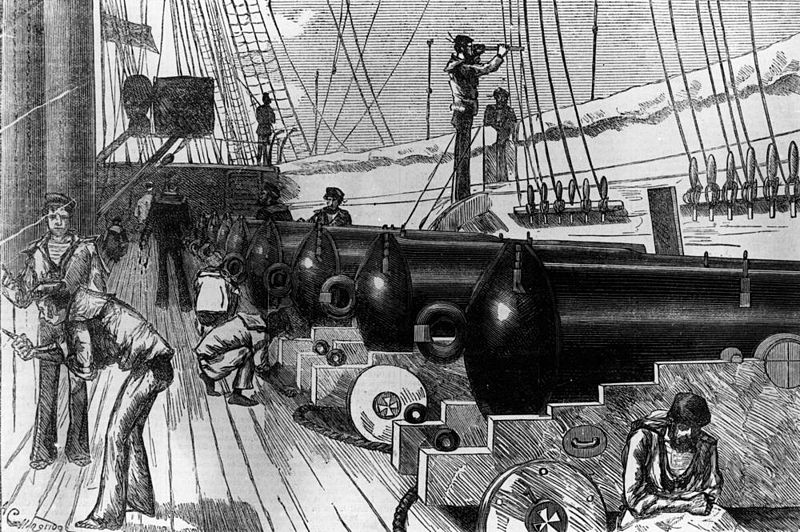
Gun deck of H.M.S. Wolverene, 1881. Copy of an illustration from the Town and Country Journal, 11th of June, 1881 p.1128. Artist's name Colleridge?.
The gig which had brought the late arrivals off was hoisted on board, and a curious appearance her bottom presented, justifying the previously-expressed remark of one Jack-tar, that she was "cruel hard boat to pull." She was covered with marine growth and barnacles, all the result of three months immersion, and this circumstance shows how badly the long stationary Wolverene needed her recent docking.
The command of the corvette during this last trip was of a divided nature. Captain Hixson was in effect Admiral of the squadron; Commander Lindeman had full control of the brigade, and managed everything as regarded the fighting of the ship ; while she was sailed by her own permanent staff of officers and men. These were- Lieutenant F. P. Taylor, R.N. (in command), Lieutenant G. S. Bosanquet, R.N., Lieutenant R. Smith, Chief Engineer Walker, Paymaster E. J. Thomas, Gunner J. Costello, and Boatswain J. M'Carthy. She carries 34 able-bodied sea-men, 3 quarter-masters, 7 stokers, 2 boatswain's mates, 5 boys, and several cooks had stewards. The commissariat arrangements for the cruise wore made and skillfully carried out by Mr. Thomas, the paymaster.
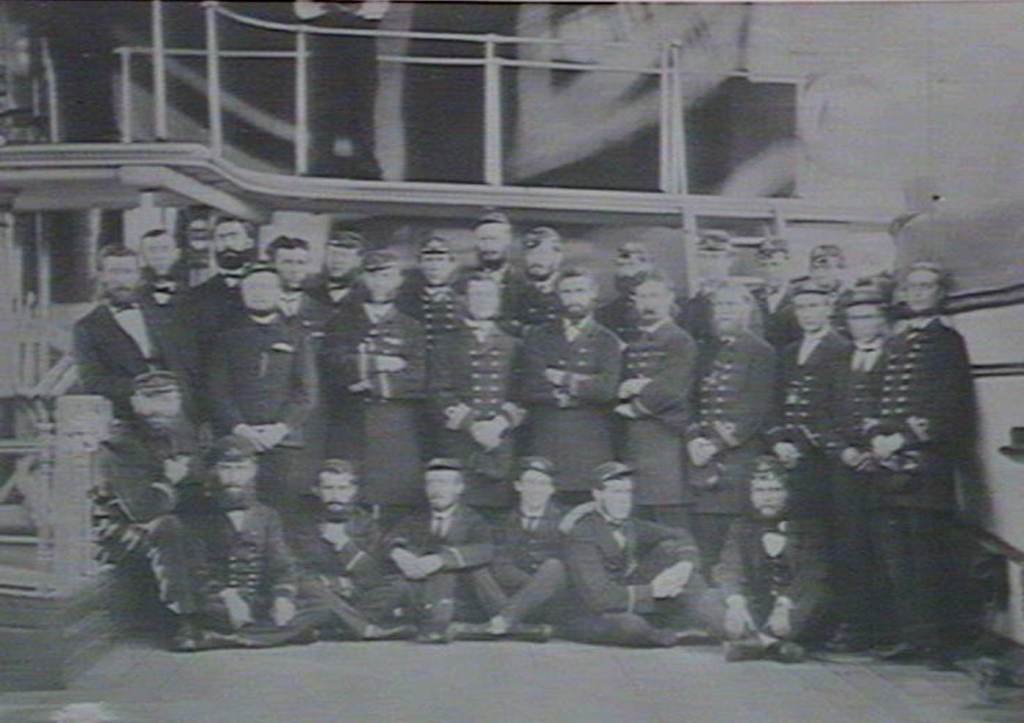
Early Group, Captain Lindeman on HMS Wolverine. Image No: Government Printing Office 1 - 12062, courtesy State Library of NSW.
Shortly before dusk on Saturday the Wolverene passed through Botany Heads, and anchored for the night a short distance up the bay, which some people consider one of the weak points in our harbour defences, but which is included in a general comprehensive scheme of defence lately worked out. The brigade had now settled down with regular naval discipline, and the old Wolverene looked livelier and more like a man-of-war than she has done any time these three years. Poop and forecastle, main deck and lower deck, were crowded, and the usual routine of service life was followed. Sentries wore posted at 8 o'clock, and at 9 o'clock, when the Commander went the rounds, he found everything satisfactory and the men all settled down into their places.
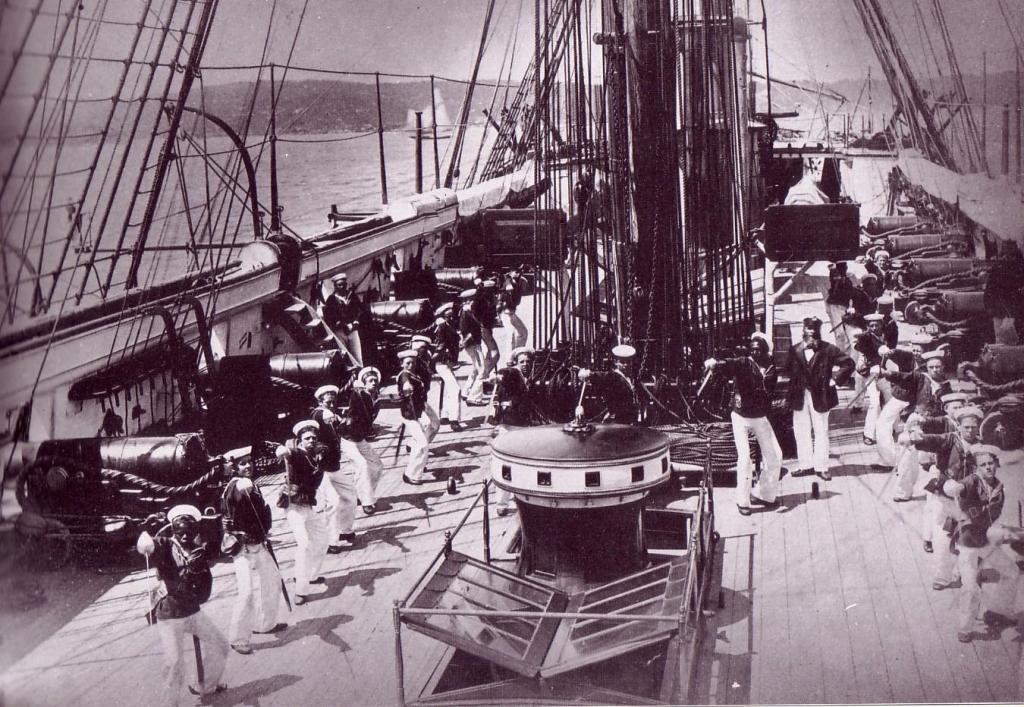
HMCS Wolverene: cutlass drill, 1882, courtesy State Library of NSW.
A lot of them were abnormally merry, and after tea regaled their comrades with popular songs, sung very much out of tune; but for the most part their voices wore drowned by the music of the Naval Brigade Band, which played on the quarterdeck while the officers were at dinner. Of the 30 men who compose this band, no less than 23 reported themselves, and the bandmaster, Mr. J. Devlin, certainly deserves the utmost most credit for the excellence of the tuition ho has given them. Their repertory is large, it contains the latest music of special merit or popularity, and every selection was played in perfect time and with appropriate expression. Some of the instruments need renewing, but, as a rule, the tone is harmonious, and officers and men alike enjoyed the sweet strains which for a couple of hours floated over the tranquil waters of Botany Bay.
On Sunday morning the reveille was sounded at half-past 6 o’clock, and at 6 the men turned out. At 7 o'clock they went to quarters and did gun drill for an hour, profiting markedly by the clear directions given them by Mr. Rickwood -who held the position of drill instructor on the Nelson during the recent cruise of that vessel. The guns were cast loose, and broad-side and independent filing wakened the echoes to such an extent that the Botany people must have wondered if some hostile cruiser had not really arrived in these waters. The small-arm men were also drilled, and the different exorcises were so smartly carried out that Captain Hixson addressed a few words of approbation and encouragement to the Brigade. At 8 o'clock the guns were secured and the men went to breakfast; and after the meal the anchor was tripped, and the Heads were cleared at half past 9 o'clock.
Soon after 11 o'clock, when the Wolverene was abreast of the Sydney Heads, she signalled to the South Head station, " Have you any news of recent date about the enemy ? " and received an answer in the negative. She continued a northward course, and arrived and anchored in Broken Bay at half-past 1. After dinner the men went to quarters again, the roll was called, and service was held according to the Church of England ritual for Easter Sunday, the Rev. J. M. Hillyar, B.A., being the chaplain. Officers and men, clad in full uniform, stood in a square around an improvised pulpit, draped with the union jack ; and Mr. Hillyar, after a somewhat condensed service, preached a brief and impressive sermon, taking as his text Matthew, chap, xxviii, v. 6, "And the angel answered and said unto the woman, ' Fear not ye ; for I know that ye seek Jesus, which Was crucified.' "
The discourse was one appropriate to the occasion, and it was listened to attentively and reverently, although the attention of the congregation might well have been distracted by the puffing of pacing steam launches, or the gleam of an occasional yacht or sailing-boat wheeling in graceful curves around the vessel.
Broken Bay was full of craft, among them being the schooner-yacht Red Gauntlet, the Waitangi, the launch Ena, and a launch chartered by a band of jolly bachelors. After service no drill was performed. A small party went out with a seine net, and caught a few dozen bream and trevally, losing-owing to their want of skill at their Work-a shoal of garfish, which slipped through rents and skimmed over the top-rope until all had vanished. Others formed two crews, and had an exciting race in whaleboats, and some who remained on board went in for line-fishing. They secured little worth eating, however, the majority of the fish caught being small sharks and large sting-rays.
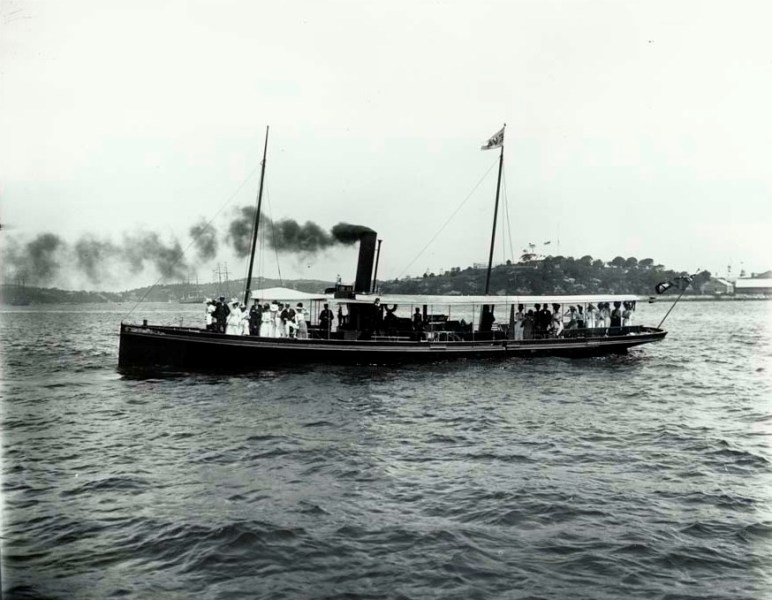
Ena II, courtesy State Archives of NSW
One of the Wolverene bluejackets rashly placed his barefoot on the back of one of the rays, and the fish promptly threw up his tail and inflicted upon him a sting that he will feel for some days. To relieve the pain the sufferer rubbed his foot with kerosene, the result being simply torture, until Dr. Evans directed him to bathe the injured member with hot water and apply bread-poultices to it. The only other cases of sickness in the Brigade were that a man of the No. 3 Company sustained a slight sunstroke; another of the same company had an attack of muscular rheumatism and one of the No. 2 Company sprained one of his ankles.
In the evening the band gave the usual concert, including as much sacred music as they know, and everyone sought his hammock or berth at an early hour.
Yesterday morning the usual routine was followed, and gun drill was performed even more smartly than on the previous day. At 8 o'clock, when the ensign was hoisted, the band played the National Anthem, according to the loyal custom which prevails in her Majesty's service, and then everything was got in readiness for commencing manouvres as soon as the remaining vessels of the squadron had reached the rendezvous. In the meantime the Brigade were set to man the yards, an operation which they performed with alacrity and fearlessness, different squads vieing with one another in the agility with which they reached their appointed stations and the smartness with which they obeyed Commander Lindeman's orders. They had never manned yards before, yet they did it in true man-of-war style. Previously the crew of the Wolverene had struck the top gallant masts and yards so smartly that the Brigade were put upon their mettle to emulate their mates for the time being.
The Ajax arrived shortly after 10 o'clock, and the Captain Cook was punctual in putting in an appearance at 11 a.m., but the hopper barges did not steam into sight until noon, by which time the squadron was underway, this being the hour fixed for departure from Broken Bay. They took up their position in the rear of the line, and the five vessels, the Wolverene leading, moved out to sea. The Juno and Neptune, especially the latter, travelled so slowly that the squadron did little more than crawl along, and the Waitangi, which left Broken Bay after it, skimmed past it with comparative ease, followed by the Red Rover.
_launch.jpg?timestamp=1377862686356) Firing was first commenced by the Wolverene, who blazed away with her stern chasers, and her challenge being promptly responded to by the other vessels-who acknowledged this signal more readily than they did some of the others-the squadron soon seemed to be engaged in a sharp fight, to the evident astonishment of the Swinger, which was a little way out in the offing, on her way to Sydney. She made a few signals, but soon gathered the significance of the demonstration, and left our navy, to its own devices. On approaching the Heads the order for independent firing of the big guns on the port side was given, and the Wolverene was enveloped in smoke, which had scarcely cleared away before a thundering broadside of seven guns on the starboard side renewed it. After this, firing was for half an hour almost continuous the bang, bang, and roar of the big guns, the whip-like crack of the Gatling in the main-top, and the splutter of the rifles on the poop and forecastle, making up a scene of smoke and apparent confusion, which gave one some idea of a sea fight, minus wounds and death. The confusion was only apparent, for whenever the heavy masses of powder smoke lifted, and the figures of the men loomed through them, and were seen at first dimly and then distinctly, moving rapidly about, sponging, charging, and discharging the guns, every man was at his own post doing his own work earnestly and effectively, the discipline maintained being equal to that of a man-of-war's crew.The Ajax and the Captain Cook fired in good style, the Neptune and Juno made themselves heard very frequently, and even the Red Gauntlet-which was some way ahead-became inspired with martial ardour and popped her gun oil occasionally.
Firing was first commenced by the Wolverene, who blazed away with her stern chasers, and her challenge being promptly responded to by the other vessels-who acknowledged this signal more readily than they did some of the others-the squadron soon seemed to be engaged in a sharp fight, to the evident astonishment of the Swinger, which was a little way out in the offing, on her way to Sydney. She made a few signals, but soon gathered the significance of the demonstration, and left our navy, to its own devices. On approaching the Heads the order for independent firing of the big guns on the port side was given, and the Wolverene was enveloped in smoke, which had scarcely cleared away before a thundering broadside of seven guns on the starboard side renewed it. After this, firing was for half an hour almost continuous the bang, bang, and roar of the big guns, the whip-like crack of the Gatling in the main-top, and the splutter of the rifles on the poop and forecastle, making up a scene of smoke and apparent confusion, which gave one some idea of a sea fight, minus wounds and death. The confusion was only apparent, for whenever the heavy masses of powder smoke lifted, and the figures of the men loomed through them, and were seen at first dimly and then distinctly, moving rapidly about, sponging, charging, and discharging the guns, every man was at his own post doing his own work earnestly and effectively, the discipline maintained being equal to that of a man-of-war's crew.The Ajax and the Captain Cook fired in good style, the Neptune and Juno made themselves heard very frequently, and even the Red Gauntlet-which was some way ahead-became inspired with martial ardour and popped her gun oil occasionally.
The land batteries then joined in, and the cannon at Middle, George’s, and South Heads, thundered defiance of the insignificant little steamers which represented the enemy. The Wolverene steamed up the Sound of the North Harbour, the Ajax and Captain Cook following her, while the Juno and Septima remained behind. From the Wolverene, the Mary, one of the invading vessels, could be seen to run into Middle Harbour, and the spray thrown up by exploding torpedoes could be seen over the headland east of Cobblers Beach. The Ajax then steamed up and captured her, an operation performed with comparative ease, seeing that the Mary had a crow of about six all told. The other steam launch passed under a heavy fire up the eastern channel, where certain torpedoes had been laid. These were to have been instrumental in vanquishing her, but somehow they failed to explode. Nevertheless, she was so dismayed by the preparations made for giving her a warm reception that she also surrendered and the sham-fight was over.
The guns on the different ships were then secured and covered. On board the Wolverene the men were beat to quarters, and Captain Hixson, addressing the Naval Brigade generally, and all who had taken part in the squadron manouvres, said that he fell he should be wanting in his duty if, before dismissing them to their homes, he did not acknowledge the very efficient manner in which they had manned and fought the Wolverene and the other vessels. He thanked the Brigade for the good discipline they had maintained, and the other forces for the cordial co-operation they had given him, which two things had enabled him to carry out the wishes of the Government. The Brigade had fought the guns and manned the yards in a manner that would not disgrace a man-of-war, and he felt sure that it an enemy were to come here and try to dispossess us of this country, he could go out and meet him in the manner in which Englishmen were wont to meet their foes. They had a line of defence, and as long as we could go out there and meet our enemies, he did not think we were in the position some of our friends thought we were in. He would not make a longer speech, but would content himself with thanking them again. (Cheers.) Cheers wore given for Captain Hixson, for Commander Lindeman, and the other officers of the Naval Brigade, and for Captain Taylor; and the proceedings terminated with cheers for the Queen. The men could not at once disembark, without incurring the expense of hiring watermen's boats, for the tender engaged to convoy them to Fort Macquarie was considerably behind her time in ranging alongside the Wolverene. ON BOARD THE WOLVERENE. (1885, April 7). The Sydney Morning Herald (NSW : 1842 - 1954), p. 3. Retrieved from http://nla.gov.au/nla.news-article13579326
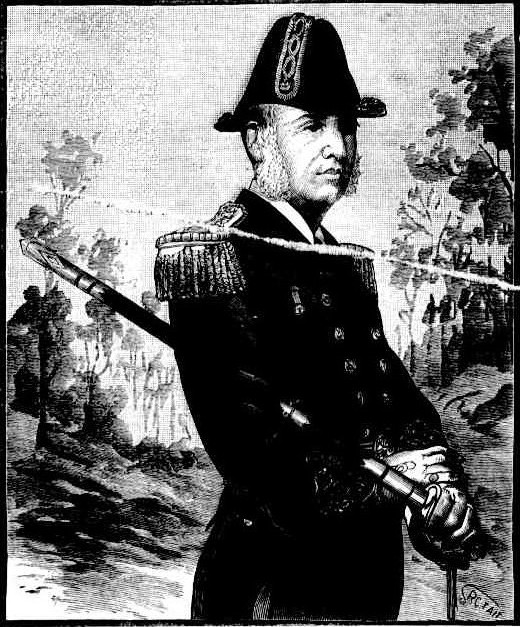 Captain Hixson, R.N.
Captain Hixson, R.N.PASSING OF THE NAVAL BRIGADE.
Officers of the Naval Brigade on Board H.M.C.S. Wolverene.
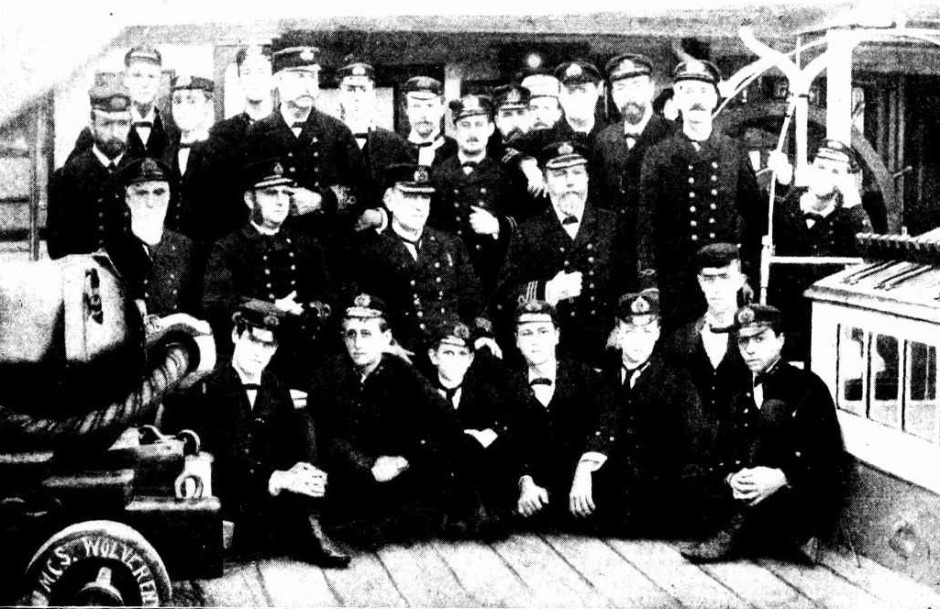
Back Row (Left to Right): Lieut. H. Gilfillan (deceased), Midshipman Harley Hixson (deceased), Midshipman H. Binnie, Cadet. .J. S. Cape, Lieut. F. J. Jackson. Midshipman R. S. Lambton, Midshipman G. Banks, Lieut. Victor Cohen, Staff-Surgeon Mailler-Kendall, Lieut. Alfred G. Milson, Lieut. E. H. Connor (deceased), SubLieut. W. Broomfield (deceased),
Centre Row: Lieut. Q. L. Deloitte, Commander G. L. Lindeman (deceased), Captain Francis Hixson (deceased), Commander A. .J. Lewington (deceased), Midshipman S. W. Spain.
Front Row: Cadets W. Johnston, H. F. Milford, V. G. Lindeman, C. .Jackson, G. M'cFarland, F. Hitchins, and Lewington.
When the photograph was taken Sub-Lieut.s. F. W. Hixson and H. O. N. Hixson were on duty on the bridge. The only two members of this group on the strength of the brigade at its disbandment the other day were Commander (then Midshipman) S. W. Spain, V.D., who has over 40 years' service to his credit, and Commander (then Midshipman') R. S. Lambton.
Captain Francis Hixson, R.N.,Who away back in 1862 founded the Royal Australian Naval Brigade, which he commanded for about -10 years, maintaining the closest interest in the force until his death. To his fine personality, his enthusiasm and keenness was largely due the wonderful esprit-de-corps that characterised the brigade throughout its existence, which ended on June 30, when the force was disbanded. The brigade did fine work in inculcating a naval spirit in the community, and its passing is regretted by many who think that, even under the new conditions, there was room for an organisation of this kind. The group shown on this page was photographed on board H.M.C.S. Wolverene, which was given to New South Wales by the British Admiralty in 1882, and was practically handed over to the Naval Brigade by the Government. The brigade provided a force of 28..? officers and men for service in the Boxer rebellion in China in 1900 and in The Great War The men and officers served at Rabaul. The death-warrant of the brigade was practically signed on the establishment of the Commonwealth, the Royal Australian Navy having been recruited since then from the ranks of the compulsory trainees. Since 1902 the brigade had been known as a reserve of naval volunteer artillery. KURING-GAI RED CROSS HOME—PASSING OF THE NAVAL BRIGADE. (1920, July 14). Sydney Mail (NSW : 1912 - 1938), p. 10. Retrieved from http://nla.gov.au/nla.news-article159040163
And then modifications
To celebrate Queen Victoria's Golden Jubilee in 1887, the first Colonial Conference was held in London with the premiers of the Australian colonies in attendance. The New South Wales Premier Henry Parkes did not attend. New South Wales was preparing celebrations to take place in 1888 to celebrate the centenary of the arrival of the First Fleet. One of the changes to come out of this conference though was the parliaments of the colonies agreed to the Australasian Naval Forces Act to maintain an auxiliary fleet at joint expense of Britain and the colonies in addition to the normal strength of the Imperial fleet on the Australian Station: The Australasian Naval Force Act 1888 Act No: 1888 (51 Vict. No. 25)- Assent Date: 07 Jan 1888 - available HERE
GOVERNMENT GAZETTE. The following official notifications were published in yesterday's Government Gazette:—
APPOINTMENTS.-Mr. Francis Hixson, captain commanding the Naval Brigade, to be captain commanding the naval forces of the colony. Volunteer Naval Artillery :Lieutenant George Stanley Bosanquet, R.N. (retired), to be commander. First Lieutenant Samuel Denton to be transferred from No. 2 to No. 1 Company Grafton Reserve Volunteer Infantry as second lieutenant, vice Bawden. GOVERNMENT GAZETTE. (1888, October 11). The Sydney Morning Herald (NSW : 1842 - 1954), p. 3. Retrieved from http://nla.gov.au/nla.news-article13699194
1888 was also a year when one of the few complaints levelled against the Marine Board was taken to another court. While speaking wiht Tim Hixson, Great-grandson of Captain Hixson, and a Pittwater gentleman too, he related some family anecdotes that may not appear in official histories, one of which was
"You may be aware that two of his daughters married Fairfax sons. One of the first jobs he did when in charge of Ports was go to the Clarence River to investigate a claim where a chap was suing the government for 10 thousand pounds. He investigated it and got it reduced to one thousand pounds. But the chap who lost the nine thousand pounds then went on to be Governor of NSW or some other association with government, and had a set against Captain Hixson but due to two of his daughters marrying Fairfax sons the persecutions this chap then levelled against him never appeared in any papers as these, then, were the history and records for that time. Some say he never received promotion due to this episode or incident. This is why his history isn’t clear cut, although he as clearly a fantastic man."
In the Law listings in the periodicals of the time, the item is listed as JEANNERET Vs. HIXSON - and this is the Mr. Jeannerett who began the Newport Hotel, seemed to hold a lot of political sway, and had taken Captain Hixson to The Laying of the Foundation Stone at Barrenjoey. This case is one of the few times we can hear how Captain Hixson wrote and spoke without it being related through second-hand reporting and it it concerns a one of Mr. Jeanerett's steamers hitting and sinking another on the harbour:
Mr. JEANNERET V. THE MARINE BOARD REGULATIONS.
TO THE EDITOR OF THE HERALD.
Sir,-Referring to Mr. Jeanneret's letter in your issue of today, which I shall not attempt to reply to in detail, nor endeavour to defend the Marine Board against, I must, nevertheless, point out that I fear my friend and all the other ferry boat owners and builders in the port, except the North Shore Ferry Company, will not get credit for consistency in the matter of the objections therein raised against the placing of bulkheads in ferry steamers when ... the public, through your columns, that there are several wooden steamers designed and being built at the present time with bulkheads exactly in accordance with the Marine Board requirements.
Now that I have taken up my pen to address you on the subject, perhaps you will allow me to write a word or two on the Marine Board side of this important matter.
We have always been impressed with the special necessity for taking all possible means to protect the lives and secure the comfort of the large number of persons who travel in the ferry steamers of Port Jackson. There are at the present time no less than 30,000 persons who daily cross the harbour in pursuit of their various avocations, and this number is largely increased by pleasure seekers during holiday times.
Not long since the ferry-steamer Waratah, on her return trip from the North Shore, where she is said to have landed several hundred passengers, was run into and sunk by the steamer Emu. Fortunately, there were only a few people on board at the time, and they were all rescued before the vessel went down, but it is appalling to think what would have been the loss of life if the collision had occurred a few minutes previously.
It is pretty generally known that before steamers are allowed to carry passengers they are obliged by law to procure certificates periodically, i.e., six-monthly, from the Marine Board, certifying to their capacity and the sufficiency and good condition of their hulls and fittings to perform the service required of them, so that the Board becomes responsible in point of fact whilst these certificates have currency for the fitness of the vessels to perform this work to the satisfaction and safety of the travelling public
¡inch being the case, the Board is bound to take all reasonable steps to secure the public safety, and, after mature deliberation, it decided to notify to the proprietors of the harbour steamers which do not carry cargoes, and which will not therefore be inconvenienced by having their holds crossed with bulkheads, that when their present certificates expire after the 1st September, and new ones are required from the Board. It will not be satisfied of the sufficiency and good condition of the hull and fittings of such steamers, and Will not therefore renew or ¡issue a passenger certificate, unless the steamers are fitted with bulkheads.
The fitting of these bulkheads will cost on an average about £30 for each steamer. The vessels will not be cut into or injured in any way, but, on the contrary, will be strengthened by the process of putting them in, and when once fitted no further trouble will be necessary in the matter. Even supposing they are not kept perfectly watertight, they can certainly be preserved in such a way that in place of a vessel sinking suddenly, as in the case of the Waratah and other craft that could be mentioned, she will be made to float after collision or other casualty sufficiently long to be run ashore, or receive assistance from passing vessels.
A great outcry has been raised against the regulation that the Board has recently made about the reduction of speed in certain parts of the harbour. This has arisen in consequence of the incorrect rumours that have been circulated.
The Board never had any desire to reduce the speed of harbour steamers elsewhere than in the narrow waters of Sydney Cove and upper part of Darling Harbour, where the navigation is so great as to make it positively dangerous to proceed at a speed greater than six knots. This reduced speed will certainly not delay passengers to any material extent on their way to business, and the regulation is really necessary in the interest of the public safety.
I am, &c
FRANCIS HIXSON.
Marine Board Office, Sydney, August 6, 1888
MR. JEANNERET V. THE MARINE BOARD REGULATIONS. (1888, August 8). The Sydney Morning Herald (NSW : 1842 - 1954), p. 5. Retrieved from http://nla.gov.au/nla.news-article13692917
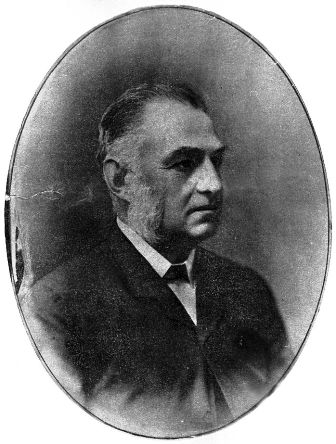 Sir,-May I be permitted to write a few words in reply to the letter of the respected president of the Marine Board, which appeared in your issue of 8th instant Captain Hixson must have been greatly misinformed when he arrived at the conclusion that "there are several wooden steamers designed and being built with bulkheads, exactly in accordance with the Marine Board requirements " If that be so, so much the worse for the regulations, because I know the steamers he refers to. They have been designed, and one of them is being built for the Parramatta River, and partly out of deference to the wishes of the Marine Board, but more particularly to suit the convenience of passengers, by keeping the heat of the engine-room and stoke-hole out of the cabins, two bulkheads are being made, hut they are not expected to be " water tight " and it is quite certain that they will not keep the vessel afloat a single instant in cases he is seriously damaged between them It is, therefore, difficult to see how that is a compliance with the Marine Board regulation, which states that these bulkheads shall be "sufficient to keep the vessel afloat in case of serious collision 0r other casualty " I believe these bulkheads are likely to have the very opposite effect to that desired by the Marine Board, because they will limit the lun of the water into the two ends of the vessel, and cause the middle compartment, with all the machinery, to fill and sink more quickly I may say, however, for the information of the Marine Board, that there is being placed in the vessels that which is not required by the regulations, but which ought to be in every wooden vessel, as well as it is in the a on ones-v IZ , a collision bulkhead near the stem of the ship, which, in case of collision is always a great protection to the striking vessel I do not refer fully to Captain Hixson’s defence of the board, because no one questions their desire to protect the public What is denied is that they have the requisite knowledge as to how to do it, or the proper understanding of their position under the law. If Captain Hixson is right in the position he takes up on this matter, the steamboat owners and the public must be a lot of simpletons not to do just as he asks, but the fact is they have already been put to great and useless expense by the fads of the board, notably in having to fill up much of their limited cabin space with piles of life-belts and buoys for passengers in little steamers, and "plentiful supplies of lifebuoys about, the docks," requirements which are laughed at by the marine boards of other places.
Sir,-May I be permitted to write a few words in reply to the letter of the respected president of the Marine Board, which appeared in your issue of 8th instant Captain Hixson must have been greatly misinformed when he arrived at the conclusion that "there are several wooden steamers designed and being built with bulkheads, exactly in accordance with the Marine Board requirements " If that be so, so much the worse for the regulations, because I know the steamers he refers to. They have been designed, and one of them is being built for the Parramatta River, and partly out of deference to the wishes of the Marine Board, but more particularly to suit the convenience of passengers, by keeping the heat of the engine-room and stoke-hole out of the cabins, two bulkheads are being made, hut they are not expected to be " water tight " and it is quite certain that they will not keep the vessel afloat a single instant in cases he is seriously damaged between them It is, therefore, difficult to see how that is a compliance with the Marine Board regulation, which states that these bulkheads shall be "sufficient to keep the vessel afloat in case of serious collision 0r other casualty " I believe these bulkheads are likely to have the very opposite effect to that desired by the Marine Board, because they will limit the lun of the water into the two ends of the vessel, and cause the middle compartment, with all the machinery, to fill and sink more quickly I may say, however, for the information of the Marine Board, that there is being placed in the vessels that which is not required by the regulations, but which ought to be in every wooden vessel, as well as it is in the a on ones-v IZ , a collision bulkhead near the stem of the ship, which, in case of collision is always a great protection to the striking vessel I do not refer fully to Captain Hixson’s defence of the board, because no one questions their desire to protect the public What is denied is that they have the requisite knowledge as to how to do it, or the proper understanding of their position under the law. If Captain Hixson is right in the position he takes up on this matter, the steamboat owners and the public must be a lot of simpletons not to do just as he asks, but the fact is they have already been put to great and useless expense by the fads of the board, notably in having to fill up much of their limited cabin space with piles of life-belts and buoys for passengers in little steamers, and "plentiful supplies of lifebuoys about, the docks," requirements which are laughed at by the marine boards of other places. The Boxer Rebellion
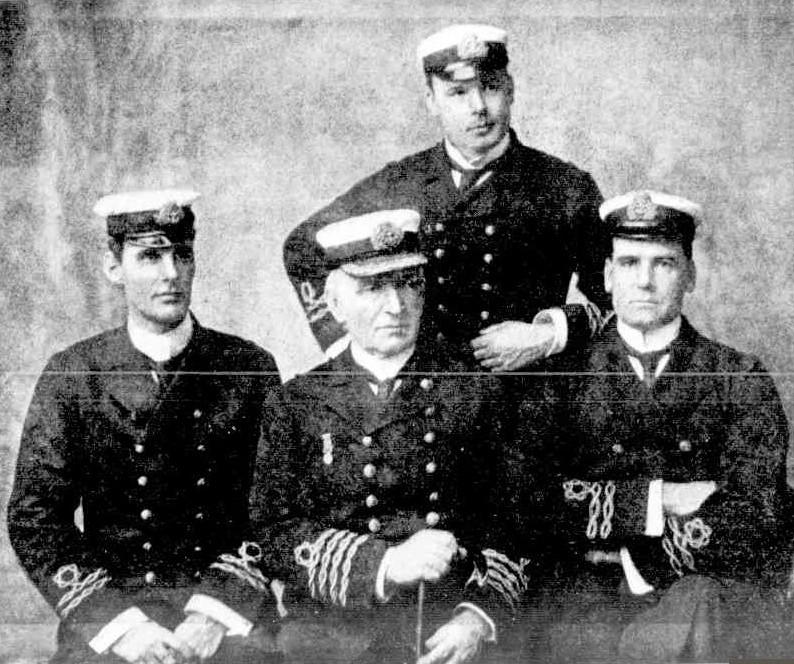
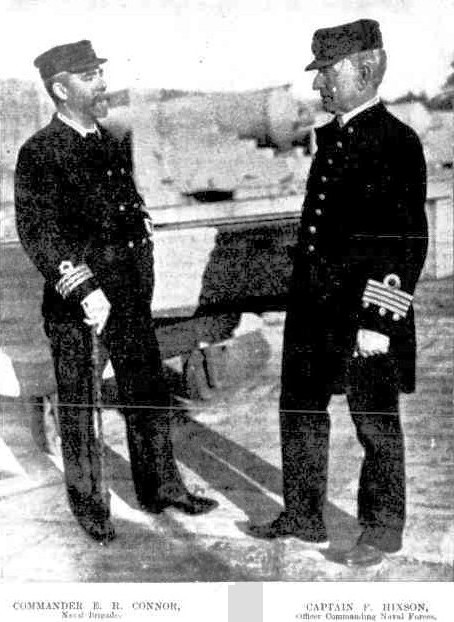 Right: COMMANDER E. R. CONNOR, Naval Brigade. CAPTAIN F. HIXSON,Officer Commanding Naval Forces. THE LATE KING OF ITALY. (1900, August 4). The Sydney Mail and New South Wales Advertiser (NSW : 1871 - 1912), p. 273. Retrieved fromhttp://nla.gov.au/nla.news-article163692265
Right: COMMANDER E. R. CONNOR, Naval Brigade. CAPTAIN F. HIXSON,Officer Commanding Naval Forces. THE LATE KING OF ITALY. (1900, August 4). The Sydney Mail and New South Wales Advertiser (NSW : 1871 - 1912), p. 273. Retrieved fromhttp://nla.gov.au/nla.news-article163692265 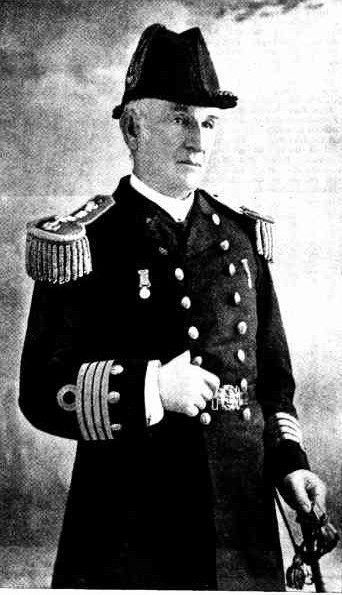 Right: Photo, by Freeman and co. Captain Franon Hixson, R.N. THE N.S.W. NAVAL CONTINGENT FOR CHINA. (1900, August 11). The Sydney Mail and New South Wales Advertiser (NSW : 1871 - 1912), p. 323. Retrieved from http://nla.gov.au/nla.news-article163693318
Right: Photo, by Freeman and co. Captain Franon Hixson, R.N. THE N.S.W. NAVAL CONTINGENT FOR CHINA. (1900, August 11). The Sydney Mail and New South Wales Advertiser (NSW : 1871 - 1912), p. 323. Retrieved from http://nla.gov.au/nla.news-article163693318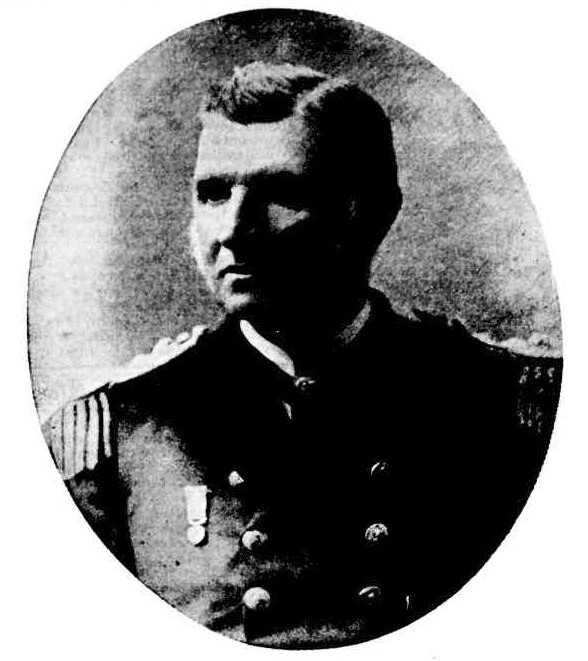 Captain Francis Hixson,
Captain Francis Hixson,Medals for China and first reunion:
The China Naval Contingent.
PRESENTATION OF MEDALS.
(See Illustration's on next page.)
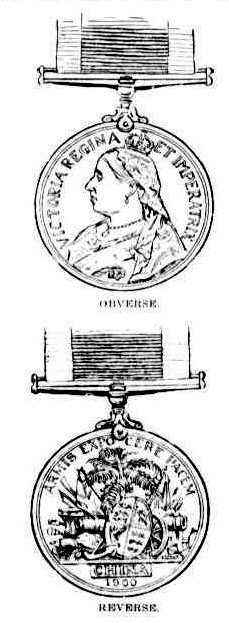 The Governor-General of the Commonwealth. on Saturday afternoon presented to the members of the N.S.W. Naval Contingent the China war medals; Comparatively little interest was evinced In the proceedings, which took place in the Inner Domain, Sydney.
The Governor-General of the Commonwealth. on Saturday afternoon presented to the members of the N.S.W. Naval Contingent the China war medals; Comparatively little interest was evinced In the proceedings, which took place in the Inner Domain, Sydney.
A marquee was erected on the lawn tennis ground in the vicinity of which a moderate crowd of Interested onlookers assembled. The members of the naval forces, who appeared in summer uniform, collected In front of the Custom House, Circular Quay, at 2.15, and, with those of the contingent, who did not retain their association with the brigade, marched under the command of Lieutenant-Commander Brownlow to Government House grounds.
The brigade was headed by the Band of the Naval Forces, under Bandmaster Devlin, and on arrival, the members of the contingent detached themselves from the main body, the latter proceeding' to where arrangements had been made for the presentation to take place. Here they formed Into three sides of a square, fronting the marquee, and a little later those entitled to the medals were lined up in the foreground.
The officers in charge of the Brigade were: Lieutenant Williams, Staff-Paymaster Ross, Sub- Lieutenants Alcock, Coggins, Stephens, and Read, while those in charge of the Contingent were Lieutenants H. O. N. Hixson. Lambton, Spain, Roberts, Lindeman, and Sub-Lieutenant Black.
Shortly before 3 o'clock, Lord and Lady Tennyson made their appearance, accompanied by Lord Richard Nevill, A.D.C., Vice-Admiral Fanshawe, Brigadier-General and Mrs. Finn, and a number of officers and ladies. The band having played the National Anthem, the Governor-General at once proceeded to address the men.
His Excellency said:-"I have much pleasure in handing these medals to you - to you the members of the Naval Brigade of New South Wales, who came forward so gallantly and served In China with our British naval forces. I know you were glad to go, because you were proud of being associated with the navy, and be-cause you are proud of your forefathers, the great seamen who made the British Empire what it is, and whose traditions you inherit. The splendid history of our gradual growth, of freedom-the widest the world has ever seen-is as much the heritage of you here as it is of us in the United Kingdom. By the new naval agreement you will come under the direct command of His Excellency the Naval Commander-in-Chief of Australasia, and when Parliament passes this
agreement you will be able to have all that the latest naval science can teach ' you. The Admiral has just told me that the feeling at the Admiralty is this: That you men will be warmly welcomed when you form an integral part of this naval system, by your comrades in the mother country; and I am certain you your-selves will always live up to the great saying of Nelson. "England expect every man to do his duty." If only the people of our race, with their high sense of duty, of justice, of honour, and with their broad common sense, would stand shoulder to shoulder, I cannot help thinking that the cause of civilisation and humanity will continually progress throughout the world, surely and truly.
Admiral Fanshawe said: I wish to tell you that I came here with the greatest pleasure to-day, at the kind if the gallant China Brigade. I came here as the representative of that great service, the traditions and the glorious history of which is, I maintain, equally the possession and the heritage of every officer and man of this brigade, and I will ' go further and say of every Australian lad throughout Australia, as it is the possession and the heritage of every man In the old country. I see no difference whatever. I think we ought all of us to remember-and when I say all of us I mean all of us in the old country and In the sister nations, those free and independent nations which comprise the British Empire-that to remain free from foreign Interference and to manage our own affairs chiefly depends upon this grand old service, to which His Excellency the Governor-General has alluded in such touching, and, to me, such acceptable terms. There is one point I might mention, without tiring you, and it is this: I should like to mention that had the greatest, as I think I may say, of all soldiers and statesmen, Napoleon, been able without Interference to carryout his aims In 1798, and had those aims not been defeated by Nelson at the battle of the Nile-I think it is no exaggeration, and not too much to say, that it is a very doubtful matter whether this continent of Australia would solely, at any rate, be in the hands of our race to-day. Officers and men of the brigade. T wish, on behalf of the great service to which I belong, and which I have the distinguished honour to command in these seas, to congratulate you on the good discipline and Conduct, and the excellent behaviour shown by you, and on the additional honour which you have brought to Australia, besides the great honour that was 'brought by her gallant soldiers in South Africa. Should measures betaken in accordance with Australian sentiment and feeling-and I sincerely and earnestly hope such measures will very shortly be taken, in which will be included the formation of an Australian branch of the Naval Reserve, there will be open a road, and a way made smooth, by which In the future not only the gallant Australian soldiers, but the gallant Australian seamen, will have an opportunity of showing to the world. as their gallant comrades have shown In South Africa and in China, that they are second to none on the sea, as their gallant comrades have shown that they' are second to none on land. I will conclude by saying that In those measures, when completed, the members of the naval forces of the Commonwealth, who are qualified and who are allowed to enter, will be most heartily and warmly received by their fellow-British seamen in the old country. I think it is a double pleasure to me personally, if I may say anything personal on such an occasion, that very likely there may be some old shipmates of mine amongst the Naval Brigade. (A voice: "That is true.") And I hope I may become much better acquainted with them before I end my three years' service on this station.
His Excellency then presented the medals to the officers and men. This over, Lord Tennyson reviewed the Brigade, and at the conclusion cheers were given fdr the King, for His Excellency, and for the Admiral. The Brigade afterwards paraded through some of the principal streets of the city.
Some 300 medals, which, as will be seen by the illustrations, are of handsome design, were awarded to all of those officers and men who proceeded north of Hongkong. In the cases of Commander Connor and Staff-Surgeon Steel, of the contingent, both of whom are dead, the medals will be forwarded to their relatives. The following are the names of the officers:
Lieut. H. O. N. Hixson. Lieut. M. A. Roborts. Lieut. S. W. Spain. Lieut, R. S. Lambton, Sub-Lieut, V. G. Lindeman.Sub-Lieut. B. Black.Sub-Lieut. White.Sub-Lieut. Greer. Sub-Lieut, Gillam. Assistant-Paymaster G. Wynne. Assistant-Paymaster J. R. Wallace.Midshipman Bracegirdle, Midshipman Murnin, Midshipman Walker, Lieut. H. Lofts (Marines). The China Naval Contingent. (1903, April 29). Australian Town and Country Journal (Sydney, NSW : 1870 - 1907), p. 22. Retrieved from http://nla.gov.au/nla.news-article71480776
CAPTAIN FRANCIS HIXSON, late R.N., died at his residence, 'Wordsley,' Double Bay, on Tuesday, 2nd inst. He was a fine type of the British naval officer. Captain Hixson looked his part much in the same way that Sir Frederick Darley looked his bench. First impressions of him were always favourable, and experience set the seal upon them. He was a man of notable, if not remarkable, qualities. From his boyhood he had 'followed the sea,' and he always had the wholesome personality of a sailor. On naval matters he spoke with authority— we use the word authority in a double sense, for Captain Hixson had strong views on public and particularly Empire questions.
His training had qualified him for the positions that fell to his lot in New South Wales . He was born at Swanage, in Dorsetshire, in 1833. As a boy he joined the navy, but it cannot be said that at this period of British Empire building there was much chance of rapid promotion. Instead of the navy costing £30,000,000 to £35.000,000 yearly the amount was about £4,000.000; and instead of 150,000 men on full pay there were about 30,000.
When young Hixson was getting his training less than 50 years had passed since Trafalgar, and in his boyhood the most powerful British warship did not differ materially from Nelson's Victory. There were a few steamers, but Britain had only recently built them; they were of 850 tons, and were called steam sloops. The Queen, the greatest warship Britain had when he was just about going to school, cost £115,000. The time came when he was interesting himself in battleships costing a million and a half sterling. He looked from the era of wood, hemp, and canvas, and 32, 24, and 12 pounders, to the era of steel ships and of 12-inch guns— from a period when 'wooden walls' were lashed together and boarding with the cutlass settled the struggle, to a period when miles of sea extend between the fighting fleets. His own part as a naval officer was useful.
As we have indicated, Britain, when he was young, was without a worthy foe; the naval operations of the time consisted of expeditions against petty Eastern countries that hampered British traders, until the Russian war broke out, and by that time he was in Australia. Indeed, he was only a boy when he arrived in Sydney. He came as assistant-master on H.M.S. Havannah (Captain Erskine). It must be noted that there have been great changes in the titles of the navigating officers of the navy. In the early days the titles ran master, second master, and master's assistant. Forty years ago these titles went, and we have staff commanders, and navigating lieutenants, sub-lieutenants, and midshipmen. Mr. Hixson went on the Havannah to the islands, and later on was selected for a commission in H.M.S. Herald, which, with H.M.S. Torch, was sent away under the command of Captain Sir Henry Denham, F.R.S., to survey and take possession of New Caledonia. It was like the Australian proposal to plant the flag in New Guinea— the enterprising foreigner had fortune on his side. The French had marked New Caledonia for their own. Soon afterwards, H.M.S, Torch was disposed of by the Imperial Government, but H.M.S. Herald remained in Australian waters, and did excellent work in surveying.
In 1853 Captain Hixson received the Royal Humane Society's silver medal for his brave rescue of an A.B. who fell overboard in Shark Bay, Western Australia. The name of the bay suggests the danger that was run. So far as active stirring service was concerned fortune did not regard him with a favouring eye. Always spirited, undoubtedly (as he had shown) a courageous officer, fate kept him in Sydney news of impending war or of anything else was slow in coming in the fifties— while many of his fellow juniors— be it noted he was still quite young— were pounding at Odessa and Sebastopol. Whatever his regrets that he had missed service with Dundas or the brave Sir Charles Napier, he settled down with earnestness to giving the best of his service to the colony of New South, Wales.
His were to be the triumphs of investigation, of science, and of administration. He had, now, for some years, been engaged in surveying the coast of Australia. In 1861 the Imperial and colonial Governments jointly appointed him chief assistant to Commander Sidney. R.N., who was surveying the coast of New South Wales.
In 1863, at the age of 30, he resigned his commission, as master in the Royal Navy, and accepted the appointment of Superintendent of Pilots, Lighthouses, and Harbours. He gave such admirable service that the Government of the then colony offered him the presidency of a new tribunal—the Marine Board. This was in 1871, and until 1900 Captain Hixson presided over many cases of marine disaster. His record in that capacity is a monument to his ability. He showed expert knowledge, judicial wisdom, and—as many an unlucky mariner will testify —a kindly heart. When the Marine Board gave way to the Court as constituted today, with a Judge and two assessors, there was nothing but well-deserved praise for the work done by the president — work which gave a Court of Appeal nothing to do. But this was not all his service 'to New South Wales.
He was the recognised authority on all matters having a maritime incidence. When appointed President of the Marine Board he was 38 years of age, but eight years before he had won commendation for his efforts to establish a volunteer naval brigade. He was the father of Australia's navy — the navy that is a burning topic to-day. The brigade was formed by his personal exertions, and he was gazetted captain commanding from May 1, 1862. (in 1902 he resigned when the Federation took over defence).
The time came when the colonists had an idea that the Russians were about to invade, or at least bombard, the coast. The dignified, capable, courteous officer, who had been disappointed times out of number by apathetic Governments, at once became one of the most important figures in Sydney. This period in our history saw the presentation of the H.M.S. Wolverine to New South Wales, the establishment of the Naval Artillery Volunteers, and the purchase of the torpedo-boats Avernus and Acheron. After some delay, part of the time being occupied by a trip he made to England, Captain Hixson became 'Officer Commanding the Naval Forces of New South Wales.'
In 1900 he made the Government of the day see the wisdom of sending a naval contingent to China. He organised it, and saw to every detail. He felt very much that he was unable— he was then 67 years of age — to command the contingent on the march to Peking. On arrival in Hongkong he handed over the command to Lieut. Gillespie, R.N.
He made another trip to England, but his work was nearly done. The news of his death early last week was received with deep regret. His funeral on Wednesday last was largely attended. It was principally of a naval character. The chief mourners were:— Mr. F. W. Hixson andMr. H. O. N. Hixson (sons), and Mr. G. E,Fairfax and Mr. J. O. Fairfax (sons-in-law).The deceased gentleman is survived by his widow (a daughter of the late Hon. Francis Lord, M.L.C.), three daughters (Mrs. G. E. Fairfax, Mrs. J. O. Fairfax, and Mrs. M'Cay, wife of Dr. M'Cay, of Calcutta), and three sons (Messrs. F. W., E. M., and H. O. N. Hixson).
Captain Hixson's life was a full one— it was a purposeful career that held him safely in public and private esteem. We have by no means mentioned all his important public work. The Royal Naval House, for instance, will long remember him. His experience and his years made him a picturesque and commanding figure. Looking along the span of his life we are invariably drawn back to the days when the name of Nelson was on the lips of men who had known him. The boy Francis Hixson probably saw one or two of Nelson's former flag officers— certain it is that some of the juniors a little older than himself had seen Thomas Masterman Hardy. Although the centenary has been celebrated, we are brought that close to Trafalgar; and Captain Hixson was a direct link with this, stirring past.
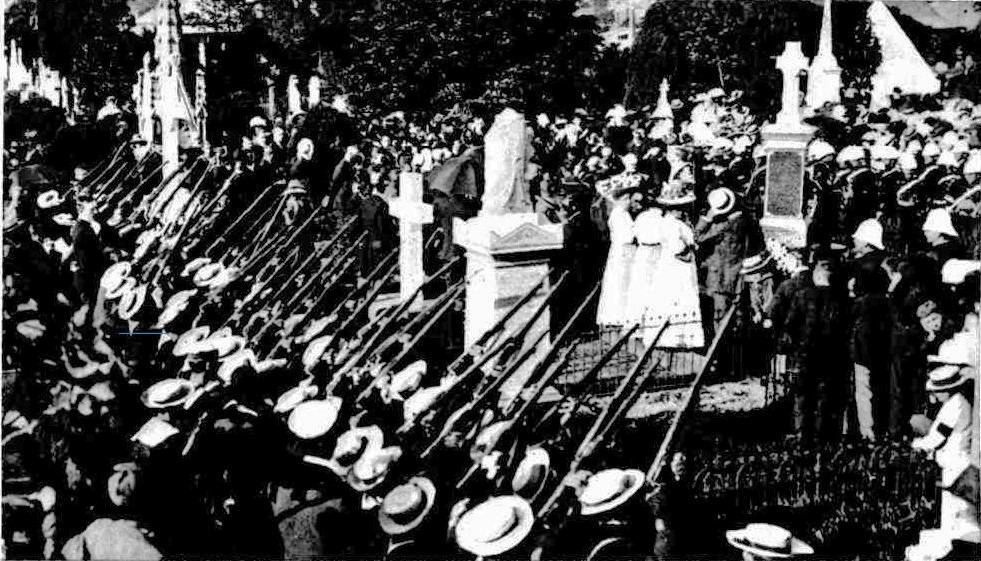
FUNERAL OF THE LATE CAPTAIN HIXSON, FORMERLY R.N. At St. Thomas's Cemetery, North Sydney. A detachment of the Naval Brigade firing three volleys at the grave; the bugler sounding the 'Last Post.'
A Naval Funeral: The Late Captain Hixson. (1909, March 10).The Sydney Mail and New South Wales Advertiser (NSW : 1871 - 1912), p. 30. Retrieved from http://nla.gov.au/nla.news-article163289271
Photo, by Freeman. THE LATE CAPTAIN FRANCIS HIXSON.
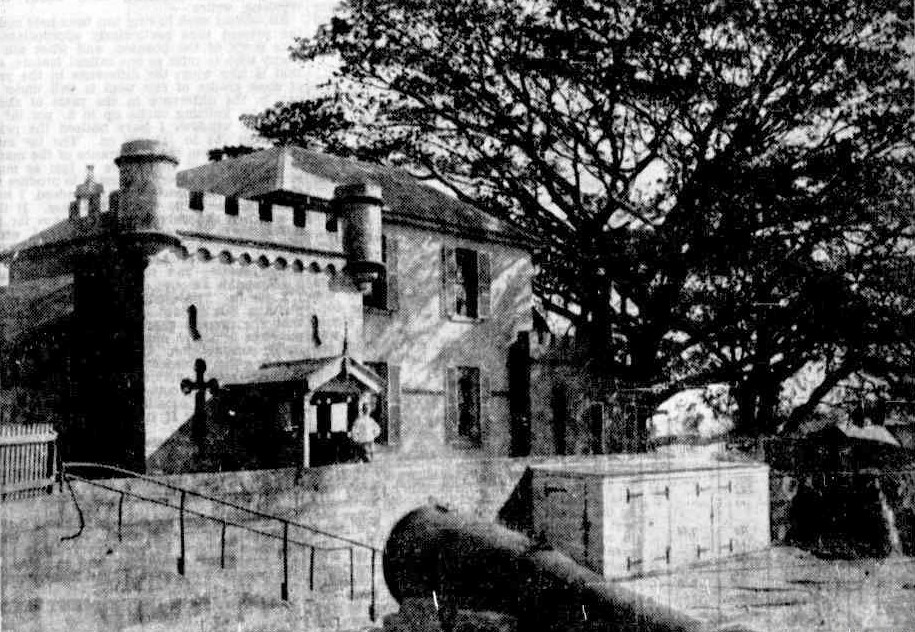
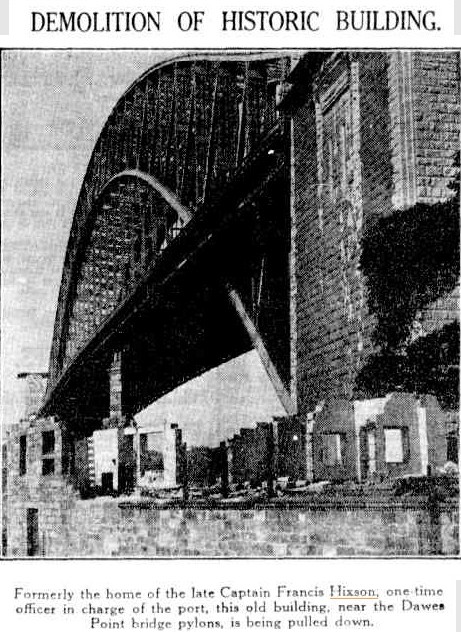
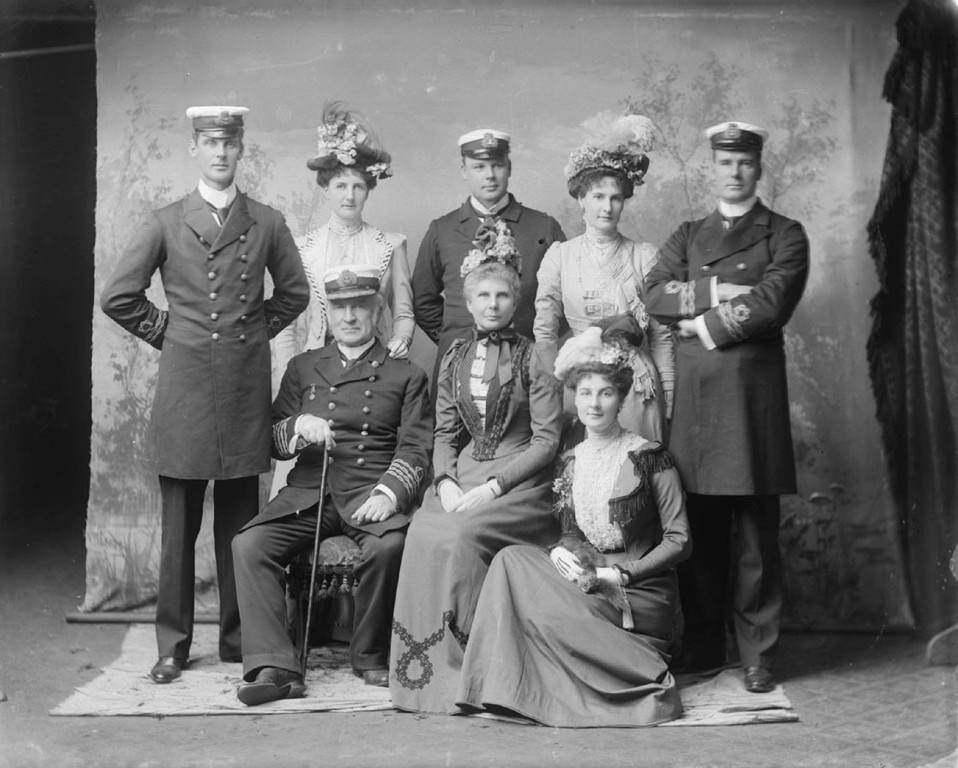
Taken just prior top leaving for Singapore - Boxer Uprising 1900 (Some sources state Edward was serving with the Queensland Naval Contingent, and this is why is is not present in this family photograph.) Back Row, Left to right - (Back): Harley, Annie, Herbert, Mabel Francis William. Front Row; Francis (Snr.), Sarah, Florence.
Among the officers in the brigade are three of his sons, two of whom have been appointed to the commands of companies. Another of the captain's sons is in command of the naval force at Bundaberg, Queensland. Each of these officers joined the ranks as a junior and has worked his way up by steady application and study. Captain Hixson was yesterday the recipient of many congratulations upon his appointment to the command, and among the men who compose the brigade the fact of their proceeding by the Salamis with their comrades from Victoria under the command of their old chief is intensely acceptable to them. CAPTAIN F. HIXSON, R.N. (1900, August 3). The Sydney Morning Herald (NSW : 1842 - 1954), p. 5. Retrieved from http://nla.gov.au/nla.news-article14328174
Edward Manwell Hixson, grandfather of Pittwater's own Tim Hixson, was certainly in Bundaberg at this time as Engineer to Bundaberg Harbour Board
On Saturday morning (says the Bundaberg. Says..of April 30) there were about 100 persons present at the new slipway just completed by the harbour board fox the purpose of witnessing an attempt to place the recruiter Rio Loge thereon, preparatory to undergoing an overhaul. Unfortunately, owing to the hurry und bustle entailed us the result of the trial following so closely on the handing over of the slip by the contractor, a 'new guiding rope which the engineer had not time to thoroughly stretch was used, and owing to what nautical men term a " half-crown " or kink forming therein, it snapped when the strain, was placed upon it. This, however, did not deter Mr. Hixson, and he shortly afterwards made a second attempt to get the cradle under the vessel by attaching a rope to one of the dolphins at the foot of the slip, but owing to the purchase having to be made at an angle, the consequence was that the carriage became derailed, thus putting a stop to any further attempts for that day. The work of placing the carriage, which weighs 125 tons, in position again, was somewhat difficult, but was successfully achieved by 6 o'clock the same afternoon. Another trial to slip the Rio Loge will be made this morning. Provincial Pickings. (1900, May 2). The Telegraph (Brisbane, Qld. : 1872 - 1947), p. 3 Edition: SECOND EDITION. Retrieved from http://nla.gov.au/nla.news-article173533313
Family
Births
On the 29th instant, at her residence, William street, the wife of Francis Hixson, Esq., R.N., of a son. Family Notices. (1862, July 31). The Sydney Morning Herald(NSW : 1842 - 1954), p. 1. Retrieved from http://nla.gov.au/nla.news-article13232077 - Francis William
HIXSON—November 13th, at Crown-street, Miller's Point, the wife of Francis Hixson, Esq., R.N., of a son. Family Notices. (1863, November 21). The Sydney Morning Herald (NSW : 1842 - 1954), p. 7. Retrieved from http://nla.gov.au/nla.news-article13086571 -Edward Manwell
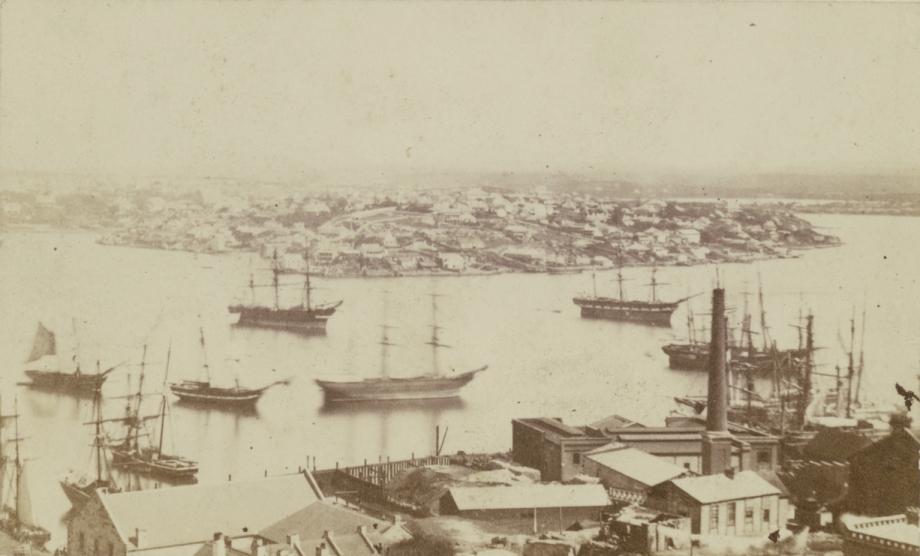
Millers Point, Darling Harbour, circa 1863-1869 - Sydney : Edward Turner; "Edwd. Turner, engraver, printer & stationer, 26 Hunter Street, Sydney" -- printed label on reverse, Image No.: a325003, courtesy State Library of NSW.
HIXSON—June 25th, at Branksea, Balmain, Mrs. F. Hixson, of a son, which only survived its birth a few hours. Family Notices. (1865, July 21). The Sydney Morning Herald(NSW : 1842 - 1954), p. 8. Retrieved from http://nla.gov.au/nla.news-article13116435
HIXSON—July 16th, at Branksea, Balmain, the wife of Francis Hixson, Esq., of a son. Family Notices. (1866, July 23). The Sydney Morning Herald(NSW : 1842 - 1954), p. 8. Retrieved from http://nla.gov.au/nla.news-article13134245 - Herbert Onslow Nares
HIXSON—January 9th, at Branksea, Balmain, the wife of Francis Hixson, Esq., of a son. Family Notices. (1868, February 1). The Sydney Morning Herald (NSW : 1842 - 1954), p. 9. Retrieved from http://nla.gov.au/nla.news-article28609171 - Harley Lord
No. 12 Johnston Street was originally a single storey house but enlarged by Captain John Lyons in c1860 and called "Branksea".
On the 9th instant, at St. Leonards, North Shore, the wife of Francis Hixson, Esq., of a daughter. Family Notices. (1869, December 10). Evening News (Sydney, NSW : 1869 - 1931), p. 2. Retrieved from http://nla.gov.au/nla.news-article107128031 - Annie Madeleine Mary
On the 13th instant, at Dawes Point, the wife of FRANCIS HIXSON, Esq., of a daughter. Family Notices. (1871, November 14). The Sydney Morning Herald (NSW : 1842 - 1954), p. 1. Retrieved from http://nla.gov.au/nla.news-article13247797 - Mabel Alice Emmeline
HIXSON—June 2, at Dawes' Battery, the wife of Francis Hixson, Esq., of a daughter. Family Notices. (1873, June 14). The Sydney Morning Herald(NSW : 1842 - 1954), p. 9. Retrieved from http://nla.gov.au/nla.news-article13313610 - Florence Howard
Marriages of Children:
FAIRFAX-HIXSON.-April 7, at St. Andrew's Cathedral, Sydney, by the Very reverend the Primate, Geoffrey Evan, second son of James Reading Fairfax, of Sydney, to Anne Madeleine Mary, eldest daughter of Captain Hixson, R.N.,Commander of the Naval Forces of New South Wales and President of the Marine Board. Family Notices. (1891, April 18). The Sydney Morning Herald(NSW : 1842 - 1954), p. 1. Retrieved from http://nla.gov.au/nla.news-article13821453
Weddings - Fairfax— Hixson.— On Tuesday last, at St Andrew's Cathedral, Mr. Geoffrey Evan Fairfax, of the firm of Messrs. John Fairfax and Sons, and second son of Mr. James Reading Fairfax, was married to Miss Hixson, eldest daughter of Captain Hixson, Commander of the Naval Forces of New South Wales and President of the Marine Board. The choir chancel, Bishop's throne, and pulpit were decorated with evergreens and flowers, -in- which white and yellow blossoms were pleasantly conspicuous, and the ivy wreathing the stalls reserved for the guests completed the artistic floral ornamentation. The choral service was conducted by the Rev. A. R. Rivers, precentor. Mr. Montague Younger presided at the organ, and the music included ' Wedding Bells' and a ' Bridal March' composed by the organist, the march specially for the occasion. The hymn, 'The Voice that breathed e’er Eden,' was sung before the arrival of the bride. The ceremony was performed by the Primate and Bishop of Sydney (the Right Rev. Dr. Saumarez Smith),assisted by the 'Venerable Archdeacon of Cumberland and the Rev. K. L. King, B.A.; and a distinguished company of more than a hundred friends and relatives assembled at the Cathedral. The bridegroom was accompanied by his brother, Mr. J . O. Fairfax, as best man, and the bride, who entered the church at the western door, was conducted by her father and attended by her two sisters as bridesmaids. The bridal toilette consisted of a trained gown of ivory white arranre royale over a petticoat of satin brocade, the design- lilies of the valley. The sleeves were of white chiffon, puffed lengthways from the wrist to the shoulder; orange blossom and a jabot of chiffon on the bodice; a girdle of pleated chiffon worn round the basque fell low on the left side; long tulle veil, fastened with a diamond star; very large bouquet of Eucharis lilies, white hyacinth, stephanotis, white cesmos, Spirea Japonica, all vailed with Farleyanne and other choice hothouse foliage. The bridesmaids wore white dresses of spotted Liberty silk with full sleeves of chiffon; fancy open straw hats, cream- tinted, covered with feathers. They carried lovely posies of autumn leaves and cream chrysanthemums. The floral arrangements were all made by Messrs. Searl and Sens. The bride's travelling gown was of light-grey tweed, with New Market coat. The guests included the Lieutenant-Governor, Sir Alfred Stephen, G.C.M.G., and the Hisses Stephen, the Primate and Miss Snowdon Smith, Sir George and Lady Innes, Sir John Hay, Lady and the Misses Martin, Mr. and Mrs. Charles B. Fairfax, Mr. and Mrs. Armstrong', Mm. and Miss Austin, Mr. and Mrs. Black, Miss Btnnie, Commander Besanqnet, Mr.Beaten, Mr. and Mrs. Alfred Cape, Mrs. F. Cape,Mr. and Mrs. Carter, Mrs. and Miss Clibbom, Dr. and Miss Cox, Mr., Mrs., and Miss Cumow, Mr. SM Mrs., and Miss Cook, Mr., Mrs., and the Misses Dibbs, Mr. and Mrs. J. G. Fraser, Mr. and Mrs. Fisher, Mrs. Fitzsimone, the Misses Finch, Dr. Mrs. and Miss Garran, Mr. and Mrs. Neville Griffiths, Miss Gaden, Miss Gowland, Mrs. and the Misses Howard, Dr. and Mn. Jenkins, Mr. and Mrs. Johnson, Mr. and Mrs. Kerr, Captain and Mrs. Lindemann, Mr. and Mrs. F. Lord, Mr. and Mrs. C. Lord, Mr. and Mrs. Lark, Miss Living, Miss Lvons, Mr. and Mrs. Laidley Mort, Mrs. and the Misses Massie, the Misses Mayne, the Misses Mitchell, the Misses North, Dr. and Mrs. Fairfax Ross, Mrs. and the Misses Richardson, Mr. and Mrs. Edward Reading, Miss Rolleston, Mr. and Mrs. Schtles, Miss Scarvell, Mr. and Mrs. Prosper Williams, Mr. A. Allen,Mr. C. L. Austin, Mr, G. Belisari*, Messrs. Cape, Mr. Eden, Mr. Lachlan J. Forster, Mr. Holleston, Mr. Richardson, Mr. Rennius, Mr. Hunter Smith, Mr. St. George, Dr. Wilkinson, Mr. F. Wilkinson, Mr. Wardell, Mr. Watt. At the residence of the bride's parents after the ceremony the health of the bride and bridegroom was proposed by Sir Alfred Stephen, and that of the bride's parents by the Primate. Mr. and Mrs. Geoffrey Fairfax will be passengers by the Oretava for Europe. In anticipation of the event Which took place on Tuesday the members of the various departments of the Sydney Morning Herald, the Sydney Mail, and the Echo presented to Mr. G. E. Fairfax, oh Saturday last, a silver tea and coffee service upon a silver tray. Each article was engraved with the monogram of the bridegroom. In making the presentation, Mr. Samuel Cook said it was hoped that it would serve to awaken in the domestic circle of Mr. Geoffrey Fairfax occasional memories of the kindly relations which existed between him and his co-workers from the highest to the lowest. Weddings. (1891, April 11). The Sydney Mail and New South Wales Advertiser (NSW : 1871 - 1912), p. 807. Retrieved from http://nla.gov.au/nla.news-article163656727
Edward Manwell - 5620/1891 HIXSON, EDWARD M, SCHELL, LILIAN Blanche NARRANDERA - no published announcement found
Fairfax — Hixson. — On Tuesday, 22nd November, at St. Andrew's Cathedral, the marriage of Mr. James Oswald Fairfax, third son of Mr. James R. Fairfax, and one of the firm of Messrs. John Fairfax and Sons, with Miss Mabel Alice Emmeline, second daughter of Captain Hixson, R.N., President of the Marine Board and Commandant of the Naval Forces of New South Wales, was solemnised by the RightHev. Dr. Saumarez Smith, Bishop of Sydney and Primate of Australia, assisted by his chaplain, the Rev. Chaffers Welsh, and the Rev. R. J. Read, in the presence of a large assembly. The choir, chancel, and pulpit were artistically decorated with tall palms, ferns, and white flowers in which arum and Christmas lilies were conspicuous, and the effect combined with the white-robed choristers was very beautiful. The wedding party occupied seats near the chancel, and the guests filled several rows of seats in front of the nave. During the interval before the ceremony the Cathedral organist, Mr. Montagu Younger, played 'Wedding Bells' (his own arrangement),. ' No Jewell'd Beauty,' and the ' Commemoration March.' The first part of the service was conducted at the entrance to the choir, where the bridegroom, with his best man, Mr. F. B. Wilkinson, awaited the coming of the bride. About half-past 2 o'clock the bride entered with her father, and attended by her sister, Miss Florence Hixson, the choir singing 'The Voice that breathed o'er Eden.' The service was fully choral, the Rev. S. S, Tovey leading the voices. At the conclusion of the ceremony the choir sang 'Rest in the Lord,' and whilst the registers were being signed in the vestry the organist played the' Tannhauser March ' and, as the bride and bride- groom passed down the aisle, Mendelssohn's ' Wedding March.' The bride wore a gown of ivory satin Duchesse, made with court train from the waist, the skirt and train flounced on the inner side with Valenciennes lace, and the former having a full ruche of silk. A large bow of broad satin ribbon ornamented the right edge of the- train. The bodice was tight fitting, ornamented with a pelerine flounce of satin, above which three rows of embroidered lisse were arranged, the upper one forming the collar, which turned back, snowing the throat. The sleeves had large puffs to the elbow, below which they fitted closely to the arm, the cuff meeting the glove. The waist of the bodice was finished with a band of satin ribbon terminating in a large chou at the back. The veil of tulle was worn to show the face, caught high above the forehead, and fastened with a large diamond' crescent, which, with the very graceful shower posy of white flowers and dainty foliage, was the gift of the bridegroom. The bridesmaid's toilette was a gown of buttercup satin, the skirt veiled with white gaze desoie, figured with true lovers' knots; very large puffed-sleeves ; from the neck a deep iiouuee of the gaze-de-soie veiled the upper portion of the bodice and sleeves ; white hat of very light and dainty texture, trimmed with lilies of the valley ; and large posy of white bouvardia, roses, and choice flowers.
Mrs. Hixson wore a cloud-grey foulard, figured with white, and trimmed on the bodice with biscuit lace ;black lace bonnet with pink flowers, and handsome bouquet of pink roses and carnations. Mrs. J. R. Fairfax's gown was of rich corduroy or Russian satin, peach-blossom shade, with small bonnet to match, and a posy of white flowers. Mrs. C. B. Fairfax's gown was of Louis Quinze design on shell-pink Bilk, with trimmings of black satin, and black lace, and black Empire bonnet. Mrs. Geoffrey Fairfax wore a vieux rose surah, figured with a Paisley design ; the pines outlined with white spotted with black, and filled in with blue, green, and gold tints artistically toned ; black crinoline hat, with flowers matching the rose tints of the gown; she carried a lovely bouquet. The wedding party and guests included Captain and Mrs. Hixson, Mr. and Mrs. J. R. Fairfax, Mr. and Mrs. C. B. Fairfax, Mr. and Mrs. G. E. Fairfax, Mr. F. W. Hixson, Mr. H. N. Hixson, Mr. H. L. Hixson, Messrs. Hubert and Wilfred Fairfax, Sir Alfred Stephen, G.C.M.G., and Miss Stephen, the Rev. J. G. .and Mrs. Fraser, ]the Rev. J. and Mrs. Fordyce, Mr. and Mrs. E. Reading, Mr. and Mrs. W. Curnow, Mr. and Mrs. Samuel Cook, Lady and the Misses Martin, Miss Snowdon Smith, .Mr. and Mrs. J. S. Mitchell, the Misses Mitchell, the Hon. W. H. and Mrs. Suttor, Miss Sutter, Captain Mrs. and Miss Lindeman, Mrs. and Miss Austin, Captain Davis, R.N., Mrs. Boyce Allen, Dr. and Mrs. Fairfax Ross, Dr. and Mrs. Edward Jenkins, Mrs. A. Dowling, Miss Binnie, 'Mr. and 'Mrs. F. B. Lark and Miss Gowlland, Dr. Garran, Mrs. A. J. Cape and ;Miss Cape, Mr. and Mrs. Arthur Tickle, Mr. and Miss, Cape (Hazelmere), Mrs. Eddy, Mrs. Prosper Williams, Miss F. Lyons, Mr. and Mrs. Wilfred Docker, Miss Jackson. From the Cathedral the company proceeded to the residence of the bride's parents at Dawes Point, where a, reception was held in the drawing-room. The wedding breakfast was served in a marquee erected on the lawn. Sir Alfred Stephen proposed the health of the bride and bridegroom ; and this, being warmly honoured; was followed by the usual toasts. The weather was all that could be desired, and the hackneyed term ' a pretty wedding ' has rarely been more truthfully applied. The floral decorations |at the Cathedral were arranged by Messrs. Pearce Brothers, and the bouquets by Messrs. Searle and Sons. The wedding gins were very handsome and numerous, and included a solid silver coffee service from the departments of the Herald office; the design was of the Queen Anne period. The cups and saucers, of rare china, were beautifully hand painted. Weddings. (1892, November 26). The Sydney Mail and New South Wales Advertiser (NSW : 1871 - 1912), p. 1195. Retrieved from http://nla.gov.au/nla.news-article162190534
HIXSON—FLOOD.—November 28, 1900, at the Church of St. Mark, Darling Point, by the Rev. G. North Ash, M.A., chaplain Mounted Brigade, N.S.W., assisted bythe Rev. Willoughby Flower,. M.A., rector, Harley Lord, youngest son of Captain Francis Hixson, R.N., Officer Commanding Naval Forces N. S. Wales, to Olive Agnes, youngest daughter of the late J. W. Flood, of Sydney. Family Notices. (1900, December 8). The Sydney Morning Herald (NSW : 1842 - 1954), p. 1. Retrieved from http://nla.gov.au/nla.news-article14348659
McCAY -HIXSON- January 16, at St Michael's Church, Colombo by the Rev. Wm. Henly, David, Captain Indian Medical Service, 8th Gurkha Rifles, fourth son of Rev. Wm. McCay, county Derry, Ireland to Florence Howard youngest daughter of Captain Francis Hixson (late R.N.), Sydney. Family Notices. (1905, February 18). The Sydney Morning Herald (NSW : 1842 - 1954), p. 10. Retrieved from http://nla.gov.au/nla.news-article14693137
Primary Application - Francis William & Herbert Onslow Nares Hixson 1 acre 3 roods 25 1/4 perches in Bank & Edward Streets in Municipality North Sydney Parish Willoughby County Cumberland Volume 2163 Folio 172 - Date range: 26/08/1909 to 13/07/1911 - NSW State Records - Primary Applications
Edward Manwell Hixson - father of Nigel Ronald Hixson and grandfather of Tim Hixson
E M Hixson was a Engineer for the Bundaberg Marine Board and went on to a career as a surveyor for railways through New South wales and even in Western Australia. It was here that the father of Tim Hixson was born in 1908.
Edward had married a lady from another upstanding family who in building themselves:
HIXSON.—March 23, at Perth, Western Australia, the wife of Edward Hixson, Railway Surveyor, of a son. Family Notices. (1898, March 25). The Sydney Morning Herald(NSW : 1842 - 1954), p. 1. Retrieved from http://nla.gov.au/nla.news-article14149698
MORGAN AND LOWER RIVER - ANOTHER PIONEER PASSES Travelled Up The Murray in '52.
DEATH OF ERNEST SCHELL
Mr. Ernest Schell, one of the Pioneers of the Murray, passed away In the Goomalllng hospital near Perth, W.A., on Friday October 24th, at the age of 80 years. It is 26 years since the deceased left the old 'Lake Victoria Hotel, of which he was proprietor, and commenced farming In the West.
Mr. Schell first came on to the Murray with his parents in 1852. They arrived in the colony In a sailing ship from Hamburg in 1874 and Mr. Schell was born In Hanover on June 30, 1844.The first trip up the river was made in bullock drays, and the family crossed the Murray at Wentworth with the aid of native canoes, the drays being taken across on kegs lashed on to the body of the vehicle. Wentworth town then consisted of a few huts with bark roofs and there were not more than 30 people living In that locality. From Wentworth the Journey was continued to Swan Hill, which then consisted of a very small township. Whilst pas-sing through Swan Hill Mr. Schell's father was offered a station with 5000 sheep for his four teams of bullocks!Everyone was making for the Victorian gold diggings, and a great many sta-tion properties had been deserted.
After doing fairly well at the dig-gins and making £800 the family re-turned to Port Adelaide by sea, and afarm was taken up at McCarty's crossing, where the Truro bridge is now.
Mr. Schell was a well known station contractor on the-Murray In 1857. Hedid an Immense amount of post andrail fencing all along the Murray, andbuilt the Chowilla stock yards and theSalt Creek yards in 1860.
A GOOD HORSEMAN
Mr. Schell in his young days was a good rough rider and dirt a lot of colt breaking for Sandy McBean at the"Dustholes", about eight miles fromTruro. He mustered all the cattle at McBean's pound, overlanded them through the South East to Woolorna station on the Edwards, and brought the first sheep back for the Blanche-town district. He attended the last muster of cattle on Thurk Station under the manager Mr. Bakewell, who was killed by a horse called Lunatic. .Mr. Bakewell was a brother-in-law ,of Mr. John White who then owned the station.
With the coming of the sheep Mr. Schell took large station contracts for .brush fencing, of which he put up hundreds of miles. Then the wire first came Into use, and In 1869 he helped to fence the boundary of Kulnine stations and Mildura run. This was the first wire fence ever put up on the Murray. The posts were split at Yelta, three miles below Wentworth, by Mr. Ted Schell. who is now living in Renmark and who worked for many years with his brother. Some 8000 posts were cut at Yelta, but rain prevented them from being carted out onto the line of fence. The contractors, who had been employed by Mr. John Crozler, then set to and cut a fresh lot of posts, as near to the line of fencing as possible, and carried them on their shoulders into position.
When the railway line from Adelaide to Morgan was being built Mr. Schell purchased a butchering business at Morgan, afterwards selling out to Mr. Beaumont at a good price. He then left Morgan and purchased the licensed premises at Lake Victoria.
The New South Wales Government were then giving sixpence a scalp for rabbits and a great number of men made good money at it. Some of them took up land and are now well known station owners.
Mr. Ernest Schell was married twice. There was no issue by the first wife and in 1870 he married Elizabeth Medlin at Blanchetown. There were four sons, Arthur, Albert, John and Melville, who died. The three survivors are living in the West. The daughters are Mrs. Hixon and Miss Annie Schell and Mrs. Watson of Sydney, and Mrs. Ross, who resides' at Goomalling. There are 20 grand-children and one great grandchild. Mrs Schell died on October 6, 1918. Reports from Western Australia state that Mr. Schell's funeral was one of the largest ever seen in the district.
Mr. Schell had a great many friends on the Murray and was well known between Wentworth and Blanchetown. His word, according to all the old hands, was his bond. He was hardworking and respected by all, and his death severs a link with the very early days of the Murray. His brother George, well known at Morgan, celebrated his 83rd birthday on Friday last, and Mr. Ted Schell of Renmark was 76 on the 16th of last month. All the brothers have been tall and aristocratic looking. They are descended from one of the best old Hanovarian families, and the colony has been the richer by their blood. There are in South Australia 200 descendents of Mr. and Mrs. George Andrew and Caroline Schell, who arrived at Port Adelaide in 1847. MORGAN AND LOWER RIVER. (1924, November 21). Murray Pioneer and Australian River Record (Renmark, SA : 1913 - 1942), p. 18. Retrieved from http://nla.gov.au/nla.news-article109322130
Nigel L Hixson would excel at all sports while growing tall, particularly rugby, like son Tim would one day too, trained as a chemist and was Manager of Colgate-Palmolive in South Australia after World War II. He served with distinction and was mentioned and despatches:
Leaving:
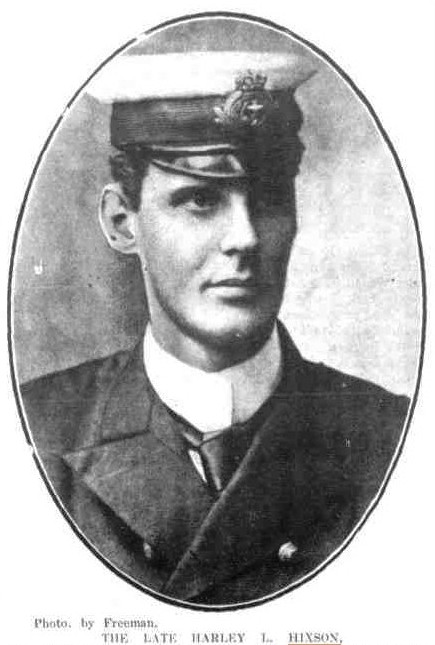 MR. HARLEY L. HIXSON, the youngest son of Captain Francis Hixson, died at Moss Vale on Friday night, 13th inst. Mr. Hixson was a member of the Sydney Stock Exchange, and until recently an alderman of Moss Vale. For many years he was an officer in the Naval Brigade, in which body he took a keen interest. His death is much regretted at Moss Vale, where he had resided for some years, as he was a great favourite, and always took an active interest, so far as his health allowed, in all local matters. The remains were interred in the Bong Bong Cemetery, the Rev. Joseph Best, rector of Moss Vale, officiating. A large number of representative men attended as a mark of respect, and by special request the deceased's favourite hymn, 'Lead, Kindly Light,' was sung during the service. The chief mourners were Messrs. F. W. and H. O. N. Hixson, Messrs. G. E. and J. O. Fairfax. Amongst others present were Mr. G. F. Osborne, Dr. Throsby, Dr. F. C. Stevenson, Mr. O. Z. Throsby, Mr. Chris. Bennett, Mr. E. E. Row, Colonel Taunton, Colonel G. R. Campbell, Mr. H. W. Fairfax, Mr. Gavin George, Mr. T. A. F. M'Carthy, Mr. F. J. Lytton- Hitchins. Many beautiful wreaths were sent, including one from his Excellency the Governor and Miss Rawson. A MISCELLANY. (1908, November 25). The Sydney Mail and New South Wales Advertiser (NSW : 1871 - 1912), p. 1384. Retrieved from http://nla.gov.au/nla.news-article163229579
MR. HARLEY L. HIXSON, the youngest son of Captain Francis Hixson, died at Moss Vale on Friday night, 13th inst. Mr. Hixson was a member of the Sydney Stock Exchange, and until recently an alderman of Moss Vale. For many years he was an officer in the Naval Brigade, in which body he took a keen interest. His death is much regretted at Moss Vale, where he had resided for some years, as he was a great favourite, and always took an active interest, so far as his health allowed, in all local matters. The remains were interred in the Bong Bong Cemetery, the Rev. Joseph Best, rector of Moss Vale, officiating. A large number of representative men attended as a mark of respect, and by special request the deceased's favourite hymn, 'Lead, Kindly Light,' was sung during the service. The chief mourners were Messrs. F. W. and H. O. N. Hixson, Messrs. G. E. and J. O. Fairfax. Amongst others present were Mr. G. F. Osborne, Dr. Throsby, Dr. F. C. Stevenson, Mr. O. Z. Throsby, Mr. Chris. Bennett, Mr. E. E. Row, Colonel Taunton, Colonel G. R. Campbell, Mr. H. W. Fairfax, Mr. Gavin George, Mr. T. A. F. M'Carthy, Mr. F. J. Lytton- Hitchins. Many beautiful wreaths were sent, including one from his Excellency the Governor and Miss Rawson. A MISCELLANY. (1908, November 25). The Sydney Mail and New South Wales Advertiser (NSW : 1871 - 1912), p. 1384. Retrieved from http://nla.gov.au/nla.news-article163229579 DEATH OF MR. H. O. HIXSON.
The death took place yesterday morning, after some months' illness, of Mr. Herbert Onslow Nares Hixson, sub-manager of the Australian Bank of Commerce, Ltd.
The late Mr. Hixson, who was in his 54th year, was the fourth son of the late Captain Francis Hixson (who was president of the Marine Board and Officer Commanding the Naval Forces of New South Wales) and of Mrs. Hixson, of Morven, Double Bay. He was esteemed by all sections of the community in which he spent his life.
Born in Sydney, he was educated at Mr. Southey's school, Oaklands, Mittagong. He entered the service of the bank 39 years ago, and his rare sympathy and discernment, combined with his shrewd tact and judgment, won him the high regard of the entire staff.
In 1880 Mr. Hixson joined the New South Wales Naval Brigade as a cadet, and ultimately secured a commission. He volunteered with others to join a naval detachment for the Soudan, but the offer of the detachment was not accepted by the authorities. He went with the New South Wales naval contingent to China on the occasion of the Boxer rebellion, being the senior lieutenant. He was in charge, at Pekin, of the detachment that guarded the Llama Temple. Upon his return, in 1901, he was promoted to the rank of lieutenant-commander, and served until shortly after the Commonwealth Government assumed responsibility for the whole of the Australian defences, when he was retired a commander in the Royal Australian Naval Reserve.
Mr. Hixson was a quiet unobtrusive man, with few interests of late years outside those of the bank with which he was associated for so long. In his younger days he was an ardent yachtsman, and he was always fond of cricket, rarely missing a match of any importance. He was unmarried.
Two brothers survive him—Mr. F. W. Hixson and Mr. E. M. Hixson—and three sisters—Mrs. G. E Fairfax, Mrs. J. O. Fairfax, and Mrs. McCay, of Calcutta, India.
The funeral will take place this afternoon. The remains are to be interred in St. Thomas' Cemetery, North Sydney.
DEATH OF MR. H. O. HIXSON. (1919, November 24). The Sydney Morning Herald (NSW : 1842 - 1954), p. 6. Retrieved fromhttp://nla.gov.au/nla.news-article15865519
LATE MR. H. O. N. HIXSON.
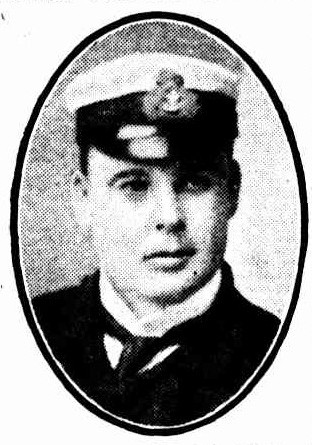 The large and representative gathering at the funeral, at St. Thomas's Cemetery, North Sydney, yesterday, of the late Mr. H. O. N.Hixson, sub-manager of the Australian Bank of Commerce, Ltd., was a tribute to the high esteem in which the deceased gentleman was held in banking and other circles and among old naval comrades.
The large and representative gathering at the funeral, at St. Thomas's Cemetery, North Sydney, yesterday, of the late Mr. H. O. N.Hixson, sub-manager of the Australian Bank of Commerce, Ltd., was a tribute to the high esteem in which the deceased gentleman was held in banking and other circles and among old naval comrades.
Members of the New South Wales naval contingent to China, in which the late Mr. Hixson took part, carried the coffin to the graveside. Members of the contingent were also present in large numbers at the graveside, along with representatives of the Royal Australian Naval Reserve, the Naval Brigade, and the Old Comrades' Association. The Rev. S. G. Fielding, a comrade of the deceased in his capacity as naval chaplain, officiated at the graveside.
The chief mourners at the graveside were:—Mr. F. W. Hixson (brother), and Mr. G. E. Fairfax and Mr. J. O. Fairfax (brothers-in-law). Among those representing the Australian Bank of Commerce at the funeral were Mr. Shannon (general manager), Mr. E. P.Carr (manager), Mr. W. G. Hull (chief inspector for N.S.W.), Mr. G. W. Ord (northern inspector), Mr. T. M. O'Neill (manager, Manly),Mr. A. J. Dawson (manager, Summer Hill), Mr. T. P. C. Burstall (manager, Parramatta), Mr. H. S. Blake (manager, Haymarket), and other officers of the bank, including Messrs. M. A. Roberts, H. de B. Anderson, G, H. Westcott, and J. S. Carroll.
There were also at the graveside Mr. J. S. Marks (chairman of the Public Service Board),Mr. A. H. Uther (War Chest), Colonel A. Spain, Major Airey, Captain S. G. Green, Commander S. W. Spain, Commander Lambton, Commander Banks, Commander Williams, Lieut. B. N. Black, Messrs. L. J. Beaton, L. A.M. Stephen, and G. Belisario, Mr. H. H. Massie(general manager of the Commercial Banking Company of Sydney), and Messrs. H. L. Love-grove and M. S. Grant (also representing the bank), Mr. J. Cole Edwards ("The Review"), Mr. D. A. Madden (Messrs. Madden and Hixson), Archdeacon D'Arcy Irvine, Mr. A. G. Mil-son, Mr. A. Turner (Messrs. Turner and Henderson), Mr. K. Row (Messrs. Edwd. Row and Co.), Mr. J. T. Puckeridge (Navigation Department), and Messrs. F. W. Cape, J. Bateman, A. E. Gray, F. T. Trouton, P. O. Whitley, W. H. Hayley, L. Myles, A. G. Friend, V. W. Williams, C. M. Barker, E. J. Tipper, J. Watt Carson, G. V. F. Mann, E. G. Bennett, L. Colwell, F. J. Thomas, R. W. Robberds, J. L. Saddington, J. Blacker, W. B. Walford, E. Madgwick, J. Allen, and others. LATE MR. H. O. N. HIXSON. (1919, November 25). The Sydney Morning Herald (NSW : 1842 - 1954), p. 7. Retrieved from http://nla.gov.au/nla.news-article15878873

Advertising (1900, July 31). The Sydney Morning Herald (NSW : 1842 - 1954), p. 10. Retrieved from http://nla.gov.au/nla.news-article28246668
Commander Hixson Dies
Commander F. W. Hixson, O.B.E., died late on Monday night after a short illness. He was 89. He was a director of the Permanent Trustee Company, the United Insurance Company, the Illawarra and South Coast Steam Navigation Company Ltd., and the Newcastle Wallsend Coal Company.
He was a son of the late Captain Francis Hixson, R.N., who was stationed in Sydney in the fifties and afterwards took charge of the Sydney shore establishment of the Navy. Commander Hixson became a commander in the Naval Brigade, which was a volunteer naval reserve raised and commanded by his father.
He always took a keen-interest in naval affairs. He was honorary secretary of the Navy League, chairman of the Royal Shipwreck Relief and Humane Society, chairman of the council of the Sydney Sailors' Home for many years, and a member of the Board of Royal Naval House, being largely - instrumental in the success of this body. He was also keenly interested in sailing and school rowing, and was a member of the Council of the Sydney Church of England Grammar School.
In 1920 he was made a member of the Order of the British Empire in recognition of his work for the Australian Comforts Fund. Commander Hixson was a brother of Lady Fairfax and the late Mrs. Geoffrey Fairfax. He is survived by his son, Mr. F. D. Hixson.
After a service in the chapel of Sydney Church of England Grammar School, North Sydney, conducted by the school chaplain, the Rev. Nigel Backhouse, to-day, at 11 a.m., the funeral will leave for Northern Suburbs Crematorium. Commander Hixson Dies. (1951, September 19). The Sydney Morning Herald (NSW : 1842 - 1954), p. 4. Retrieved from http://nla.gov.au/nla.news-article18231359
Tribute To Late Comdr. Hixson
The funeral service for the late Commander F. W. Hixson in the chapel of the Sydney Church of England Grammar School, North Sydney, yesterday, was attended by about 100 friends and representatives of organisations with which Commander Hixson had been associated.
A choir of boys from the school led the singing, and the service was conducted by the school chaplain, the Rev. Nigel Backhouse.
Commander Hixson, who had been a member of the school council, died on Monday night. Among the mourners were Mr. and Mrs. F. D. Hixson(son and daughter-in-law) and Lady Fairfax (sister).
The headmaster of the school, Mr. L. C. Robson, in his address referred particularly to Commander Hixson's work for the school and for Royal Naval House.
"He belonged to a generation in which the standards of industry, devotion, and integrity were very high, and he was a fine representative of that generation," said Mr. Robson. "Is there anything better that can be said of a man than that he was a loyal friend, devoted to well-doing ,and in himself, sincere and good?"
The service was followed by cremation at the Northern Suburbs Crematorium. Tribute To Late Comdr. Hixson. (1951, September 20). The Sydney Morning Herald (NSW : 1842 - 1954), p. 4. Retrieved from http://nla.gov.au/nla.news-article18231585
IN the Will and Codicil of FRANCIS WILLIAM HIXSON late of Elizabeth Bay Sydney In the State of New South Wales Company Director deceased. Application will be made alter 14 days from the publication hereof Hint Probate of the last Will and Testament dated the 20th January 1949 and Codicil thereto dated the 4th October 1950 of the above named deceased may be granted to the Permanent Trustee Company of New South Wales Limited and Francis D’Arcy Hixson the Executors named in the said Will and Codicil and all notices may be served at the undermentioned address. All creditors in the Estate of the deceased are hereby required to send in particulars of their claims to the undersigned ES DUNHILL St BARKER Proctors for the Executors 97 Pitt Street Sydney. Advertising. (1951, September 29). The Sydney Morning Herald (NSW : 1842 - 1954), p. 20. Retrieved from http://nla.gov.au/nla.news-article18233129
ART SALE.
On account of various collectors, Mr. W. A. Little will sell, at his rooms, facing; the Australia Hotel, tomorrow, at 11 a.m, paintings by famous artists', china, bronzes, and silver, also antique furniture, and letters written by George III, which passed from the late Lord Sydney to Mrs. Harley Hixson. AN ART SALE. (1921, September 5). The Sydney Morning Herald (NSW : 1842 - 1954), p. 4. Retrieved from http://nla.gov.au/nla.news-article15961464
Extras (a few of many) and Research articles:
Previously:
Barrenjoey Lighthouse - The Construction - History
Broken Bay Customs Station At Barrenjoey - History
George Mulhall - First Lightkeeper at Barrenjoey and First Rowing Champion of Australia - History
Governor Phillip's Barrenjoey Cairn - History
First Naval Exercises by New South Wales Colonial Ships –The Wolverene at Broken Bay - History
From Colonial Navy Brigades in Second Hand Ships to Where the Australian Navy was Born – The Practical Verses of William Rooke Cresswell’s Charter - History
On February 15 in 1876 the current state flag for NSW was adopted when it was proclaimed in the NSW Government Gazette. The new badge was designed by Colonial Architect James Barnet and Captain Francis Hixson, a retired Royal Navy officer and is described as on a silver background, a red cross bearing a golden lion in the centre and eight pointed golden star on each arm.
First job – surveying – making accurate nautical charts:
IN the Leglslative Assembly yesterday, the SPEAKER reported to the Board that he had received the Insolvency Law Amendment Bill from the Council with an amendment. ".....: SYDNEY, SATURDAY, NOV. 30, 1861.
Considering how much the interests of British commerce and the prosperity of all the Australian colonies are dependent on the completeness and accuracy of the knowledge at command for nautical purposes; concerning the coast of Australia and Tasmania, It is remarkable that we should all have to look to the explorations and surveys of tho great circum-navigator COOK in 1774, and of Captain FLTNDERS In 1709 and 1803,, as, the only; sure guides for the navigation of these coasts. Yet snob is tho foot. With the exception of a running survey. made by Captain STORES, in the Acheron, in 1851 of the coast from Cape Howe, at the Southern extremity of this colony, to Sugar Loaf Point, a little to the north of Port Stephen, and more exact explorations of Jervis Bay, Bateman Bay, Botany Bay, and Port Jackson-nothing has been done since Flinders time towards the completion of a full and exact survey of these COASTS. The work, so 'well begun by COOK, and worthily followed out by FLINDERS, after remaining long in abeyance, is now to be again entered upon. An understanding having been come to between the Imperial Government and the several colonies of Australia and Tasmania on the subject, the Lords Commissioners of the Admiralty have appointed Captain SIDNEY-an officer who has carried out surveys with credit to himself and satisfaction to the Government in the West Indies, in the Mediterranean, among the Azores, on the coast of Ireland, in the river Plata, and among the Channel Islands-to take charge of the coast survey of New South Wales.
As the credit of the Admiralty is involved in the thorough and skilful accomplishment of this very important work, there can be no doubt that Captain SIDNEY and the officers to be associated with him in the undertaking,--Mr. J. W. SMITH, Master, R.N., and Mr. FRANCIS HIXSON, Master, R.N.,-both of whom have been many years on this coast in H.M.S. Herald, and by their local knowledge will be able, to render effective aid to Captain SIDNEY in the prosecution of his labours,-will be amply provided with all the means which the latest improvements have furnished to nautical survey; and we may expect such an application of science and experience, to this survey as has not yet been devoted to a similar purpose on the coasts of Australia.
The additional security to life and property attainable by a complete and accurate coast survey must render the project highly satisfactory to the colonists and to all who are interested in the shipping *.bat visits Australia. In view of the advantages to be derived from the engagement in such a work of true ability and experience at the command of the Admiralty, the expense which will be incurred by the colony, limited to £2500 a year, is trifling; and as an equal amount to that paid by the colony is to be defrayed by the Admiralty, in consideration of the extent to which the interests of the mother-country are involved in the undertaking, our share of the burden will surely be cheerfully borne. '
Even the survey of Fort Jackson, in which Captain DENHAM was occupied, in H.M.S. Herald, in 1857-and which constituted the whole of the exact exploration effected by that officer on the coast of New South Wales-is not regarded by the Admiralty as complete inasmuch as it extends only to Cockatoo Island. The inlets above that spot, and the river up to Parramatta, will be fully examined. The navigation of the several rivers along our coast will also form subjects of examination ; and the opinions of so experienced a nautical surveyor as Captain SIDNEY on questions which have long been debated among our coasting navigators, and the settlers, whose prosperity depends on the right solution of those problems, cannot fail to be of great advantage.The practicability of securing vessels entering Newcastle from the Charybdis of Port Hunter;the Oyster Bank ; the right use and true destiny of Port Stephen ; the evasion of the embarrassing bar at the mouth of the Manning, by opening a communication from Crowdy Bay to one of the northern and branches of that river; the manner in which the singular' facilities presented by the rocks at the mouth of the Clarence may best be employed for rendering that entrance commodious and safe; the possibility of making the serpentine channel through the extensive shallows at the mouth of the Richmond available for shipping; these and many similar inquiries will doubtless be brought under the consideration of the distinguished officers engaged in the survey. And the confidence inspired by the possession of an accurate and complete survey will give a stimulus to our coasting traffic, the efforts of which will be felt by every part of the colony.
As Captain SIDNEY will, of course, consult the Surveyor-General, and other colonial officers acquainted with the requirements of the territory, he will be likely to bestow his earliest attention on questions of present interest to the business of the colony. The port of Newcastle and.the River Hunter, from the rapidly increasing amount of traffic upon them, will demand attention. As the survey of Captain STOKES terminated at Sugar Loaf Point, the line of coast from that point to the northern extremity of this colony, Point Danger, will be considered deserving of early investigation.
The general interests of science, as well as the special advantages of the colony, will be promoted by the undertaking. Among other scientific questions awaiting solution is the alleged rising of the land about Port Jackson.Related as this fact, if it be a fact, is to the ascertained sinking of the coast and encroachment of the sea in parts of England and Europe, the rising of the land in other parts, and the theory of a slow but perpetual oscillation of earth and sea; the investigation by the most approved scientific means of this question, cannot fail to be regarded by the scientific world with deep interest. "
Seeing how much benefit may be expected to arise from the prosecution of the intended survey, the colony will confidently expect that the officers of the Government, whose departments touch on that work, wilt cordially, and promptly render all the assistance in their power to Captain SIDNEY. Mutual aid may be rendered by those who have charge of the land and sea surveys respectively.
- It is impossible to consider this subject without being reminded of the advantages of that union between the mother-country and the colony, which has sometimes been viewed with impatience by a few individuals, but which is now so thoroughly freed from all conditions degrading or embarrassing to the colony, that it is almost unanimously regarded as an honour and a privilege. In the appointment of some of her ablest officers to the work of surveying the coasts of Australia, and undertaking half the expense of tho work, Britain furnishes these colonies with a most, graceful, and welcome memento of the relation in which they stand to the parent State; a State which, having fostered them In their in fancy, continues, as sound policy dictates, the occasional bestowal of generous benefits, without any attempt to reimpose a galling yoke, or to exact any other expression of, gratitude than a willingness to continue In the ‘enjoyment of mutual advantages. ' The Empire. (1861, November 30). Empire (Sydney, NSW : 1850 - 1875), p. 4. Retrieved from http://nla.gov.au/nla.news-article60483300
SAILORS' HOME PICNIC.
It will be recollected that in the middle of the year 1859 practical steps were taken for the establishment of a Sailors' Home in this port, and a public appeal for funds was responded to by a large number of subscribers. The object was to protect the interests of the seamen who upon coming ashore with hard earned -wages, were frequently victimised by unconscionable crimps, and taken to comfortless boarding houses and often iniquitously eased of the result of years of toil. The success which had attended similar institutions in the mother country and in America was also an incentive to the formation of a Sailors' Home in Sydney. The funds having reached £1300, the Government, on application, granted the piece of land on the western side of the Sydney Cove, near the site of the old Water Police Station. Preferring the immediate construction of a suitable building rather than the expenditure of a large amount in providing, temporary quarters, increased exertion was made, and in May, 1861, the foundation stone of the first wing was laid by Lady Young. Of those who were active and zealous in this good work might be mentioned the late much respected Captain North (then Water Police magistrate), Captain Pike, and Mr. R. Towns, among others whose aid, though valuable, was less prominent. The Home was opened on the 1st February, 1865, and up to the 5th March, 1866, the number of seamen admitted was 1145, and during that time the sum of money passed through the deposit books amounted to £3251 9s. 2d. On the latter date there was £196 in hand.
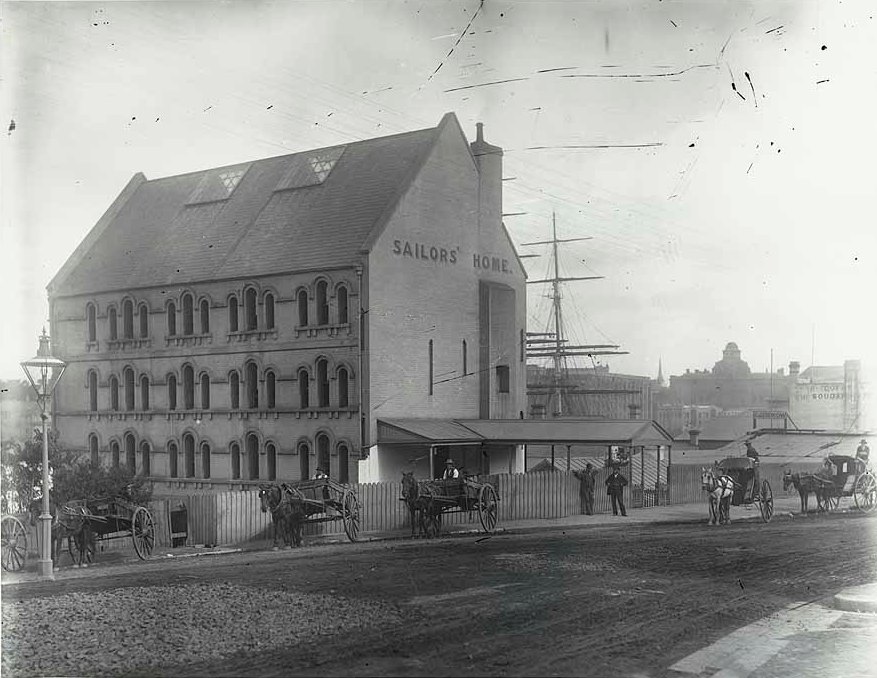
The Sailors Home, 124 George Street, The Rocks (NSW) circa 1880 - Courtesy State Records of NSW, Image No.: 4481_a026_000054.
The presence of so distinguished a sailor as His Royal Highness the Captain of the Galatea awakened an idea that the time was opportune for a fresh effort towards completing the Home. The movement quickly assumed a business-like shape - an influential committee was organised, and a picnic was decided upon as the most suitable mode of raising further funds in aid of the institution. To this of course it was expected his Royal Highness Prince Alfred would give his patronage and countenance. The honour was readily conceded, and this event was looked for-ward to RS one of the chief festivities in connexion with his Royal Highness's sojourn in the colony.
The locality fixed upon for the fete was the picturesque spot known as Clontarf, on the north shore of Middle Harbour ¡ o spot on this occasion to be rendered ever memorable by a deed of blood that will convulse popular feeling throughout the colony.
Ample accommodation for conveying visitors to and from the ground was provided, five large steamers, being engaged to run from the Circular Quay at regular intervals during the forenoon, and return in the evening.
About 11 a.m. the R. S. Y. Squadron rendezvoused in Double Bay, and soon after stood out under the command of Commodore Dangar, whose fine yacht, the Mistral, led the fleet, followed by the Xarifa, Vivid, and eleven others, under fore and aft canvas. When off Bradley’s they eased off, run up the harbour, and rounded H.M.S. Challenger, saluting Commodore Lambert's pennant as they passed. They then hauled on a wind and worked down the harbour for Clontarf, where their arrival was watched with great interest. The squadron was the largest ever seen in this harbour, and their appearance, when anchored off the spit dressed with flags, was extremely pretty. The yachts of the Prince Alfred Club, ten in number, made the trip to Middle Harbour separately, took their positions abreast of the senior club, and dressed with bunting in a similar style.
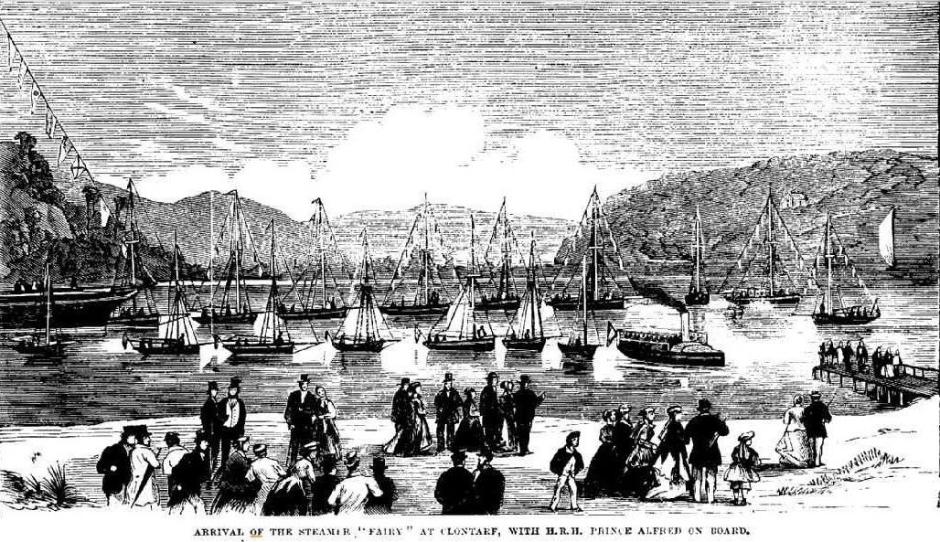
ARRIVAL OF THE STEAMER "FAIRY" AT CLONTARF, WITH H.R.H. PRINCE ALFRED ON BOARD. THE RECENT ATTEMPT ON THE LIFE OF His Royal Highness THE DUKE OF EDINBURGH. (1868, April 20). Illustrated Sydney News (NSW : 1853 - 1872), p. 1 Supplement: SUPPLEMENT TO THE ILLUSTRATED SYDNEY NEWS. Retrieved from http://nla.gov.au/nla.news-article63513927
Seen from the shore the effect was striking, the twenty-four yachts, decorated with flags of every hue, and numerous other sailing boats anchored about the bight, with the steamers City of Newcastle and Morpeth moored at the end of each line, produced as pretty a sight as has ever been witnessed in the harbour of Port Jackson. On the ground a large marquee, neatly fitted up, was added to the permanent buildings on the ground as a luncheon saloon. A handsome tent, with suitable appointments, was pitched on the side of the dell opposite the beach, for the convenience of his Royal Highness and suite. From as early an hour as 10 o'clock, when the first steamer departed, it was very evident that the visitors would be very numerous, and when the last boat landed its passengers there were between two and three thousand persons present.
His Royal Highness left the Galatea shortly after 10'clock in the steam yacht Fairy, and as she passed, about two o'clock, between the steamers and yachts which had been drawn up in two lines near the Clontarf jetty, they saluted by dipping their flags. He was received by a number of gentlemen, members of the -Committee, and escorted to the marquee, where luncheon had been provided. With his Royal Highness were his Excellency the Right Hon. the Earl of Belmore, and her Ladyship the Countess of Belmore, Viscount Newry, the Hon. Elliott Yorke, Miss Gladstone, Captain Beresford, Mr. Toulmin, and Lieutenant Haig.- Places at a central table were reserved for them, and here they were joined by among others Commodore Lambert and Mrs. Lambert, his Honor Sir Alfred Stephen and Mrs. Stephen, Mr. Charles Cowper, Captain Lyons, Mons. Sentis (French Consul), and the Hon. John Hay. Sir William Manning was in the chair, on his right his Royal Highness, and on his left his Excellency the Governor.
After luncheon, Sir WILLIAM MANNING rising, said, it was intended on this occasion to have only a few words and only one toast. He was permitted to propose the health of her Majesty, "He could not propose that toast without some brief remark He desired his hearers to show in the way they received it that they were as loyal subjects of her Majesty as any in Great Britain and Ireland, and he hoped this would be shown by acclamation. He thought he might assure his Royal Highness that the loyalty of the people of this colony was as true and genuine as " that of any subjects in her Majesty's dominions ; in fact, that they gloried in being reigned over by such a Queen, under whose auspicious rule they enjoyed all the liberty they could desire. He proposed and begged they would drink to the health of her Majesty the Queen, with hearty enthusiasm.
The toast was received with three lusty cheers.
If any reference, in detail, were made to the state of things at the luncheon, it would be only to point out the results of an utter want of judgment and organised action on the part of the committee.
At twenty minutes past 3 o'clock, and immediately after the toast to her Majesty, the company rose, and his Royal Highness and suite proceeded to the tent set apart for their private use. The sad event that transpired afterwards is described in another notice. SAILORS' HOME PICNIC. (1868, March 13). The Sydney Morning Herald (NSW : 1842 - 1954), p. 4. Retrieved from http://nla.gov.au/nla.news-article13154856
Some Shipwrecks
Right place at the right time
TOTAL WRECK OF THE BARQUE NAUTILUS.-On Thursday evening last, at a few minutes before eight o'clock, the barque Nautilus, Captain Do Latidles, ran aground with all sail on her on to the ledge of rocks immediately under Nobby's. The pilot department and the public first became aware of the fact by the burning of a blue-light by the lighthouse-keeper (Mr. Hannell), who subsequently fired off a rocket which'attracted more general attention perhaps than the burning of the blue-light. At the time the blue-light was observed to be burning the Naval Brigade, of which force the pilots are members, was being drilled by Captain Hixson, from Sydney, in the Barrack square. When the well-known distress signal was first noticed it was exactly eight o'clock, and the Naval Brigade men had just been dismissed by Captain Hixson. The alarm was at once given, and off the whole force started in the direction of the pilot-boats.Within some five or six minutes of the light being seen in the Barrack-square, Pilots Taylor, Lott, and Collins, together with the assistant pilots, were down at the new boat harbour, and got the boats launched, and the first boat, commanded by Mr. J. Taylor(coxswain of the lifeboat),had actually passed from under the bridges at the end of the wharf, and was scudding along before a stiff breeze, with all sail set, in the direction of the lifeboat »boil. A very short interval elapsed from the time the boat left the, wharf till the was at the lifeboat shod, a fact which is placed beyond doubt or conjecture by the time having been noticed by a watch. From the time when the men left the barrack-square until the lifeboat was manned and afloat and had fairly started for the wreck was exactly thirteen minutes, a space so brief that unless we had observed the time, the fact would have appeared too startling almost to be believed. For the benefit of readers at a distance, we ought to mention that in this thirteen minutes the lifeboat crew had to run fully a third of a mile on land, launch the pilot-boat, row down to the lifeboat shod, a distance of above one-eighth of a mile, draw the whaleboat on to the beach, man the lifeboat and launch her, including the putting on of cork jackets, &c.-the whole of which was accomplished in the marvellously short space of thirteen, or at the outside, fourteen minutes. On arriving at the scene of the wreck, Captain Taylor found that owing to the shallowness of the water, he could not approach nearer than about twenty feet of the stranded vessel,which was found to be lying high up on the rocks, showing clearly enough the force with which she must have gone aground. Directly the boat had been made fast to the barque she was allowed to drift in as near as possible to the Nautilus, and a second line was passed from the vessel to the life-boat by means of which connexion four out of eight men were taken into the life-boat. The remaining four men preferred to imperil their lives to save a few clothes, and, at a very great risk, came ashore through the breakers in the ship's boat. As soon as Mr. Taylor found the crow were all off the vessel, he at once left the Nautilus, and brought the four men who had the good sense to take the lifeboat, in to the wharf,where they were landed. The ship's boat, with the captain in it, landed on the the stony beach, between the lifeboat shed and Nobby's, and on being hauled up the pqoj was found to be nearly full of water. The men had fled the boat with their personal effects, which, having
been removed to one of the pilot boats, were conveyed to the wharf along with the owners. At the time the wreck occurred it was blowing very stiff from the southeast and it. is extremely fortunate that,under all the circumstances, no lives wore lost. The news of the wreck spread very quickly, and half an hour after the vessel struck near a hundred people had congregated on Nobby's while a much larger number had assembled at the end of the wharf and on the western end of the breakwater. Among the spectators on Nobby's were Captain Hixson and Captain Allan. Besides the lifeboat, one of the whaleboats, under the command of Captain Lott, went outside the harbour, and lay-to in attendance on the lifeboat, in case of any accident. Great praise is due to the pilots and the men under them for the very prompt manner in which they got out the boats, and proceeded to the assistance of the crew on board the stranded barque. The vessel refusing to answer her helm is slid to be the cause of the accident. The wreck was sold for £99. The Nautilus was insured in the Pacific Office for £1,500. She was a fine handy barque of about 170 tons register.-Newcastle Chronicle. SHIPPING INTELLIGENCE. (1867, January 9). The Mercury(Hobart, Tas. : 1860 - 1954), p. 2. Retrieved from http://nla.gov.au/nla.news-article8843668
How Collaroy was named - and also the place his great grandson Tim Hixson lived at, played around and swam as a champion swimmer for Collaroy SLSC: this vessel was stranded for a while and brought the curious out to what later became 'Collaroy' for picnics to have a look!
Stranding of the Collaroy.
The Newcastle Steamship Company's paddle steamer Collaroy did not arrive in Sydney from Newcastle as usual on Thursday morning, and the delay was accounted for by the dense fog which overhung the coast line in the vicinity of this port. Later on, however, a telegram from Manly announced that the vessel had run on shore while enveloped in the fog, but there was every hope of her launching on at high water. The Collaroy left Newcastle at the usual time on Wednesday night, and ran on shore on a beach close to Long Reef about 4.15 a.m. on the following morning. Fortunately the sea was comparatively smooth.Attempts to get the vessel off failed, and she remained firmly fast, with her broadside to the beach. The landing of the passengers, 40 in number, was successfully accomplished, and on the news reachingManly several coaches were sent down by the road to bringthem overland. Captain Hixson, president of the Marine Board, on being informed of the accident, at once telegraphed to South Head for the pilot steamer Captain Cook to proceed to the Collaroy's assistance, and that vessel steamed through the Heads at 20 minutes past 10 o'clock.The owners of the Collaroy acted promptly, in order if possible to save the vessel, and two powerful tugs and a diver were sent to the scene of the accident. Mr. Hunter, the N. S. N. Co.'s superintendent engineer, accompanied by Captain Anderson, of the Kembla, left Sydney for Long Reef via Manly, and remained by the Collaroy till dark last night. The company's superintendent-engineer (Mr.Hunter), accompanied bv Captain Anderson, of the Kembla(belonging to the same company), arrived at the Collaroy,overland by way of Manly, at a quarter past 4 o'clock, and pronounced an opinion that as the ship had made a bed for herself she could not be got off without some additional anchors and chains.The Prince Alfred, Newcastle tug, arrived at 5.30 p.m., and hove-to just outside the breakers. The wind had been blowing fresh from N.E., and just after the arrival of the above vessel it chopped into south, blowing strong, and causing a heavier break on the beach. Captain Thompson and a crew succeeded in launching the lifeboat from the beach and attempted to communicate with the tug ; when on the outer edge of the breakers a sea struck her, and she half filled with water, and fell off in the trough of the sea. The next roller sent her flying in towards the beach full of water, proving that communication by boat was out of the question.Since the first inauguration of steam communication between Sydney and the Hunter River the steamships employed on the line have had a most fortunate career.There is only one instance of a total loss on the coast, viz., the City of Newcastle (s.), which went on shore set night time when making the passage hence here.
The Collaroy, which now promises to be a total loss, is the second serious casualty on this line. She has had a career of some 25 years, unbroken by accident of any kind, and from her earliest days down to the present she has been regarded as a trustworthy sea-going craft, and did much for the profits and good name which the Australian Steam Navigation Company gained. Some two years ago she was purchased by the Newcastle Steam Navigation Company, and since that period has been steadily employed in the Newcastle trade, performing her trips with singular regularity at the rate of five per week. Some four months since she underwent extensive repairs; all her plates were bounded, and any that were thought to be defective were removed. She was fitted with a new superheater, new sponsons, paddle-boxes, funnel, and donkey-engine. The vessel is only partly covered by insurance, and should she break up it will be a serious loss to the company. The scene of the accident is about 6 miles north of Manly,and by a journey of some 45 minutes by coach from that place the Collaroy can be reached. She lies, with her head pointing south-south-east, on the southern end of a Iong beach that forms the segment of a circle, and stretches northward from Long Reef. Had the vessel hit the coast 100 yards further south she would have very quickly broken up. The place where she is onshore is the most sheltered in the locality. As the tide rose the sea beat her further on the beach, just where the low- lying road to Pittwater takes a sweep near the sea ; and had the Collaroy been able to get a trifle more than her length inshore she would have been athwart the Queen's highway. The vessel's position is tolerably well sheltered, as the extreme point of the reef bears about S.E. by E. from where she lies. Should the wind set in heavily from south-east, or indeed if a very heavy sea should break on the coast, the Collaroy will very soon go to pieces. The vessel bumped slightly throughout the day, but nothing to cause any fear of her breaking up ; when the southerly came on in the evening the surf broke more heavily, and as the tide began to make the vessel became more restless, and during the night would, no doubt, be driven higher up on the beach.At the time we are writing the wind is strong from south,and so long as it continues no attempt to float the vessel can prove successful. Last night Captain Thompson had a line run out from the Collaroy's stern to the shore, to serve the twofold purpose of keeping the vessel steady, and to enable the crew to abandon her, if necessary, during the night. The Collaroy had on board 14 saloon and 10 steerage passengers. The cargo comprised 7 bales wool, 170 bags potatoes, 200 hides, 40 casks tallow, 40 pigs, 30 sheep, and sundries. The live stock was landed on Thursday afternoon,and driven into a paddock close by the wreck.Captain Thompson has been for some years in the company's employ. He first joined the Kembla (s.) as second mate, and by dint of perseverance and hard work rose to the position of captain, and bears the name of a steady and reliable man.
THE CAPTAIN'S STATMENT.
In the course of an interview with Captain Thompson, on board the vessel on Thursday afternoon, he stated : The vessel left Newcastle at 11 p.m. on Wednesday night, and in fifteen minutes was clear of Nobby's, the night being beautifully clear and moonlight. The usual course, south by west, having been given to the chief officer, I wont below at half-past 2 o'clock, giving orders to be called when the ship neared Long Reef. The mate called me at five minutes to 4 o'clock, stating that he thought the vessel was off Long Reef, and at the same time reported the weather as thick ;I reached the bridge in a few minutes later, and he pointed out what he took to be Long Reef, on the starboard quarter, the land being barely visible ; I could not determine what it was, but it certainly looked like Long Reef ;the mate and myself were standing on the forepart of the bridge at 4.15 a.m. ; the ship was going at her full speed, about 10 knots, when the breakers suddenly became visible on the lee bow.The engines were stopped, turned full speed astern, and the helm put hard to starboard; the vessel, however, struck easily, the shock not being sufficient to cause any alarm among the passengers. The engines continued astern for nearly half an hour, but the ship remained fast on the sands, and slowly moved further inshore. Finding that she would not come off, the boats, which had been quietly got ready for launching, were lowered ; the lifeboat first,to land the passengers; the ladies and children were put into it, and all landed through the surf, without any accident, as the surf outside the breakers was very slight, and the landing was effected under shelter of the vessel. As the boats were unable to go close in shore, the lady passengers were either carried by the crew the rest of the distance, or waded through the water. In the early part of the morning we tried to get an anchor out in order to prevent the vessel from drifting further upon the beach ; the port anchor having been previously let go with 30 fathoms of chain, but it came home; the attempt to run the anchor out failed, as the life boat in taking it through the surf was stove, and the anchor was lost. When the first boat landed, a messenger left for Sydney, to request assistance, but it was half-past 11 o'clock before the Commodore bore down on us, she having accidentally discovered the vessel's position; I sent the second officer with six men to take the life-boat through the surf, in order to communicate with the Commodore, but after four futile attempts, I took charge of the boat, and succeeded in getting to the Commodore; the boat, however,nearly filled in getting through the surf; a small line was then taken from the Commodore to the Collaroy, and afterwards a new hawser was made fast to the bitts on the quarter. In the meantime the Mystery came up from Sydney, and having made fast to the Commodore, both tugs steamed ahead, and at the third heavy strain the hawser parted. I then wished to again go off in the lifeboat in order to get the hawser on board, but the crew refused to go with me. The Commodore then left the scene, and was soon afterwards followed by the Mystery.The Commodore revisited the locality in the afternoon but nothing could be done as the tide had receded.
.jpg?timestamp=1432986818693)
THE CHIEF OFFICER'S STATEMENT. Mr. Drew, the chief officer, states : The Collaroy left Newcastle on Wednesday night at 11 o'clock for Sydney,in company with the Hunter River Company's steamer Morpeth ; both vessels kept company up to about 4 a.m., when the haze that had prevailed thickened into a dense fog, and the Morpeth was lost to view on the port quarter about half a mile distant ; I relieved the second officer, Mr. Henrick, half way between the two ports, receiving the usual orders and course,south-by-west. by standard ; when half-way across Broken Bay the fog increased in density, and I called the captain,who came on deck immediately'; the loom of the land was then visible to the south of Broken Bay, and suddenly I saw breakers on the starboard bow ; simultaneously the vessel grounded ; Captain Thompson gave the order ' Go full speed astern, and starboard the helm.' The order was promptly executed, but the ship refused to respond to the action of the engines, and gradually worked herself nearer the beach. There being no immediate possibility of the vessel coming off, attention was at once turned to the safety of the passengers. The starboard lifeboat was manned by myself and a crew of four hands ;the ladies, numbering half-a-dozen, and an equal number of children were hastily got into the boat ; after three or four trips all the passengers were safely landed, together with the whole of their luggage. In the meantime the second officer and a portion of the crew succeeded in lowering the dingy from the port side during the running of a heavy surf, which broke up against the ship's side.Immediately after the passengers landed, we got the lifeboat under the starboard bow, and got the starboard anchor and line in the boat to run out seaward, but after several efforts could not succeed, as the surf was very heavy, and we had therefore to cut the anchor away from the stern of the boat.During this time the dingy was pulling ahead of the lifeboat, to be in attendance in case of an accident ; on the return of the dingy before the surf, a heavy sea ran over her; she capsized, and the occupants — two men — had a severe struggle in the surf for some minutes, till picked up by the life-boat ; one man, named Wilson, narrowly escaped drowning, having been seized with cramp. The attempt to get the starboard anchor out having failed, the port one was let go,and 30 fathoms of chain payed out, still the ship dragged shorewards, the anchor not holding. The receding tide gradually left her quiet, the sea beating on the port side, the dry beach being on her starboard side. At 11 a.m. the Commodore (s.), Mystery (e.),and Captain Cook, from Sydney, arrived on the scene ;Captain Thompson and his boat's crew pluckily pulled off through the heavy surf, and conveyed small lines from the Commodore; a 13-inch hawser having been hauled on board and made fast to the bitts, all was ready at 1 p.m.,:and three steamers being fast one to the other they commenced to tow, and after pulling for ten minutes the hawser parted, and the attempt had to he abandoned'.
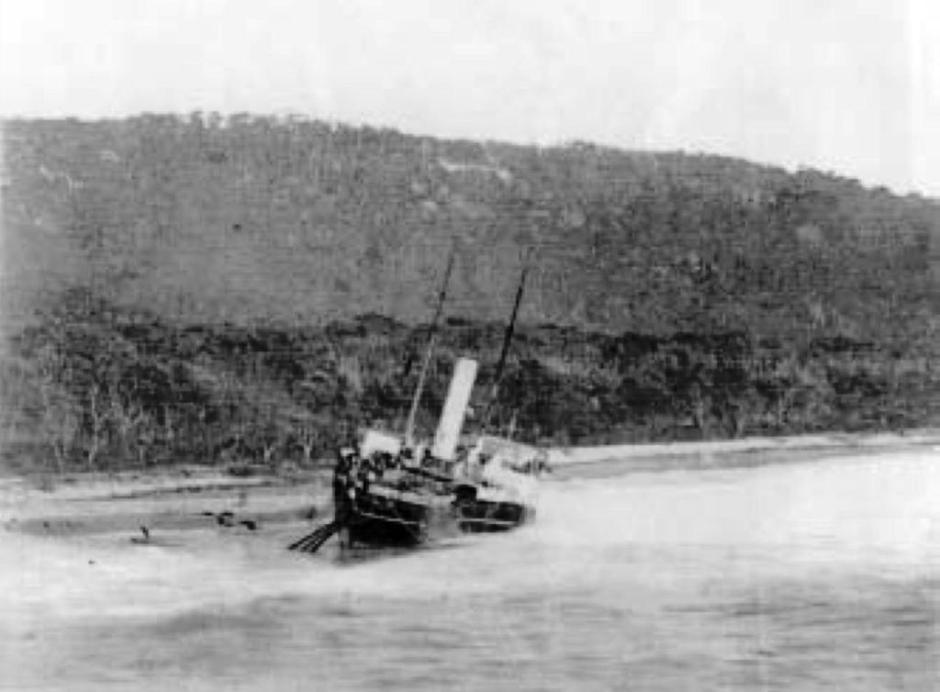
Stranding of the Collaroy. (1881, January 22). The Sydney Mail and New South Wales Advertiser (NSW : 1871 - 1912), p. 152. Retrieved from http://nla.gov.au/nla.news-article161882671
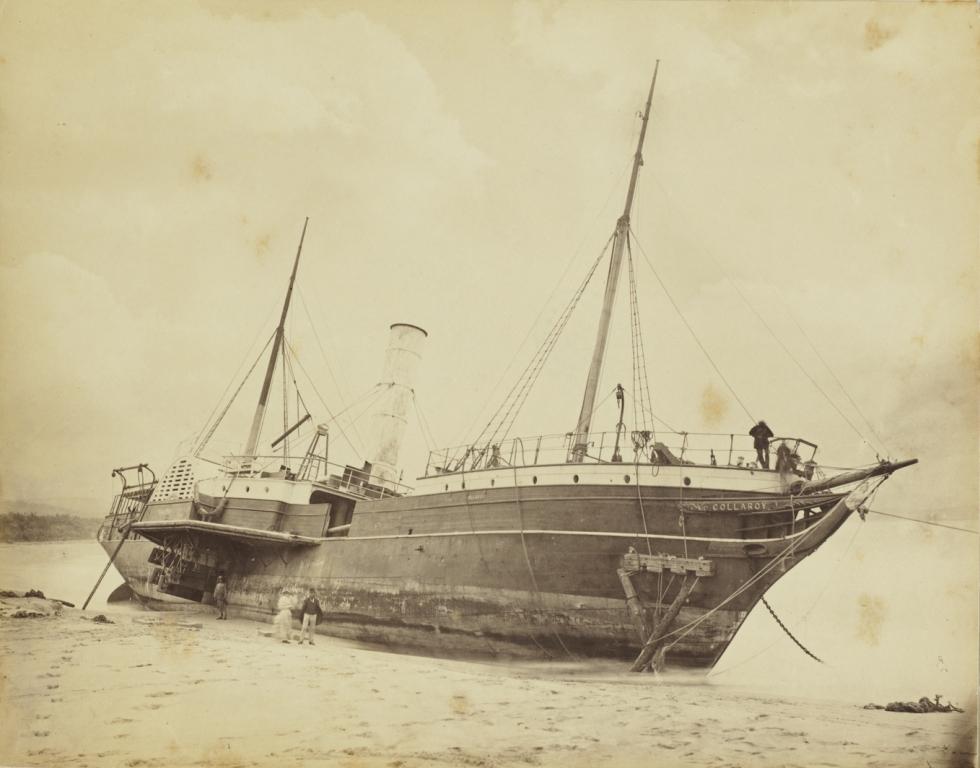
Wreck of the S.S. Collaroy, 1881 / photographer unknown. State Library of NSW Image No: a1528938: A passenger steamer owned by the Australian Steam Navigation Company, built in 1853, went ashore on Collaroy Beach in 1881 and remained there for 2 years, giving her name to the stretch of sand and ocean. When refloated she went back into service plying between Sydney and the Hunter River. She was withdrawn from duty in 1886, converted to a schooner, sailed to San Francisco, where she again ran ashore and broke her back on the Californian Coast in 1889.
MARINE BOARD ENQUIRIES.
The Marine Board sat yesterday afternoon. CaptainHixson presided, and there woro also present,-Captains Broomfield, Jenkins, M'Lean, and Moodie.
Charles Matherson, master of the Rose of Sharon, was summoned to show cause why his certificate should not be suspended. He was represented by Mr. F. P. Wilkinson. The vessel, which was a coasting steamer of 78 tons, owned by W. Hudson, was wrecked off Long Reef on February 28.The President said that the Board wished Captain Matherson to answer two points, that of carelessly navigating the vessel, and that of leaving the deck without any competent person in charge. Mr. Wilkinson said that the vessel was a small coasting steamer;under the 81st section of the Navigation Act it was provided that vessels under 100 tons should carry a master and a second engineer; they were not obliged to carry a mate; it could not be expected that Captain Matherson should stay on deck the whole day and night himself ;he had been on duty from 6 o'clock in the morning until 1 o'clock tho next morning, and was then under the necessity of taking rest ; he left the vessel in charge of a sea-man named Donald M'Gregor; this man had been with him for two years, and had always previously been found to be trustworthy; he knew how to steer, and had the course given to him; had it been followed everything would have been safe; but it was not followed, and M'Gregor was the person who was to blame, and not the captain; had there been a mate on board, and had the accident happened during his watch, the captain would not have been to blame; if the board held that the capatin was wrong, then the Act was wrong, because he had fully carried out the law; he did not see how the board could possibly find him guilty, although they might suggest some alteration in the law if they thought desirable; had Captuin Matherson not given M'Gregor the course he would have been in the wrong, but the fault was, having had the course given to him, the man did not keep it, but allowed the ship to go astray; although the vessel did go on shore no lives were lost; there was some damage done, but not as much as generally occurred on these occasions, and this was probably owing to the great exertions made by the captain afterwards ; the owner was present and was williug to be examined as to Captain Matherson's character. The President remarked that they had seen Captain Matherson's testimonials, and also knew that his character stood high as a seaman.
Mr. Wilkinson said that under these circumstances it would not be necessary to give any further evidence.The President said that the board could not altogether acknowledge the right claimed by counsel in the matter.He wished it to appear that because a captain had not got a certificated man on the ship, that therefore he could leave any person, competent or incompetent, in charge. But that would never do. A captain's responsibility on his ship never lapsed. It would be a pretty state of things if it did.
Taking into consideration Captain Matherson's able testimonials, and recognising that there was no loss of life and very little damage, due to a great extent to his efforts, they would not deal with his certificate, but would severely reprimand him, and caution him to be careful as to his conduct in future.
The Board then held an enquiry into the loss of the schooner Energy, on the Clarence River, on the 29th February. S. R. Savory said that he was master of the Energy before she was wrecked; he held a certificate of service in New Zealand ; she was a three-masted schooner of 185 tons, and of Australian build; he owned a third of the vessel, and C. B. Stone and W. H. Brown were also interested in her; both these gentlemen were insured, but this trip he was not; the vessel had become a total wreck ; he was on voyage from Melbourne to the Clarence ; there were nine seamen, all told, and no passengers : he arrived off the Clarence bar on the evening of the 27th ; bad weather set in, and he had to go to sea; the weather moderated, and he was making his way back to the Clarence; the bearings he took gave him a position of five miles off Evan's Head; there was a four-knot breeze on, with a little swell from the southward; he found they were getting nearer shore than he liked, and tried to turn the ship, but she would not come round, and drifted on to the land ; she missed stays twice ;he had been master of her over four years ; she was properly trimmed and ballasted, and had always turned well before; the Clarence light was in sight all the time; there was a heavy current running, and it was this that drifted the ship on to the shore' F. Hughes said he was mate of the Energy when she was lost; it was his watch below; the captain called him on deck to let go the anchor; he did so in from eight to ten minutes before she struck; she dragged the anchor; everything possible was done to try and save the vessel. R. Smith, who was acting as second mate, attributed the accident to the ship missing stays twice and the wind falling light. James Webb, able seaman, gave corroborative evidence. The board announced that they found that the Energy was lost through of missing stays twice and consequent dragging, but there was no evidence upon which to found a charge of default against the Master. MARINE BOARD ENQUIRIES. (1887, April 6). The Sydney Morning Herald (NSW : 1842 - 1954), p. 11. Retrieved from http://nla.gov.au/nla.news-article13648697
Captain G. S. Lindeman.
Captain George Sidney Lindeman, retired R.N., who has been appointed officer commanding' the New South Wales Naval Forces in succession to Captain Hixson, is well known in business and shipping circles, and is the shipping master of this port. Captain Lindeman has had a lengthy and honourable connection with the Imperial Navy, and latterly with the naval forces of this State. He joined the Royal Navy in 1859, was promoted sub-lieutenant in 1865, three years later he received his second stripe, and in 1872, after13 years' service, retired' as a lieutenant. 'He qualified in gunnery, first-class, on H.M.S. Excellent. He was commanding officer of the Peruvian- barque Iquique, 600 tons, with a prize crew from H.M.S. Leander, on. the South Pacific station in 1864. A year later he was present with the British squadron! at the bombardment of Valparaiso by the Spaniards, and landed with a ship’s company to protect British subjects and assist inthe extinguishing of fires in that city. His first appointment in the colonial forces dates back to1872, when he was made a lieutenant in the New South Wales Artillery, but he resigned his commission in 1875. In 1879 he was appointed a commander in the Naval Brigade. During the year1886 he was acting captain, and during the absence of Captain Hixson with the China Naval Contingent, and subsequently, whilst that officer was on leave, he commanded the Naval Forces. Captain G. S. Lindeman. (1902, June 21). Australian Town and Country Journal (Sydney, NSW : 1870 - 1907), p. 26. Retrieved from http://nla.gov.au/nla.news-article71525286
This item is interesting due to the fact it reflects a bit of a word skirmish going on at the time of what should have been a celebration. Politicians were those casting about silly remarks, after toasts apparently, so too much wine may account for some of it, from those we want to be above such conduct. There is also some interesting remarks made by the gentleman, Sir George Dibbs, who was premier of New South Wales on three occasions, was ignoring an impending deficit referred to in this perice:
From Tim's Profile:
You may be aware that two of his daughters married Fairfax sons. One of the first jobs he did when in charge of Ports was go to the Clarence River to investigate a claim where a chap was suing the government for 10 thousand pounds. He investigated it and got it reduced to one thousand pounds. But the chap who lost the nine thousand pounds then went on to be Premier of NSW and had a set against Captain Hixson but due to two of his daughters marrying Fairfax sons the persecutions this chap then levelled against him never appeared in any papers as these, then, were the history and records for that time. Some say he never received promotion due to this episode or incident. This is why his history isn’t clear cut, although he as clearly a fantastic man.
The other interesting aspect of this little 'launch' is the description of Mort's and the figures for vessels coming to the harbour - and gives some idea of the enormous workload handled by the men who manned the Pilot Vessels:
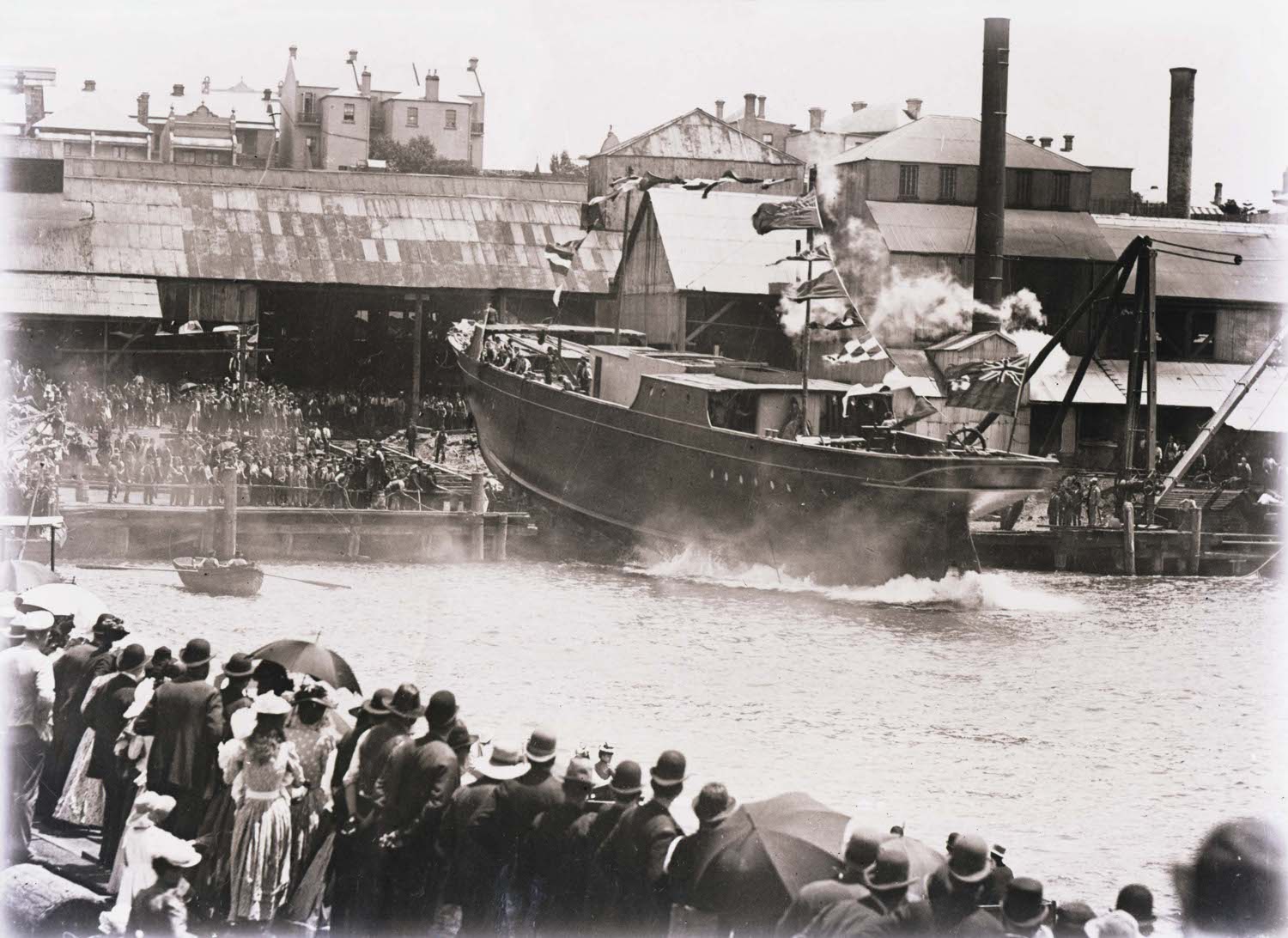
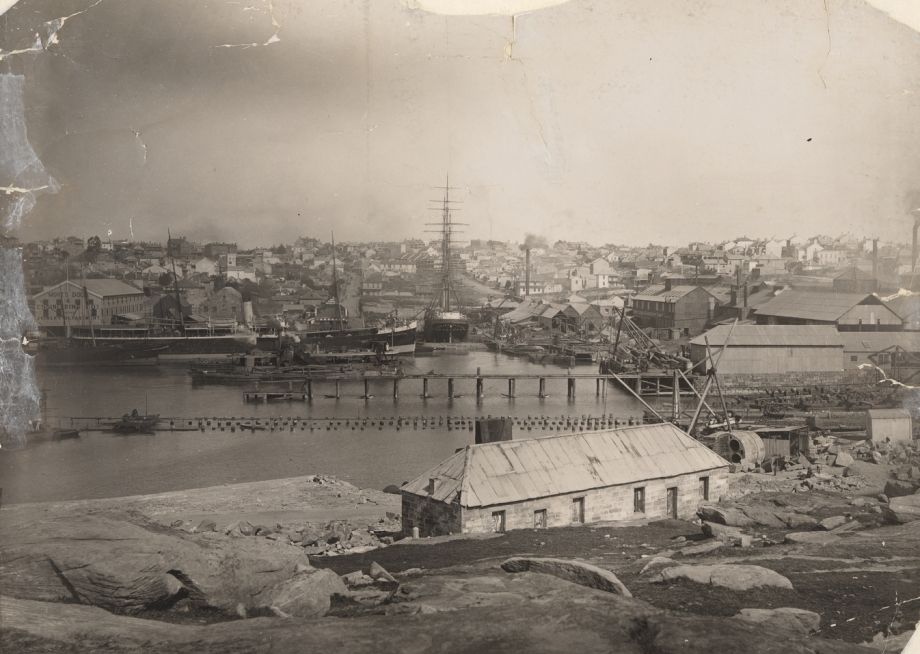
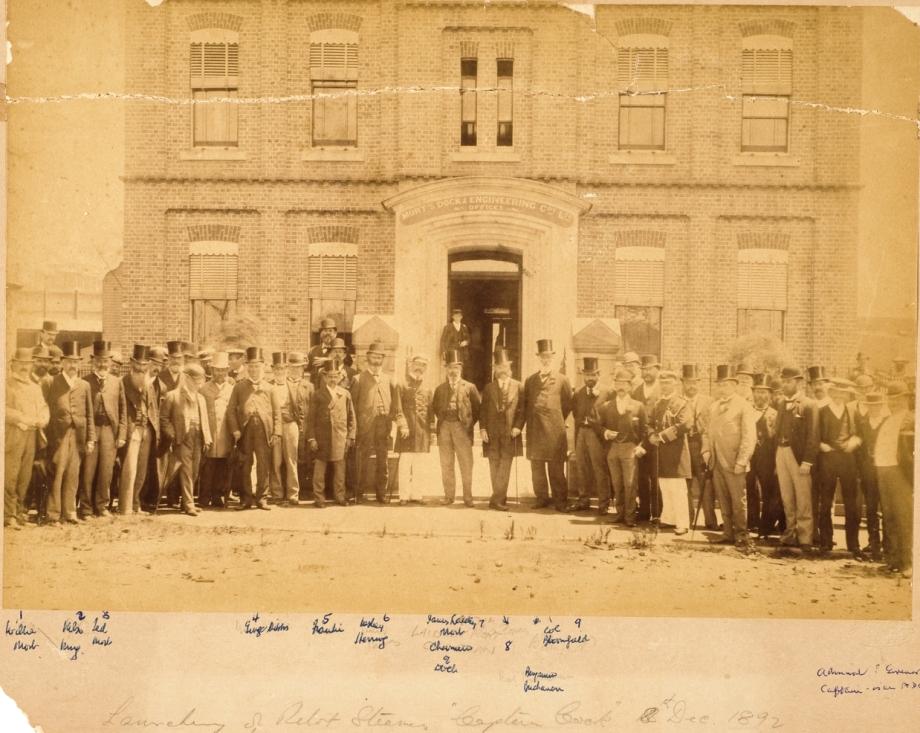
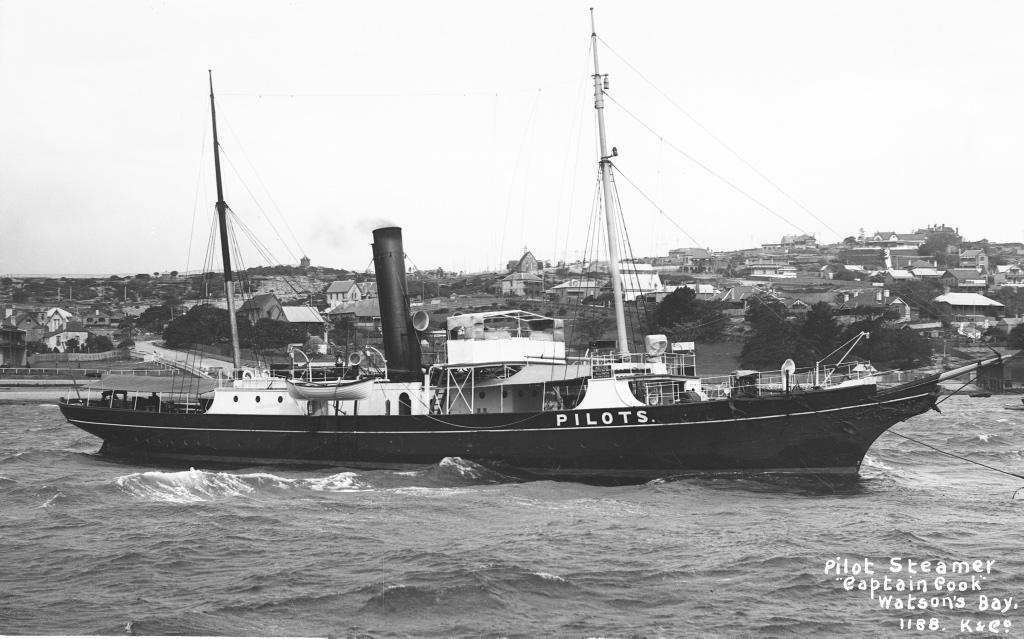
Captain Cook Pilot Vessel - 1900- courtesy State Records of NSW
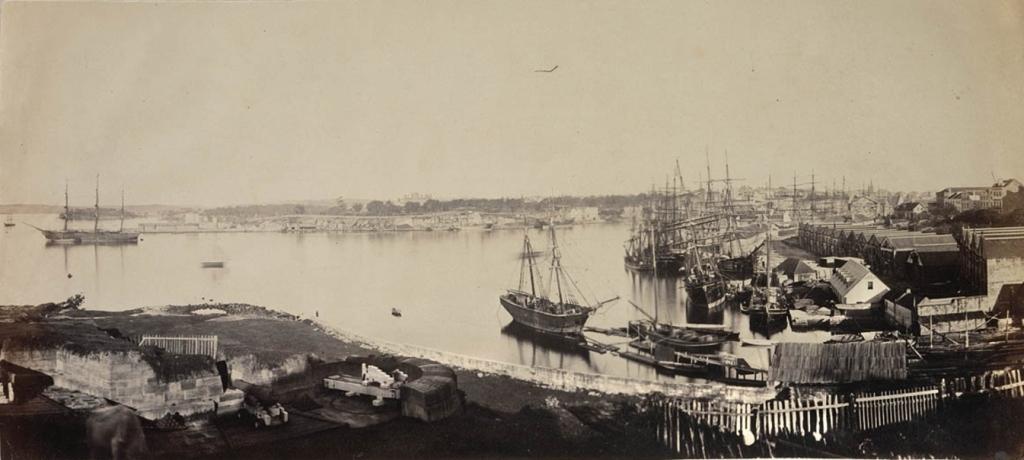
Campbell's Wharf and Sydney Cove from Dawes Point / possibly by Freeman Brothers or Prout - May 1864, Image No.: a128716, courtesy State Library of NSW.
Captain Hixson of Sydney Harbour, the Coastal Waters of New South Wales, Broken Bay and Barrenjoey - threads collected and collated by A J Guesdon, 2015.